#cloud9 hanfu
Explore tagged Tumblr posts
Text
Hanfu in Components: Hanfu Anatomy, Tops (pt 3.1)
navigation: hanfu in components 1 2 3.1 3.2 4 5 6 ...
Now that you know about the names of different garments, what about the parts of each garment? There are so many confusing terms!!! I gotchu :>
When looking at hanfu and parts of hanfu, it can help to see how the garment is constructed. To do that, we have to look at the pattern of the garment. Sewing patterns are the templates that tell sewists how to cut their fabric into the shapes that are needed to make their clothes. Hanfu sewing patterns are fairly standard. They look roughly like this.
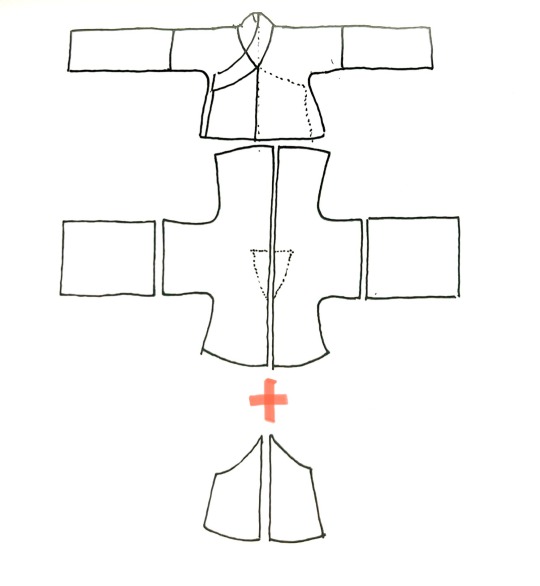
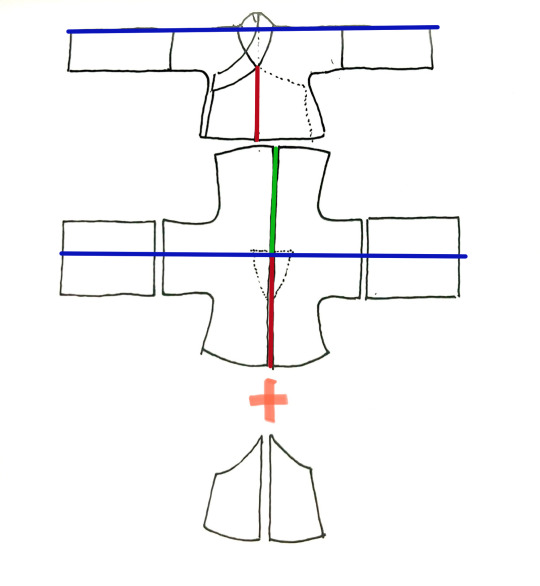
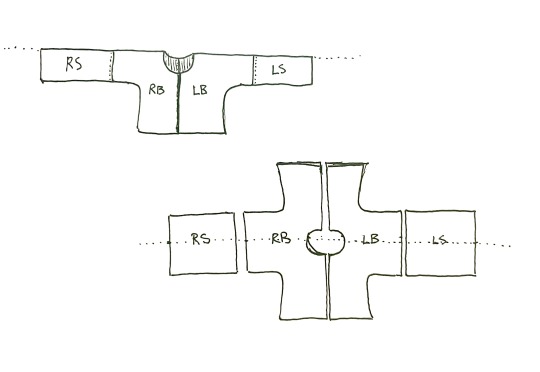
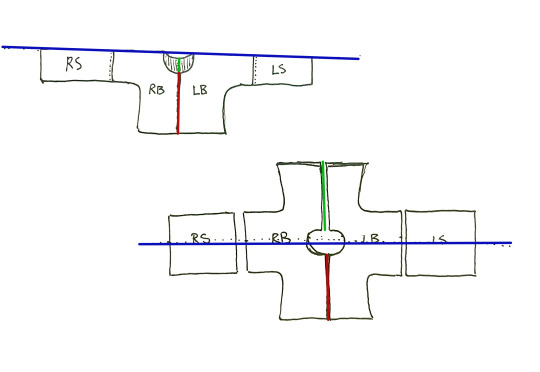
(blue = shoulder fold line // red = center front // green = center back)
To help you understand how this all comes together, when defining different parts of hanfu anatomy, I'll show it on the sketch above, and also on photos of people wearing hanfu, highlighted in green.
身/SHEN1/BODY
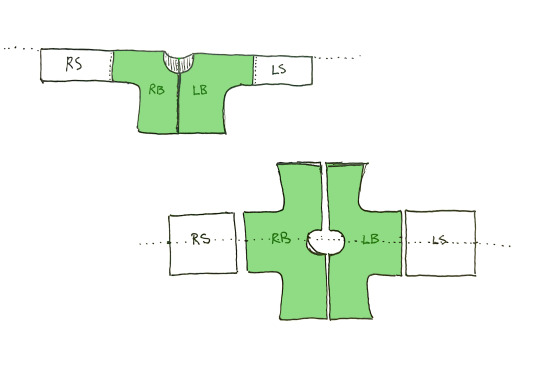
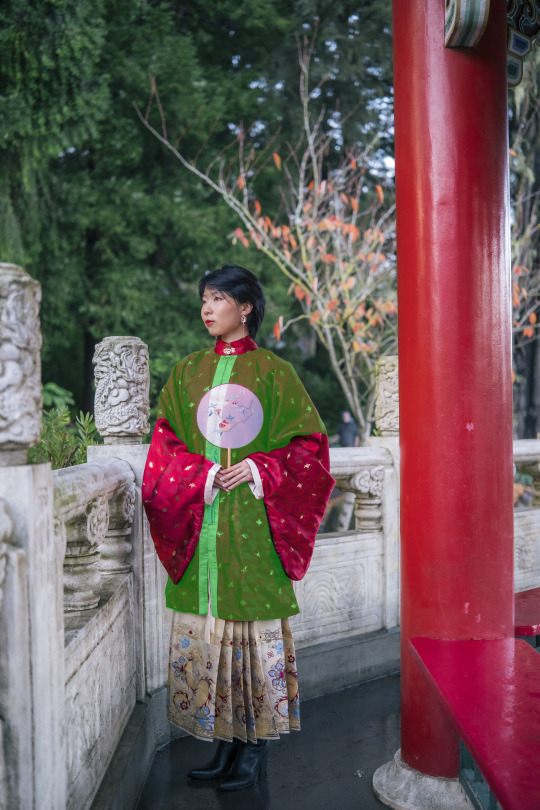
This refers to the body of the garment—the part that would cover your torso. Typically there are two pieces of cloth making up the body: one on the left and one on the right.
Once again, one of hanfu’s main defining characteristics is that traditionally, THE SAME PIECE OF FABRIC MAKES UP THE FRONT AND THE BACK. There is no shoulder seam separating the front and back of the garment.
袖/XIU4/SLEEVE


袖 means sleeve (in both technical and colloquial terms). There are many shapes that the sleeve can take: they can be narrow like normal clothing or they can be big and dramatic like the kind you see in cdramas. Like the body, there is no seam separating the front and back of the sleeve—the sleeve piece is draped over the arm and sewn together at the bottom. Another important characteristic is that the sleeves are joined to the body at the bicep or elbow area, NOT at the shoulder. (Short or half-sleeve tops might not have a separate sleeve piece.)
領/领/LING3/COLLAR
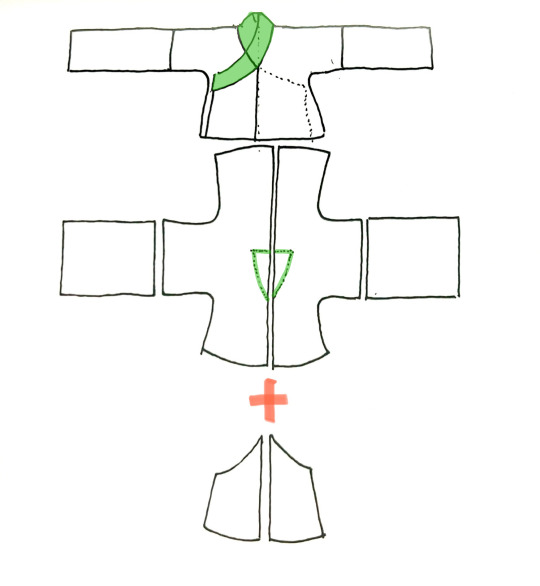
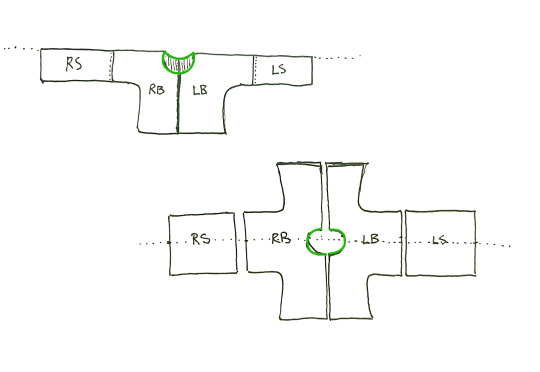

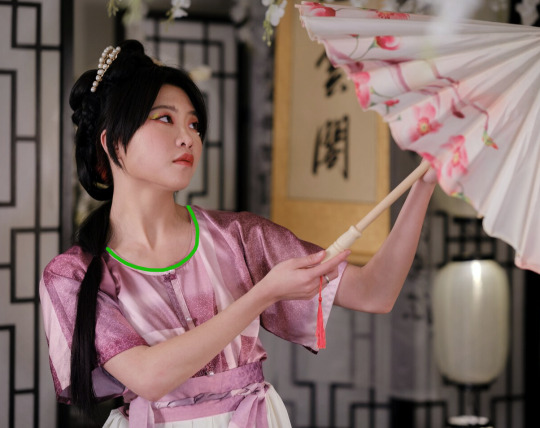
領 means collar (in both technical and colloquial terms). This can refer to two things: one, the general shape of the neck area (round, square, standing, cross etc.) and the actual strip of fabric that is attached at the neck to form the collar.
襟/JIN1/LAPEL
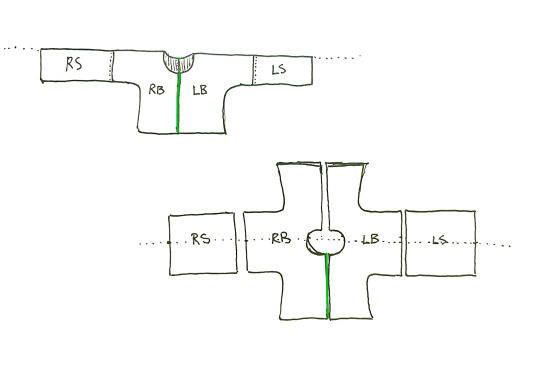
This can be translated as collar or lapel; I choose to say lapel to distinguish it from 領. This refers to the area where an open-front top would open. It’ll look different based on the collar type—generally a 對襟/对襟/dui4 jin1/parallel collar top’s jin coincides with the front centerline.
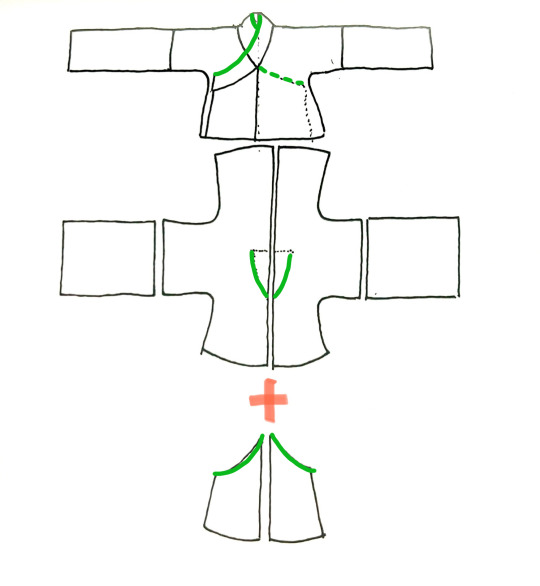
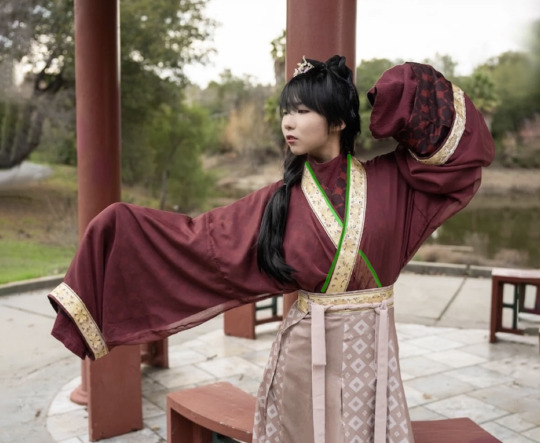
With a 交領/交领/jiao1 ling3/cross-collar top, however, it would coincide with the outer edge of the collar. (Will have a more detailed post about this later.)
下擺/下摆/XIA4 BAI3/HEMLINE
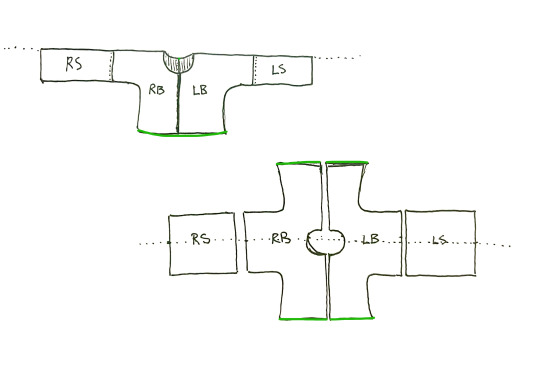

Refers to the bottom hem of the garment. 下 means down/bottom. Note that 擺 can refer to different things in different contexts. If you see someone talk about the 下擺 of a top, they’re talking about this bit.
The following terms only apply to a subsection of hanfu tops and may have fewer images as a result.
衽/REN4/LAPEL EXTENSION
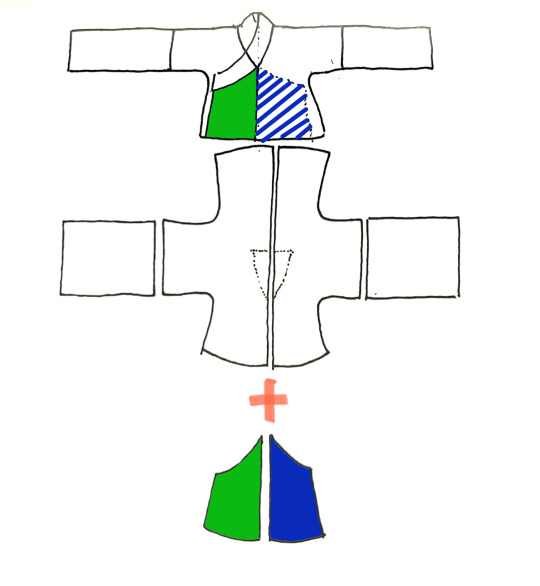

This one is a little harder to translate. Applies to non-parallel lapel tops like cross collar, diagonal-lapel standing collar, and overlapping round collar garments. It’s an extension of the BODY piece on the front, sewn to the vertical center front seam, that overlaps over the other side. (Will have a more detailed post about this later.)
衩/CHA4/VENT
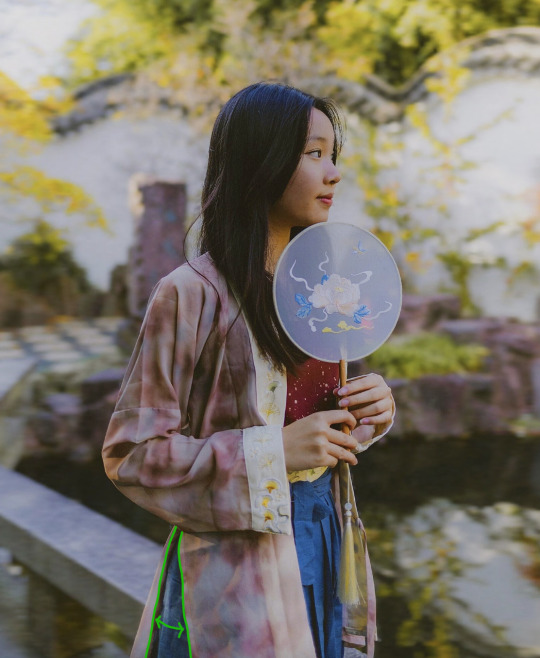

Also called vents or slits—an optional open slit, usually made on each side of a longer shirt or robe, to allow for ease of movement. Might be combined with the word 開/开/kai1/open to form the phrase 開衩/开衩/kai1 cha4/open slit. Mostly applies to longer robes or tops, where the length reaches the knee, so that you don’t have issues with walking.
襴/LAN2/WAIST EXTENSION
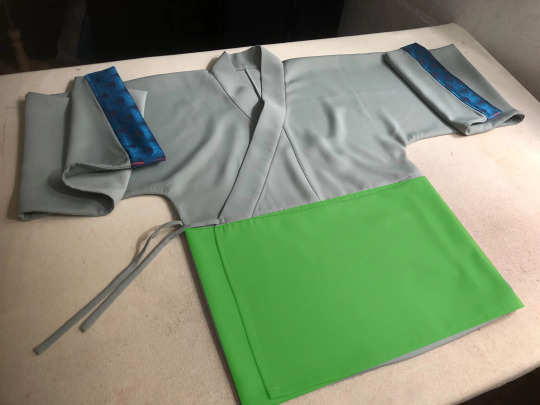
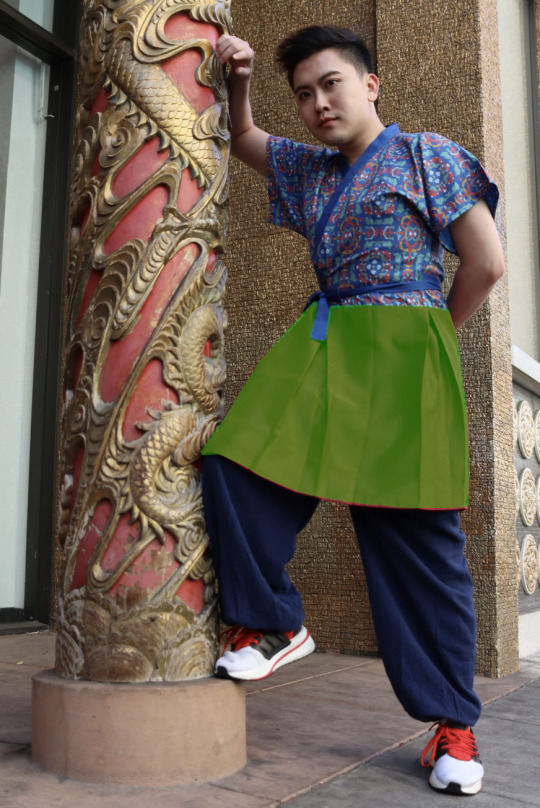
Also a little harder to translate. This only applies to 襦/ru2/Ru tops and 襴衫/襕衫/lan2 shan1/Lanshan robes, plus some varieties that were derived off of those two. The 襴/襕/lan2 is an extra rectangle of fabric appended to the bottom of a shirt/top to extend its length. It can be made of a contrasting fabric or the same fabric, and often has pleats on the sides to allow for movement. (Will have a more detailed post about this later.)
緣/缘/YUAN2/TRIM


Refers to the trim or decorative contrasting bits on a piece of clothing. Specific location goes in front of the character. For example, 袖缘 means sleeve trim, aka the cuff. Some specific trims might have their own special names but that’s for another post.
Later post about skirts/pants to come soon!
navigation: hanfu in components 1 2 3.1 3.2 4 5 6 ...
#hanfu#hanyuansu#chinese hanfu#chinese history#chinese fashion#hanfu photoshoot#hanfu fashion#terminology#reference#chinese#ft tangtang's shitty drawings again#long post#cloud9hanfu#九雲閣#cloud9 hanfu#hanfu in components
355 notes
·
View notes
Text
Hanfu in Components: Structure Conventions (pt2)
navigation: hanfu in components 1 2 3.1 3.2 4 5 6 ...
Thanks for the love on the last post, I’ve been motivated to continue writing LOL Anyway: Construction/sewing pattern/structure is very important to hanfu!
There are a few important structure conventions when it comes to hanfu—almost all traditional-cut hanfu follow these rules; you could call them the defining characteristics of hanfu. There are exceptions to every rule of course (I will go over some caveats at the end of this post), but generally if a hanfu design ignores these rules we might consider it to be ‘incorrect.'
(There will be a longer follow-up pt. 3 post to this explaining the anatomy of a hanfu top/robe, where there will be more detailed in-context illustrations and descriptions. I just figured I should list these ‘rules’ somewhere separately.)
中縫/中缝/zhong1 feng4/Center Seam


Take a look at your shirts. Is there a shoulder seam between the front of the shirt and the back of the shirt? Western clothing tends to consist of a front piece + back piece sewn together to create a space for your body to sit in:

Hanfu doesn’t work like that. Traditionally, the garment isn’t separated into a front piece and back piece: it’s separated into a right piece and left piece, which are joined together at the vertical center seam. Why? Traditional fabric has a narrower width than the standard ~145cm that we have today, so a long, narrow piece is less wasteful to cut out from a bolt of silk than a wide one.

Therefore there is always a center seam, one running vertically down the front and one down the back. 中 = center, 縫 = seam, so 中縫 means center seam. There’ll be a front center seam (前中縫) and a back center seam (後中縫).
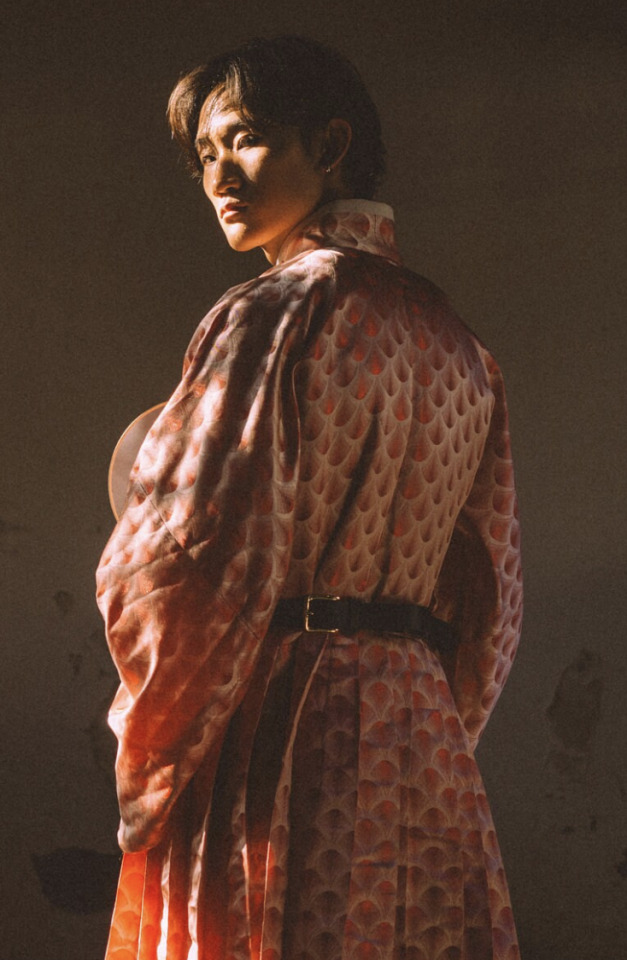
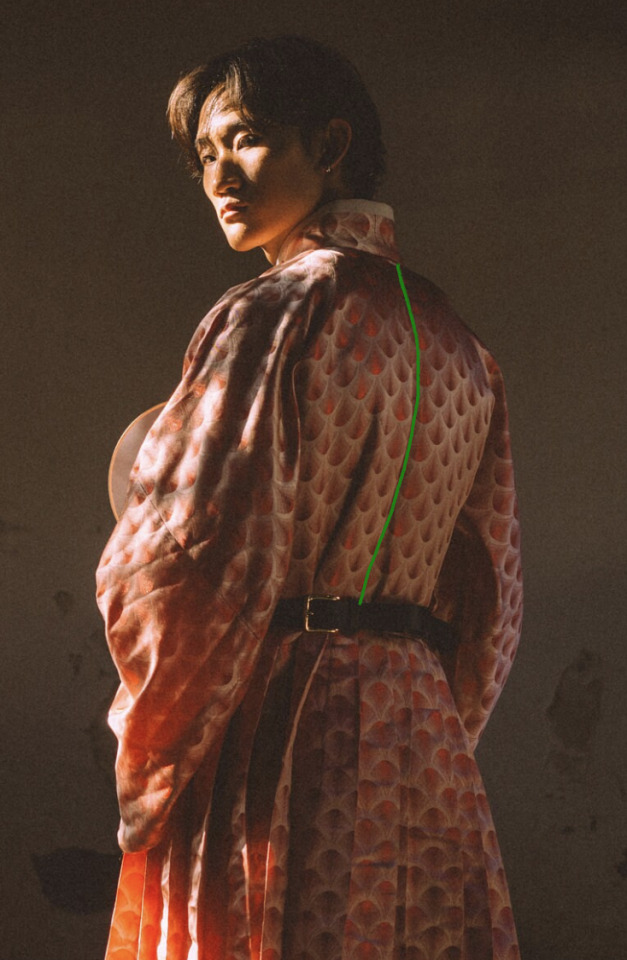
不破肩/不破肩/bu2 po4 jian1/No Broken Shoulder
Kind of an addendum onto the previous point? Additionally since the body pieces are separated into left/right rather front/back, there’s no seam at the top of the shoulder here. The fabric is simply draped over the arm/shoulder to hang down, covering the torso on both sides.*


*Caveat: Some modified hanfu that vendors sell today will have a shoulder seam, especially thicker winter garments or short-sleeved garments. This is a design choice made to prevent the fabric from looking too stiff, known as 破肩/破肩/po4 jian1,literally “broken shoulder.” It can look great, lots of hanfu makers do it! But just to be clear, that is a MODIFICATION.
接袖/接袖/jie1 xiu4/Sleeve Connection
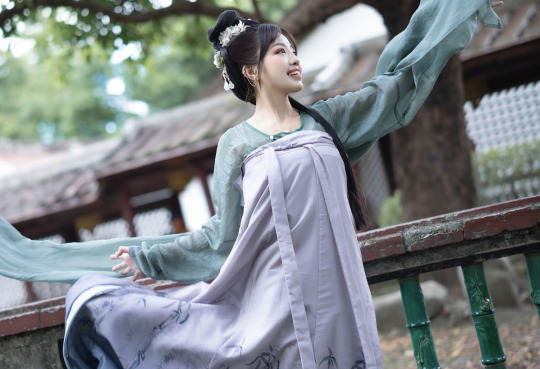
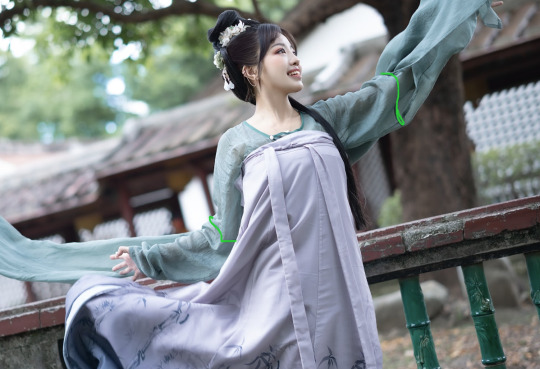
Western clothing patterns tend to have something where the fabric of the sleeve gets connected to the fabric of the garment’s body at the shoulder/armpit, often with a concave arm hole shape to help with the contours of the garment when it’s worn.

Hanfu sleeves, on the other hand, are never connected at the armpit—they are connected halfway down the arm. In other words, the piece of fabric that forms the body extends to also cover the upper arm part of the sleeve. The actual sleeve piece is connected to the body at the bicep/elbow area via a flat seam. (In the case of half- or no- sleeve garments there might just not be a separate sleeve piece.)

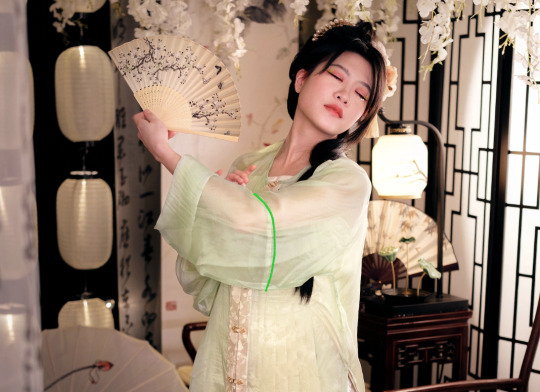
右衽/右衽/you4 ren4/"Right Over Left" Rule
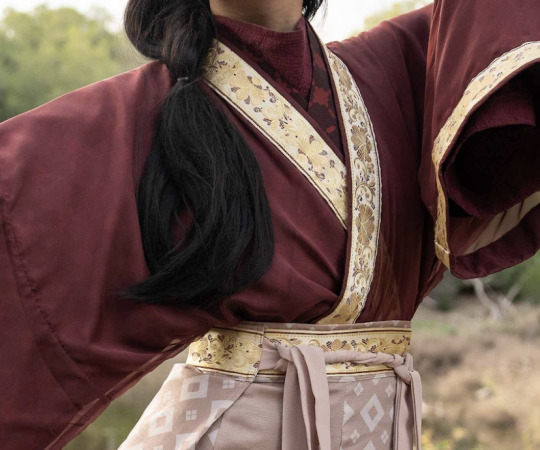
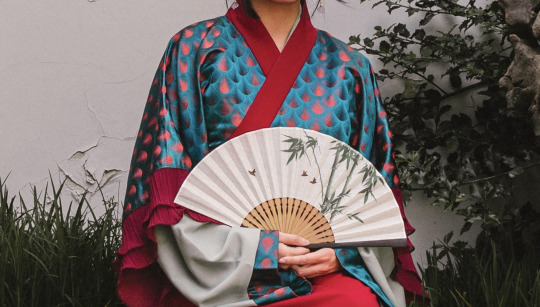
Applies to cross-collar, some varieties of round collar, and some varieties of standing collar tops. In the case that the front of the garment crosses over itself, the flap coming from the wearer’s left goes OVER the flap coming from the wearer’s right. Easiest way to make sense of this is, if you’re looking at someone wearing a cross-collar hanfu top, the cross will look like a lowercase y.

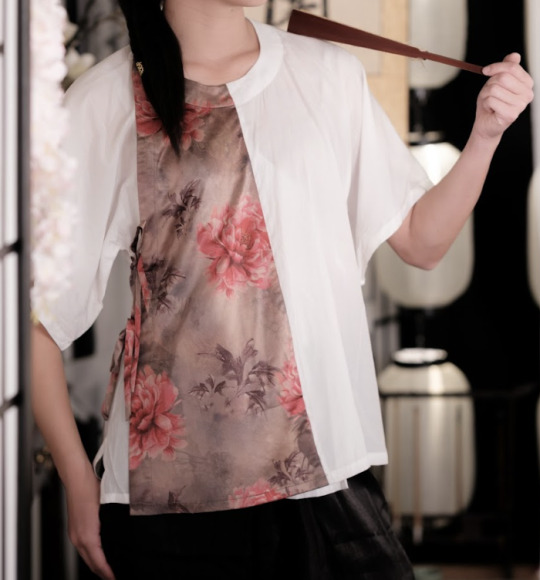
Caveats
NO RULE EXISTS WITHOUT EXCEPTION!!! These rules exist because a majority of hanfu follow them and they are a standard that people agree on right now. However, there are ALWAYS cases—historically or otherwise—where these rules may be broken. For example, there are several Ming Dynasty cross collar robes that happen to be left over right, and the location of the sleeve seam can differ based on what garment you're looking at.
Also, many modern hanfu manufacturers will deliberately choose to break these 'rules' in favor of aesthetics. This is a purposeful design choice—not one that's done out of ignorance or disrespect. It's easy for common modifications to get mistaken for 'historically accurate.' To be clear, it is 100% okay and super common for modifications to exist! Just don't go around claiming that it was historically that way.
My advice is that if you're starting out with hanfu, try to stick to these rules in the back of your head as closely as possible. Once you've built your foundational knowledge, then you can start exploring the exceptions to the rules. These rules may not be foolproof, but they are a useful tool to help you understand the commonalities and trends within hanfu without overwhelming you.
Last note: it is generally more of a taboo for seams that should exist to not exist in a piece of clothing (i.e. no center back seam) than for extra seams to exist. If you go look in museums for the artifacts that hanfu is based off of, you'll notice that a lot of them—especially the ones from earlier dynasties—are a chaotic patchwork of a bunch of random piece of fabric sewn together to create the garment. Fabric is expensive, people don't want to waste it! So it's not all that weird to have seams in random places.
Happy 除夕 everyone! 有蛇有得 :>
navigation: hanfu in components 1 2 3.1 3.2 4 5 6 ...
#hanfu#hanyuansu#terminology#once again idk how to tag#avoiding my homework#hanfu fashion#chinese fashion#chinese history#chinese language#im all alone on new years eve ;-;#my due dates are keeping me company its ok#shitty drawings by tangtang#chinese hanfu#fashion#hanfu photoshoot#hanfu art#cloud9hanfu#cloud9 hanfu#九雲閣#hanfu in components
314 notes
·
View notes
Text
Hanfu in Components: General Garment Terms (pt1)
navigation: hanfu in components 1 2 3.1 3.2 4 5 6 ...
Attempting to sort of reboot the hanfu in components thing I wrote for Newhanfu a while back in a better organized way, so I guess this is a series? Purpose is to provide a more systematic way for people to learn about hanfu terminology, which is extremely complicated and constantly changing, but has mostly settled into some agreed upon definitions among the hanfu community.
Note: This is probably going to make the most sense for people who have already been interested in hanfu for a little while but don't know the technical terms for what they're seeing in the pretty pictures. If you're just starting out this might be a little overwhelming, especially since hanfu vernacular has variations based on what time period you're talking about and stuff like that! But of course feel free to look at it anyway :>
Here are terms that you'll see a lot when referring to a general type of garment. These are the equivalents to 'shirt,' 'skirt,' 'pants' etc. in English, where it's telling you broadly what kind of a garment it is, but not really any details about its style or what it might look like. I will structure my definition headers as (traditional character)/(simplified character)/(pinyin)(tone) going forward. Also using images from Cloud9 as much as I can bc I don't wanna deal with citing image sources lol, shoutout to our models
WORDS ACTUALLY JUST MEANING "CLOTHING"
衣/衣/yi1 - General term for clothing. More often than not refers to a top/shirt or a robe, but can refer to clothing in general as well, especially in modern usage. The yi radical looks like this: "衤" Basically if a character has that symbol on the left, it’s probably related to clothing in some way.
服/服/fu2 - Also a general term for clothing. Slightly more formal/technical in tone imo. Usually combined with 衣 for 衣服 (more casual everyday way of saying clothing) or with 裝 for 服裝 (more formal way of saying clothing). Think the difference in tone between ‘clothes’ vs. ‘attire.’
TOPS (the clothing kind) & ROBES


衫/衫/shan1 - Shirt, unlined. Refers to a shirt/blouse in modern usage. Within hanfu, refers to a top (usually short, but sometimes long) that is unlined.


襖/袄/ao3 - Jacket/lined top. Refers to a parka-style jacket in modern usage (棉襖). Within hanfu, refers to a top that is lined, typically on the thicker side. Can be long or short. More often than not it is worn as an outer layer.
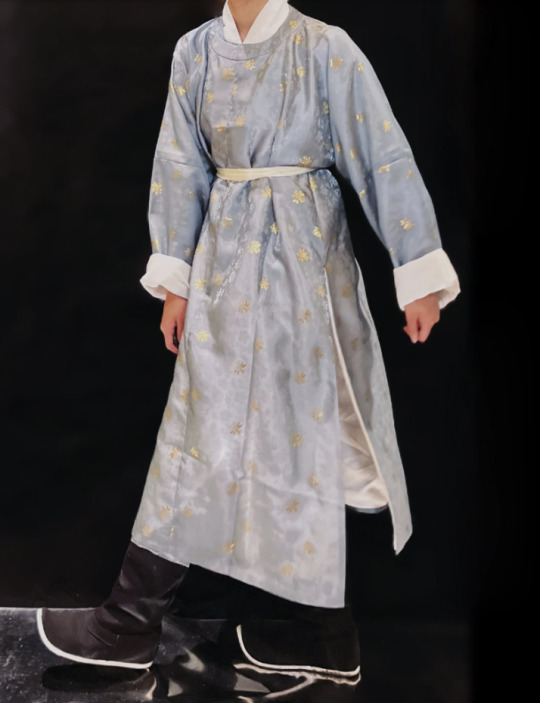
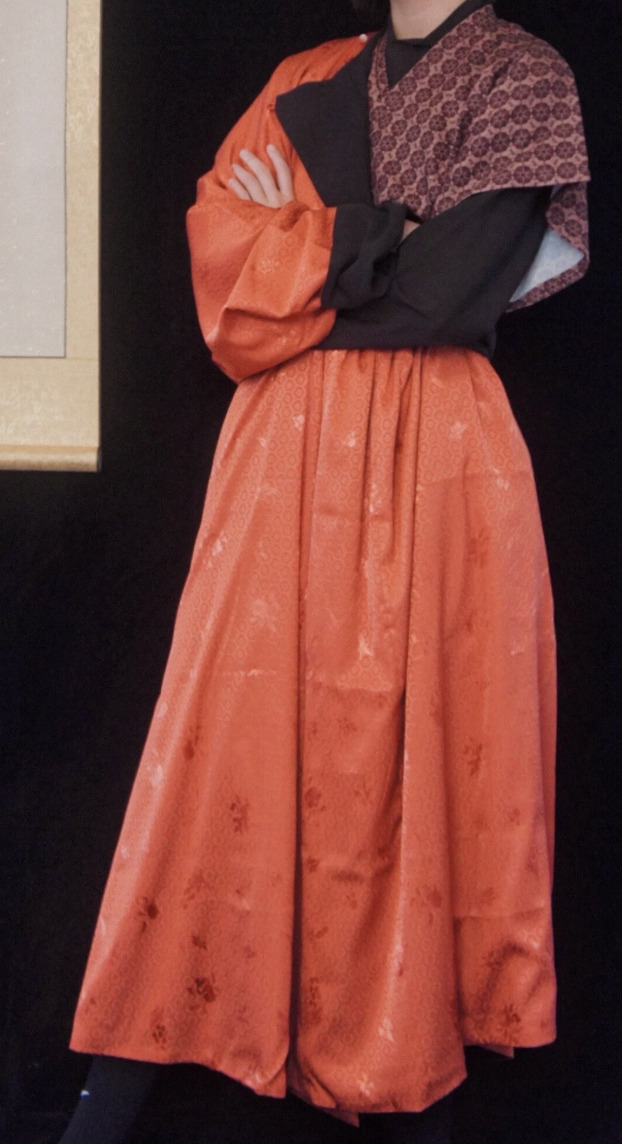
袍/袍/pao2 - Robe. Refers to a top whose length extends past the knee. Usually robes are lined, but that’s not a requirement to be considered a robe. There is overlap with 衫/襖; aka a garment can be both a 袍 and a 衫 (long unlined robe) or a 袍 and an 襖 (lined robe), but not an 襖 and a 衫 (somehow lined and unlined at the same time, disobeys the laws of physics and logic, possibly quantum entity).

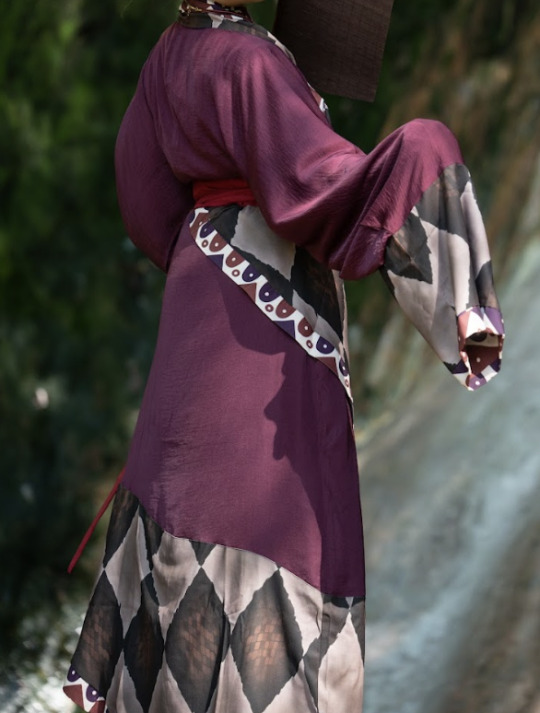
深衣/深衣/shen1 yi1 - Literally ’deep clothing,’ also can be translated as robe, but more specific in that shenyi will typically be made up of a ‘top part’ and a ‘skirt part’ that are sewn together at the waist, rather than just being a really long top.
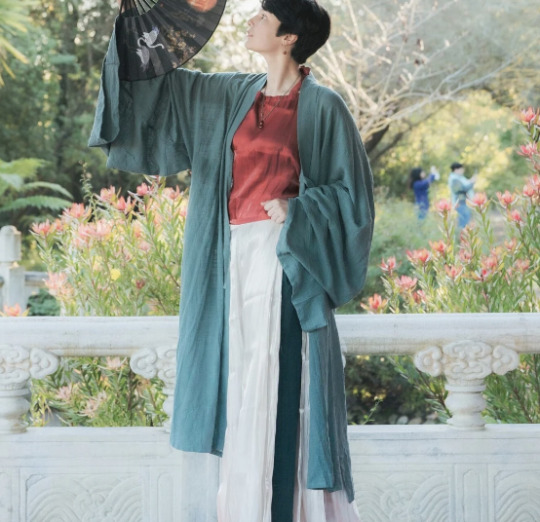
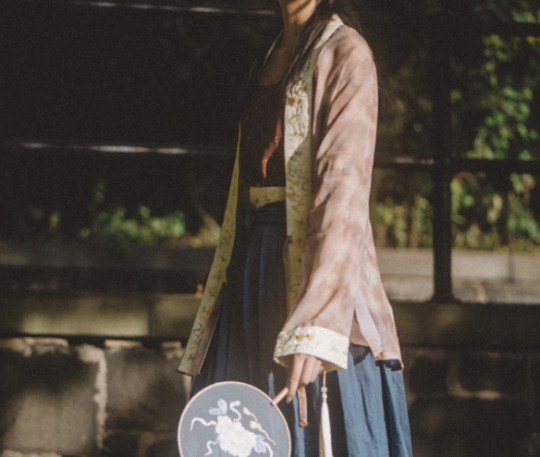
褙子/褙子/bei4 zi0 - Outer layer. Harder to define because it can refer to very different things depending on what dynasty you’re looking at. General rule though, it’s almost always an outer layer on a woman’s outfit.
BOTTOMS (the clothing kind)


裙/裙/qun2 - Skirt. Generally any garment that wraps around a person’s torso and covers the legs.


褲/裤/ku4 - Pants/trousers. Similar to skirt except there are dedicated channels for each leg, aka there’s some separation happening at the crotch. Can be open or closed crotch, almost always worn under a skirt or robe.
Obviously there's a lot of other terms too but I'll get to them with time! Still a full time student, still learning about hanfu, blah blah blah. But yeah especially the more specific terms I will probably cover in a later post. Hope this is interesting enough for now :>
navigation: hanfu in components 1 2 3.1 3.2 4 5 6 ...
#hanfu#hanfu fashion#hanfu photoshoot#hanyuansu#chinese hanfu#chinese history#cloud9hanfu#chinese fashion#cloud9 hanfu#九雲閣#hanfu in components
377 notes
·
View notes
Text
Hanfu in Components: Sleeve Shapes (pt5)
navigation: hanfu in components 1 2 3.1 3.2 4 5 6 ...
Review on sleeve structure (接袖/jie1 xiu4/sleeve connection) from part 2, structure conventions:
"Hanfu sleeves, on the other hand, are never connected at the armpit—they are connected halfway down the arm. In other words, the piece of fabric that forms the body extends to also cover the upper arm part of the sleeve. The actual sleeve piece is connected to the body at the bicep/elbow area via a flat seam. (In the case of half- or no- sleeve garments there might just not be a separate sleeve piece.)"
Sleeve pieces are also draped over the shoulder with no shoulder piece. Most sleeve shapes fall very roughly into the categories of小袖/xiao3 xiu4/'Small Sleeve' or 大袖/da4 xiu4/'Large Sleeve' types, though this can vary, and some sleeve shapes can be regarded as kind of a middle size, but there are so many ways to categorize them (size? Popularity? Chronology?), so here they are in no particular order.
I'm not gonna use pictures of clothing on people with this one, mostly because the shape is really hard to discern when the fabric draped and folds as hanfu is wont to do. Instead you get my shitty handwriting and graph paper drawings. Sorry.
直袖 / ZHI2 XIU4 / STRAIGHT SLEEVE

Very basic straight sleeve. It's a rectangle. Usually narrow (30-10cm wide in my experience in the industry), but there are also straight sleeves that are super wide (Famensi pishan, various Song beizi). The main requirement is that the bottom sleeve seam is parallel to the shoulder line. Pretty much timeless.
窄袖 / ZHAI3 XIU4 / NARROW SLEEVE

Synonymous with 箭袖 / jian4 xiu4 / 'Arrow Sleeve.' Very similar to a straight sleeve, but the sleeve cuff is slightly narrower than the root, so the line made by the sleeve seam is slightly tilted rather than straight across. The cuff is usually between 20-10cm wide, and the root is usually under 30cm. If the cuff is more than twice the width of the root I would be more inclined to call it a feijixiu (see below), but there's some overlap between these categories. Also pretty much timeless, usually used for inner layers or dailywear.
More specific names may describe variations of narrow sleeves like 羊腿袖/yang2 tui3 xiu4/sheep's leg sleeve from the Song dynasty, a super-narrow form-fitted narrow sleeve.
飛機袖 / FEI1 JI1 XIU4 / AIRPLANE SLEEVE

Can be considered a type of 窄袖, with a straight but diagonal sleeve hem. The cuff is typically about half the width of the root; the root is usually at least 25cm wide in my experience. 'Airplane sleeve' is a modern colloquialism that became popular because the sleeve's shape looks like an airplane wing.
This is very specific to Song Dynasty women's wear (and Yuan Dynasty women's wear, if you consider Yuan Dynasty hanfu). The artifact directly supporting this sleeve shape is the Huangshengmu zhaixiu duanshan.
垂胡袖 / CHUI2 HU2 XIU4 / DROOPING SLEEVE

Mid-width sleeve usually characteristic of the earlier dynasties, from the earliest times up to the Wei/Jin dynasties. Characterized by a fairly wide sleeve root and a narrower sleeve cuff, with a curved belly-like shape. The midpoint of the sleeve may or may not briefly widen beyond the width of the root before narrowing back down at the cuff, giving it a 'drooping' appearance.
廣袖 / GUANG3 XIU4 / VAST SLEEVE

Catch-all term for extremely wide-cuffed sleeves, commonly known as 大袖/da4 xiu4/large sleeve. Usually has a root of at least 30cm and a sleeve opening of 60-120cm. Present throughout most dynasties in different forms, most often as formal outerwear (大袖衫)in the Tang, Song, and Ming Dynasties. The shape connecting the
Most guangxiu from the Ming Dynasty are 廣袖收祛/guang3 xiu4 shou1 qv1/closed vast sleeves, meaning that the front of the sleeve is closed, sewn up to a small opening for the wrist to come through.
窄臂大袖 / ZHAI3 BI4 DA4 XIU4 / NARROW-ARM LARGE SLEEVE

Mostly specific to the Northern & Southern Dynasties, though I've seen a couple Tang figurines with similar silhouettes. Has a fitted sleeve root typically under 30cm, sometimes as narrow as 15-20cm, that opens up after the elbow to a wide 60-120cm sleeve opening.
琵琶袖 / PI2 PA2 XIU4 / PIPA SLEEVE

Mostly specific to the Ming Dynasty, an iconic sleeve shape named for its resemblance to the shape of a Pipa instrument, a plucked string instrument sort of like a lute. The sleeve root is normally between 30-45cm, opening up slightly to a maximum width of between 35-65cm, and then curving smoothly back up to a sleeve cuff normally between 10-25cm. Can vary wildly in size—there are 'small' pipa sleeves and 'large' pipa sleeves, with the large ones normally being part of formal outerwear.
弓袋袖 / GONG1 DAI4 XIU4 / QUIVER SLEEVE

Also mostly specific to the Ming Dynasty, can be considered a Pipa sleeve that doesn't widen far beyond the sleeve root, instead curving back up gently towards the sleeve cuff. Sometimes there's a pleat made at the root of the sleeve to help with movement. Often seen as a more convenient alternative to the Pipa sleeve. The quiver here is referring to the bag you put arrows in (not the movement 'quivering') because the shape looks similar.
半袖 / BAN4 XIU4 / HALF SLEEVE
The name 'half-sleeve' is actually fairly misleading, because most 'half-sleeve' garments are either closer to 1/3 sleeve or 3/4 sleeves. The important thing to remember is that short sleeve garments are almost always outerwear—with some exceptions (Tang mens banbi for example) they're usually meant to be worn over a long-sleeved inner layer. Ming Dynasty half-sleeves tend to be closer to 3/4 sleeves, some reaching almost to the wrist, but because long-sleeved Ming Dynasty garments often extend past the fingertips by a significant amount, you still get a decent amount of layering.

Half-sleeves may or may not have a 接袖/jie1 xiu4/sleeve connection piece; the sleeve may just extend out from the main body piece if the fabric width allows for it. They may be curved or linear, slightly flared (as with garments worn over pipa sleeves for example) or straight across.
無袖 / WU4 XIU4 / SLEEVELESS
Why stop at reducing sleeve length—get rid of them completely! Almost every dynasty has their own vest-like garment, whether it's the Ming Dynasty's 比甲/bi2 jia3, the Song Dynasty's 背心/bei4 xin1, or the Tang Dynasty's 唐褙子/tang2 bei4 zi0. Some may have a very small sleeve connection piece to extend the shoulder line outwards. Having a curved arm opening with a narrow shoulder width is very uncommon before the Qing Dynasty but not completely unheard of.

Note: Sleeve Construction
Just so you can see how these pieces actually look in the context of hanfu construction: this is fairly similar to how modern sleeves are made. The sleeve piece is just a mirrored double of how the sleeve looks from the front, you cut the whole thing out, drape it over the shoulder and then sew the bottom together.



Ok I procrastinated on this post for weeks but it is finally done!!! There are definitely some sleeve shapes that I didn't list out here, but most other shapes can be described as variations on the most common ones. Shoot me an ask if there's a sleeve shape that you really want to know about and I'll add it, or if you're having trouble identifying one :)
navigation: hanfu in components 1 2 3.1 3.2 4 5 6 ...
#hanfu#chinese fashion#chinese hanfu#hanyuansu#hanfu fashion#hanfu photoshoot#chinese history#chinese#cloud9 hanfu#cloud9hanfu#九雲閣#hanfu in components#ft tangtang's shitty drawings again#ive returned from the dead#hanfu art#long post#not that long compared to the other ones tbh
179 notes
·
View notes
Text
Hanfu in Components: Hanfu Anatomy, Skirts & Pants (pt 3.2)
navigation: hanfu in components 1 2 3.1 3.2 4 5 6 ...
More anatomy terminology things as promised :0000 There are lots of different kinds of skirts and pants, but in general they all wrap around your waist or chest and are secured by some kind of tie. They're usually much simpler than the tops.
裙頭/裙头/QUN2 TOU2/SKIRT HEAD


Same thing as waistband, applies to pants and skirt. We call it a “head” because it’s at the top of the garment and the body of it follows. This can vary in width depending on whether you’re looking at a standard waist-high skirt or a 訶子裙/诃子裙/he1 zi0 qun2/Hezi style skirt-dress, which has a very wide skirt head that looks more like the bodice of a strapless dress.


The horizontal length is usually made to be approximately 1.5x the waist measurement of the wearer to allow for ample overlap when wrapped around the waist. Might be called 褲頭/裤头/ku4 tou2/pants head for pants or 腰頭/��头/yao1 tou2/waist head in general.
繫帶/系带/XI4 DAI4/RIBBON
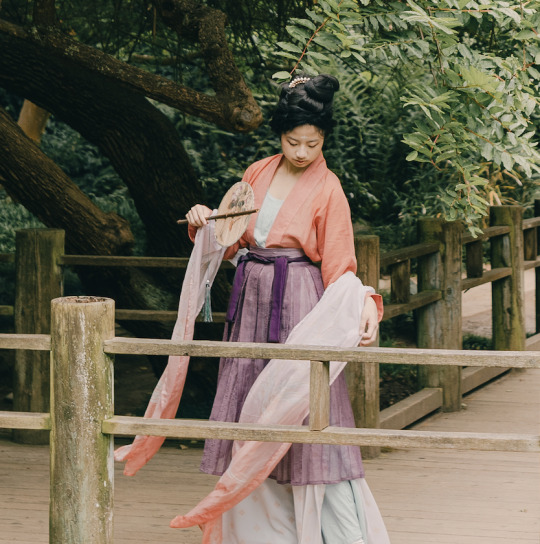
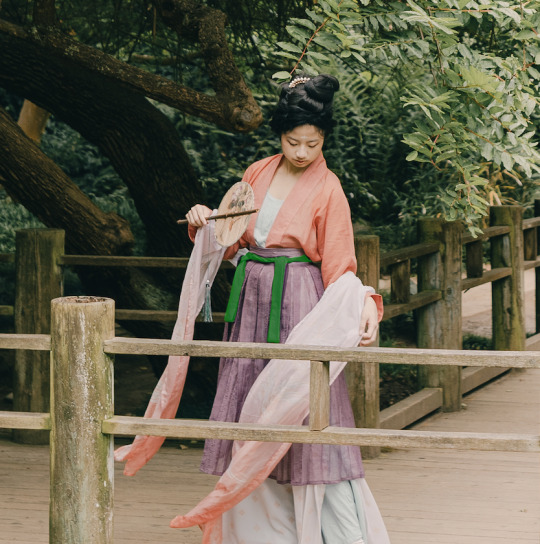
Usually translated as a ribbon or tie, two long ribbons each attached on one end of the skirt head so that you can secure the garment around your body. Some styles will also have one long ribbon come separately from the skirt itself and instead attach loops on either side of the skirt head that the ribbon goes through, but this style is less common nowadays. Some styles will also have four small ties rather than two large ones.
孔/KONG3/HOLE


A slot made in the skirt head to pass the tie/ribbon that’s stuck on the inside through to the outside. This is a modification from the traditional cut of hanfu, but it has become so ubiquitous that it’s practically the standard now.
肩带/JIAN1 DAI4/SHOULDER STRAPS


Applies to 齊胸/齐胸/qi2 xiong1/chest-high skirts. Shoulder straps can be sewn on or removable and attached via a hook and loop.
擺/摆/BAI3/‘SWING’


Can refer to different things based on context. 下擺 Refers to the bottom hemline of the garment, with 下 meaning down/bottom. 擺 alone literally means ‘swing’ or ‘swish.’ When used alone or combined with 裙 for 裙擺, it’s referring to how much fabric has been used in the body of the skirt, measured by the stretched-out unpleated total length of the hemline. The lightest skirts have a 3-meter bai, with 4.5m and 6m also being standard.
褶/ZHE2,3/PLEAT
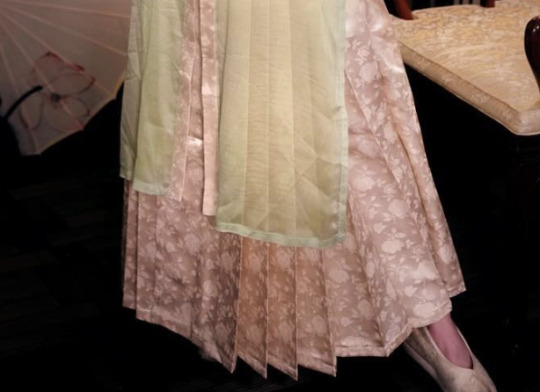
Fold or pleat. Almost all hanfu skirts have either 順褶/顺褶/shun4 zhe2,3/knife pleats or 工字褶/gong1 zi4 zhe2,3/box pleats. Sometimes also written as 折, which is pronounced the same way meaning 'fold,' but usually this refers to a crease in paper or the action of folding something rather than a pleat. Pronunciation caveat: zhe2 is standard in Taiwan, zhe3 is standard in China.
裙門/裙门/QUN2 MEN2/SKIRT DOOR


Applies to Ming Dynasty 馬面裙/马面裙/ma3 mian4 qun2/horse-faced skirt. Smooth unpleated face of a skirt. Similar to the 光面 of Song Dynasty baidiequn.
光面/GUANG1 MIAN4/EMPTY FACE


Applies to Song Dynasty 百迭裙/bai3 die2 qun2/hundred-layer skirt. Smooth unpleated face of a skirt. Apologies for the bad picture, this one is made of linen and the boundaries between the pleats are lowkey really hard to see x-x
破/PO4/PANEL

Applies to 破裙/po4 qun2/‘broken skirt.’ 破 means broken, colloquially; when referring to the 破 of a skirt you are referring to one of the trapezoidal or rectangular panels of the skirt.
襠/裆/DANG1/CROTCH


Crotch area of pants. Pants can usually be classified as either 開襠/开裆/kai1 dang1/open-crotch or 合襠/合裆/he2 dang1/closed-crotch.
navigation: hanfu in components 1 2 3.1 3.2 4 5 6 ...
#hanfu#hanyuansu#chinese fashion#chinese hanfu#chinese history#hanfu fashion#hanfu photoshoot#chinese#terminology#reference#long post#cloud9hanfu#cloud9 hanfu#九雲閣#hanfu in components
182 notes
·
View notes
Text
Hanfu in Components: Collars & Lapels (pt4)
navigation: hanfu in components 1 2 3.1 3.2 4 5 6 ...
Back to technical infodumping... Also caved and used tb images in this one LOL sources all linked of course!
I will now be going over different collar/lapel shapes often seen in hanfu! The collar and lapel are combined because they're connected ideas, so you can't really get an idea of what the front of the garment looks like unless you know both. There are so many different axes that you could use to sort these into categories (by dynasty, by collar, by lapel, by name, etc). I'm going to use the system that I think will make the most sense to people trying to get a sense of how stuff is constructed. This might differ from the system that most other informational articles use.
Terminology refresher:
領/领/ling3 - Collar (neck part)
襟/jin1 - Lapel (front of garment, where it 'opens')
I like to separate these into two broad lapel categories, which have a couple subcategories themselves. They are:
對襟/对襟/dui4 jin1/'parallel lapel'
大襟/da4 jin1/'grand lapel'
對襟 Parallel Lapel
Duijin garments usually have an open center front seam that gets secured to the opposite side with ties or buttons. The lapels are straight parallel lines. A shape may or may not be cut out at the neck.
直領/直领/zhi2 ling3/Straight Collar

月餅 / Yuebing / Mooncake by 九雲閣 Cloud9 Hanfu on Etsy (see alt text for photo credits)
This is the simplest kind of collar. There is no extra shape carved out for the neck at the top of the garment, the lapels extend straight down from the midline. The result is an open-front parallel collar cardigan, which is almost always worn on the outside. The collar piece is simply a very long strip of fabric attached to the empty edges like this. There may or may not be a small gap at the back of the neck to allow space for the width of the neck.

寒翠 / Hancui / Evergreen by 九雲閣 Cloud9 Hanfu on Etsy
There are a few variations to the collar piece. The simplest one shown is called 通領/通领/tong1 ling3/Through Collar, where it’s just one strip of fabric all the way around. If a garment is referred to as just 對襟 with no extra indicated collar shape, this is the collar type that it's referring to.
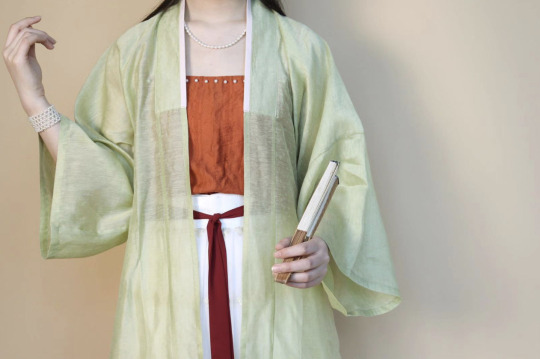
萦波 from 裳裳者华 on Taobao
折領/折领/zhe2 ling3/Folded Collar, primarily a Song dynasty thing, has the top half or so double-folded inwards to create a more reinforced neck area.

Custom order by 九雲閣 Cloud9 Hanfu on Etsy
合領/合领/he2 ling3/Joined Collar, a Ming dynasty structure, has a thicker collar piece that only runs halfway down the length of the garment, and usually has no gap on the back of the neck.
圓領/圆领/yuan2 ling3/Round Collar

金通缠枝莲 from 松塔汉服 on Taobao
Round collars are fairly similar to modern-day round collars, except they are typically wider and lower than a tshirt. A large half-circle is cut out at the neck. The collar piece has two variations: the thicker full collar piece, which has more of a presence and the narrower 無領/无领/wu2 ling3/Missing Collar variation, which just encloses the circle’s edges with ~1cm of bias tape.

山染黛 / Shanrandai / Sierra by 九雲閣 Cloud9 Hanfu on Etsy
Both of these almost exclusively apply to Ming Dynasty wear.
方領/方领/fang1 ling3/Square Collar
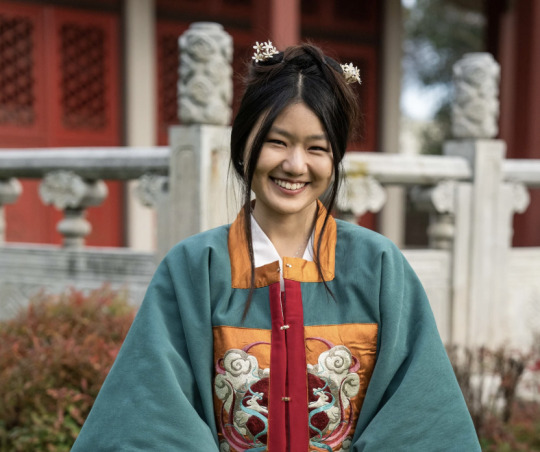
迎春 / Yingchun / Salutation by 九雲閣 Cloud9 Hanfu on Etsy (see alt text for photo credits)
Square collars are usually more of a rectangular or trapezoidal shape. Almost exclusively applies to Ming Dynasty outerwear.
坦領/坦领/tan3 ling3/Open Collar
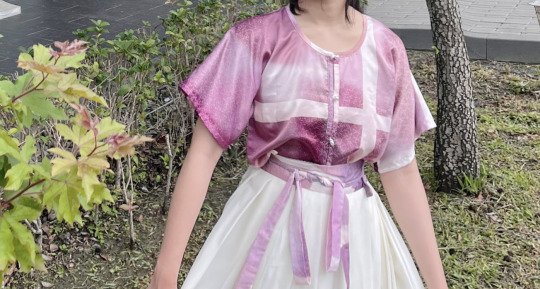
落夢 / Luomeng / Daydream by 九雲閣 Cloud9 Hanfu on Etsy (see alt text for photo credits)
Also called the U-領. A wide scooping neckline in a U-shape often found in Tang Dynasty womenswear.
立領 /立领/li4 ling3/Standing Collar
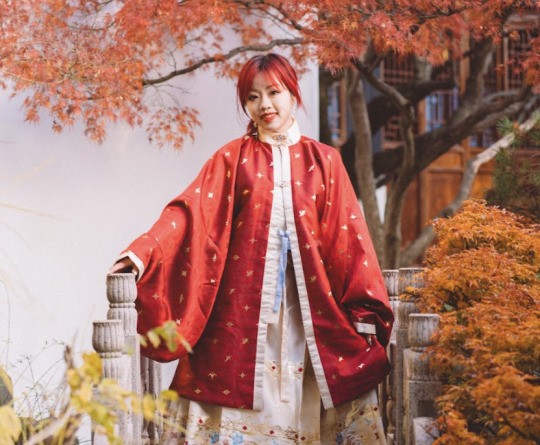
雲化龍 / Yunhualong / Seraphine by 九雲閣 Cloud9 Hanfu on Etsy (see alt text for photo credits)
Synonymous with 豎領/竖领/shu4 ling3. Standing collar, a long collar piece that wraps around the neck, usually secured in the front with ties or small buttons.
雞心領/鸡心领/ji1 xin1 ling3/Heart Neckline

升天行 / Shengtianxing / Hesperus by 九雲閣 Cloud9 Hanfu on Etsy
Reverse heart-shaped neckline, can be considered a variant of the 坦領 where the center of the collar protrudes upwards to a point. Also Tang Dynasty womenswear.
Y領/Y领/Y ling3/Y-Collar
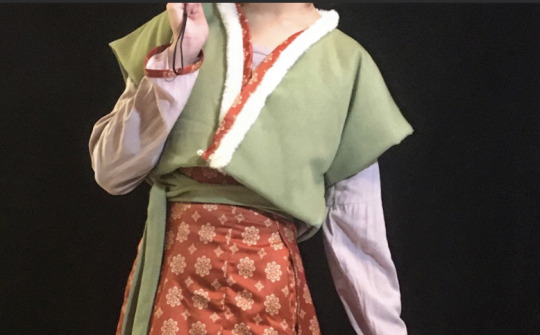
立春遊 / Lichunyou / Spring Thaw by 九雲閣 Cloud9 Hanfu on Etsy (see alt text for photo credits)
Can be considered a variant of the 直領 or its own thing. Y-shaped neckline with a triangle cut out at the top, meeting halfway down. Also Tang Dynasty womenswear.
大襟/da4 jin1/Grand Lapel
Also referred to as 交襟/jiao1 jin1/Crossed Lapel, grand lapel-type collars usually have a 衽 piece attached to the center front seam to span the whole width of the torso, overlapping in the front. This is a term that's usually used for Ming Dynasty clothing, for which there is a 大襟 and 對襟 version of each of 直領,立領,and 圓領.
交領/交领/jiao1 ling3/Cross Collar

曉風青 / Xiaofengqing / Cardinal by 九雲閣 Cloud9 Hanfu on Etsy (see alt text for photo credits)
Cross-collar, one of the most iconic features of East Asian clothing. There are a ton of ways that the cross-collar can be constructed, varying across time.
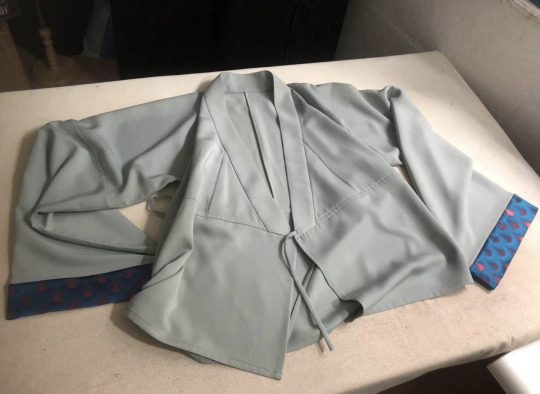
月將沉 / Yuejiangchen / Moonset by 九雲閣 Cloud9 Hanfu on Etsy
The classic symmetrical 交領 from the earliest dynasties can be understood as a Y-shaped cutout with a triangular or trapezoidal 衽 sewn onto each center front seam to bridge the distance. Some also do away with the center front seam (but never the center back) and make the torso and the 衽 one piece together. The amount of overlap can vary.

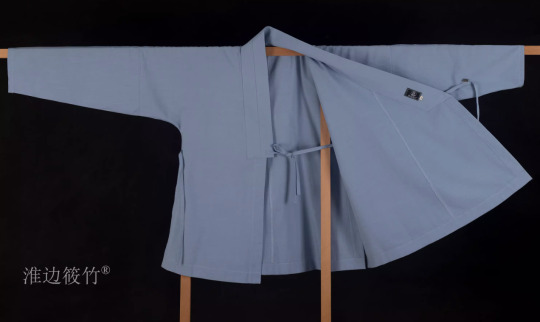
横卧交领长袖短衫 from 淮边筱竹 on Taobao
Cross collars can also be asymmetrical, especially in the Ming Dynasty: the 直領大襟 example can be understood as a straight collar on the wearer’s right and a cross collar on the wearer’s left. There may only be a 衽 attached to the outside flap crossing over (coming from the wearer’s left), while the flap coming from the wearer’s right hangs straight down.
*In cases like these—and this is a VERY common mistake even for experienced Hanfu wearers—the ties cannot be knotted at their base. Instead the straight collar should be matched with the centerline of your own chest, and knotted a little further down the tie. Can be inner or outer wear in a variety of dynasties.
垂領/垂领/chui2 ling3/Dropped Collar
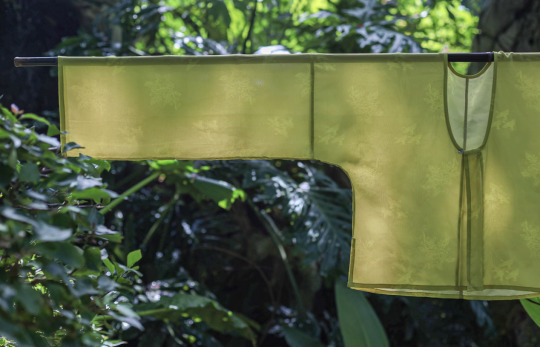
灵华 from 墨名堂 on Taobao
Literally ‘dropped neck,’ can be understood as a round collar that has ’sagged’ down in shape. The neck shape is a deep scoop shape, overlapping only slightly, usually secured with buttons. Almost exclusively seen in Tang Dynasty womenswear.
圓領/圆领/yuan2 ling3/Round Collar
The 大襟 round collar’s 衽 is usually more trapezoidal or rectangular in shape, as it extends all the way up to the neck. There are several varieties of round collar.

鳴澗 / Mingjian / Cascade by 九雲閣 Cloud9 Hanfu on Etsy (see alt text for photo credits)
The earliest forms of round collar found in Tang and before are the standing round collar, where the collar piece is a long strip of fabric sewn ‘standing up’ to the neck, resulting in a small protruding collar line. Robes with this kind of collar usually have symmetrical construction, with identical trapezoidal 衽 on the inside.


海誓 / Haishi / Pelagos by 九雲閣 Cloud9 Hanfu on Etsy
Later forms of round collar, mostly in the Song and Ming dynasties, have the collar piece on the same plane as the rest of the robe. This is sometimes called 盤領/盘领/pan2 ling3/Dish Collar. The collar piece can either be cut out in a round shape (modern method) or cut out as a strip of fabric and gathered into that shape by pulling a thread through like a drawstring (traditional method).

Custom order by 九雲閣 Cloud9 Hanfu on Etsy
Typically the flat round collar piece is wider. Flat round collars also might be more likely to be asymmetrical: the outside is the mostly the same shape as the standing round collar’s 衽,but the inside can look similar to a cross-collar or straight collar 衽,since it gets hidden on the inside. Usually outerwear.
立領/立领/li4 ling3/Standing Collar
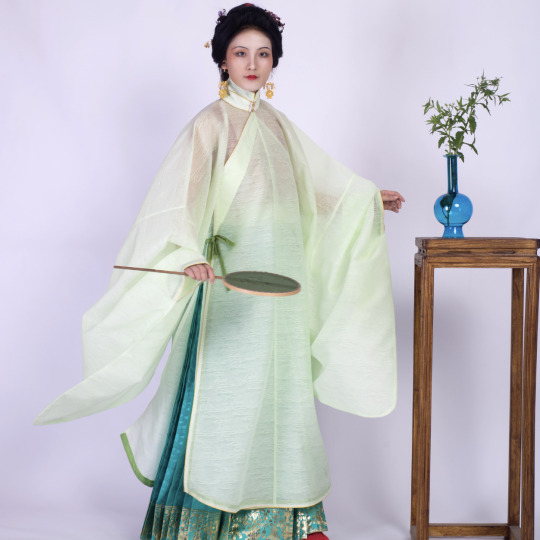
木有枝 from 空青汉服 on Taobao
This is the 大襟 cousin of the 立領對襟,also known as 竪領. The collar piece is the same, but there is a large trapezoidal 衽 attached on each side of the front center seam. This results in a diagonal lapel line running from the center of the neck down to the side, so it can also be called 立领斜襟/li4 ling3 xie2 jin4/Standing Collar Diagonal Lapel. Usually Ming Dynasty outerwear.
曲領/曲领/qv1 ling3/Curved Collar
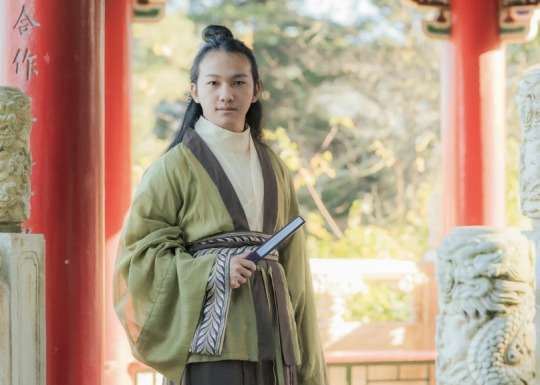
風流 /Fengliu/Zephyr by 九雲閣 Cloud9 Hanfu on Etsy (see alt text for photo credits)
Very old seldom-seen collar shape from Han to Wei/Jin Dynasty inner wear. Very similar to the cross-collar shape, but the outside flap comes up to wrap around the neck like a turtleneck.
navigation: hanfu in components 1 2 3.1 3.2 4 5 6 ...
#hanfu#chinese fashion#chinese hanfu#hanyuansu#hanfu fashion#hanfu photoshoot#chinese history#chinese#cloud9 hanfu#cloud9hanfu#九雲閣#hanfu in components
153 notes
·
View notes
Text
Hanfu in Components: Body Elements (pt6)
navigation: hanfu in components 1 2 3.1 3.2 4 5 6 ...
ngl I don't really know how to title this one so I just called it body elements, which is kind of clunky but the best I can come up with right now. This is gonna be on the shorter side; I want to go over some of the more unique features you might find on the main body (身/shen1) of a hanfu top. Many of them are very specific to a certain dynasty or time period.
腰襴/yao1 lan2/Waist 'Lan'

Extremely overused pic of the Yuejiangchen ru, with lan highlighted in green
A 'lan' on a top or robe refers to a rectangular piece of fabric attached to the bottom of a garment to extend its length. They can be of the same fabric as the rest of the garment, or a contrasting color. You can identify them by a horizontal seam running across the waist-ish area of an upper body garment—that’s the seam line where the lan connects to the shen. The action or quality of having a lan connected to the main body is called 接襴/jie1 lan2/attached lan.

前秦紫纈襦甘肃花海毕家滩26号墓出土 Ru relic unearthed from Huahai Bijiatan in Gansu, restored by China Silk Museum
Lan typically appear in pretty specific places: one, on a 襦/ru2 top/tunic; and two, on a 襴衫/lan2 shan1/Lanshan robe. Ru tops are generally found in Wei/Jin styles (they exist in other time periods, it’s just that the way modern hanfu popularity developed led to them being sort of relegated/most commonly seen in Wei/Jin). Most are true cross-collar tops; some have a curved collar (less common). Lanshan robes mostly appear in Tang Dynasty menswear and onward; they are usually round-collared robes and the lan tends to be more trapezoidal in shape.
!注 Terminology Caveat: Majority hanfu enthusiasts agree to define 襦 as a top shorter than knee length that has a 襴, but there is some disagreement over this because 1) the meaning of the word 襦 changed over different time periods in history, and 2) the 2010’s hanfu movement, which was largely still interwoven with guzhuang and also heavily motivated by factories trying to jump on the trend for quick cash grabs, referred to any top as a ru. I personally only use the word ru when referring to a short top with a lan, but there are arguments to be made for either side, so I’ll leave that up to you—as long as we’re all capable of communicating our ideas, there’s not necessarily a right or wrong here.

斜陽 / Xieyang / Vesper by 九雲閣 Cloud9 Hanfu on Etsy (see alt text for photo credits)
Tops extended with lan typically do not have 衩/cha4, or vents/slits, at the sides. Instead, to allow more hip movement, some lan may have inverted box pleats (工字褶/gong1 zi4 zhe23) at the sides and/or center. In these cases the shape of the lan is still a long rectangle, it’s just a little longer to compensate for the extra fabric that gets folded in on itself during the pleat. Given the way that hanfu is constructed you can see how it might be difficult to add a pleat in the garment’s side without a lan—you’d have to have at least side seam in the way. Adding a lan allows you to pleat continuous fabric, and because it’s a narrow rectangle you can cut the whole thing from one piece of fabric with no connecting seams.



Left to right: 剪秋姝品 from 端正记 (Tang Dynasty 圓領襴袍/yuan2 ling3 lan2 pao2), 江城子 from 溪春堂 (Song Dynasty 襴衫/lan2 shan1), and 梅紋暗花紗明制圓領袍襴衫 from 洞庭漢風 (Ming Dynasty 襴衫)
The other place that you’d see a lan is on a 襴衫/lan2 shan1. The name is slightly misleading, because we like think of shan as ‘shirts,’ but it really just means a garment that covers the upper body, so it includes robes as well. Lanshan are usually a type of long round-collared robe, popular among scholars and literati. The Tang, Song and Ming Dynasties all have their own versions of the lanshan (one of the Song versions and the Ming version look very similar), but the Tang and Song versions have a lan extension piece attached approximately at the knee level (afaik the Ming dynasty version just kept the name from the Song dynasty). As a result lanshan tend to be closer to ankle or floor length as opposed to knee or calf length like some other round collar robes. In most cases the lan might be closer to trapezoidal than rectangular, to account for the flaring of the robe's body shape.
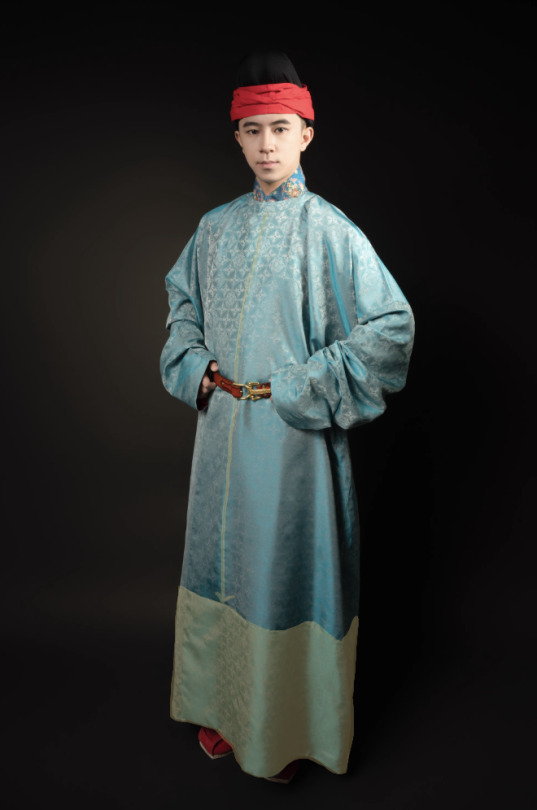

Left to right: 剪秋姝品 from 端正记 (Tang Dynasty 圓領襴袍/yuan2 ling3 lan2 pao2), 江城子 from 溪春堂 (Song Dynasty 襴衫/lan2 shan1), marked up to show the center front seam and lan pieces.
衽/ren4/Lapel
The ren is the part of the 身/shen1/body in 大襟/da4 jin1/Great Lapel garments that bridges each front piece’s gap between the center front seam and the other side of the garment. It typically takes the form of a triangle or a trapezoid, though it might vary a bit based on the collar variety.
Depending on time period, it's possible that one or both sides of the garment incorporates the ren directly into the body without a separate front seam. Ming Dynasty tops specifically have ren on the outer flap, but the inner flap ends at the center front seam—that's why when you put it on you can't make the knot right at the base of the ribbon, you have to let the inside part hang down loosely. (This is 100% the most common mistake I see with people wearing Ming Dynasty tops—it doesn't not fit you you're just not putting it on right!!!)
(ex: round collar, cross collar, standing collar,
擺/bai3/Side Flaps

暮春间 from 执月, Ming Dynasty mens' 圓領袍/yuan2 ling3 pao2/round-collared robe with 平擺/ping2 bai3/flat bai highlighted in green.
Kind of at a loss for how to translate this into English. Not to be confused with the bai of skirts or the 下擺 aka hemline, the bai I'm referring to here is a feature specific to Ming Dynasty menswear—I've had a client refer to them as 'hip wing,' which I think is pretty cute. They're essentially extra pieces that extend out from the side of some Ming Dynasty mens' robes.

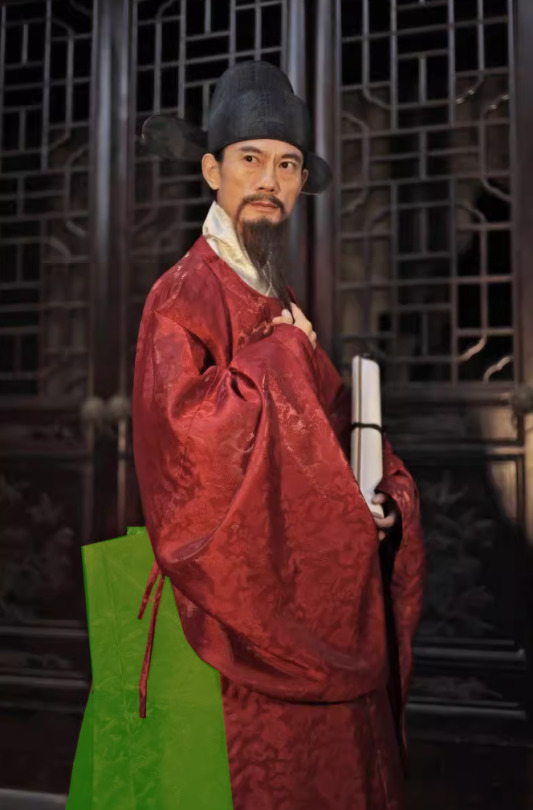
Still 暮春间 from 执月, Ming Dynasty mens' 圓領袍/yuan2 ling3 pao2/round-collared robe with 平擺/ping2 bai3/flat bai highlighted in green.
There are a couple different kinds of bai, that have to do with their shapes and placement. Most are 外擺/wai4 bai3/outer bai, meaning that they can be seen from the outside. The top may be flat (平/ping2) or pointed (尖/jian1) in shape. The pointier ones will often extend up to the elbow or further; generally when they're worn they go behind the arms and point backwards. You'll most often find outer bai on more formal garments like 搭護/搭护/da1 hu4, 直身/zhi2 shen1, 野撒/ye3 sa4 and 圓領袍/圆领袍/yuan2 ling3 pao2.
When worn, the bai is usually folded backwards under the sleeves, so they're not actually super visible especially if the sleeves are wide. They're more visible from the back/side and when sitting down.

云意 from 执月, Ming Dynasty 道袍 Tao robe. Purposely chose a version with sheer fabric so you can see the inner rectangular bai showing through the main body.
內擺/nei4 bai3/inner bai fold inwards instead of outwards, so they're not visible from the outside, but they still have essentially the same construction, just in a different direction. Cross-collar robes with inner bai are called 道袍/dao4 pao2/Tao robes. Cross-collar robes with outer bai are called 直身/zhi2 shen1/Zhishen robes.
Utility-wise, bai allow long robes to have very high side slits (for mobility) while obscuring what you're wearing inside of them when you walk around. They're also just kind of a fashion statement though. A lot of Ming Dynasty fashion liked looking Wide and Steady like an equilateral polygon or something.
Ok that's it for now lmao sorry im slow and tired, if I think of any other body elements + if anyone asks for them (pls send asks I'm lonely) then I will add them!
navigation: hanfu in components 1 2 3.1 3.2 4 5 6 ...
#hanfu#chinese fashion#chinese hanfu#hanyuansu#hanfu fashion#hanfu photoshoot#chinese history#chinese#cloud9 hanfu#cloud9hanfu#九雲閣#hanfu in components
90 notes
·
View notes
Text
Year of the Snake Display @ Fremont Main Library

im late as hell but made a quick trip back home to set this display case up last week at Fremont Main Library in Fremont, CA (same place that the previous event was held) for AAPI Heritage Month!
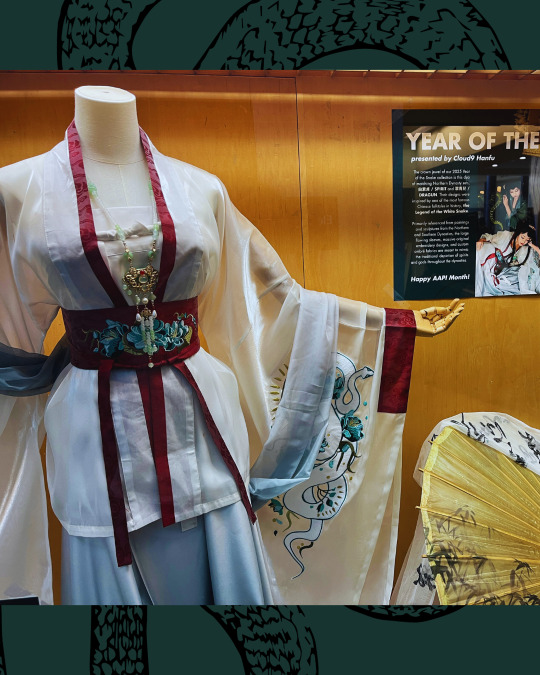

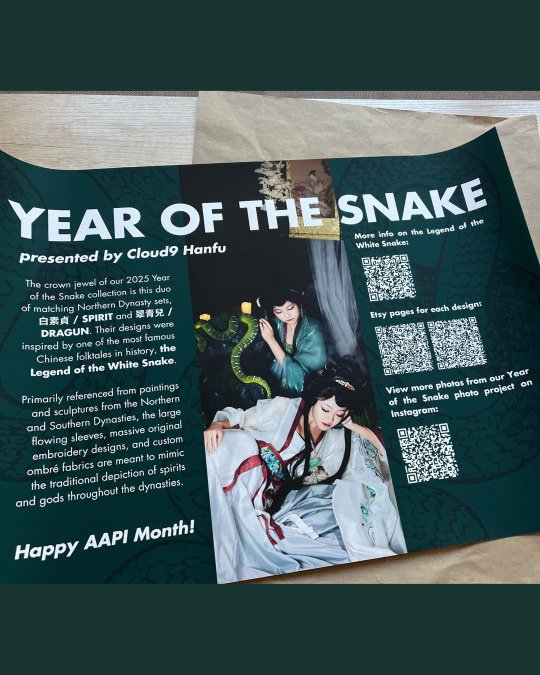
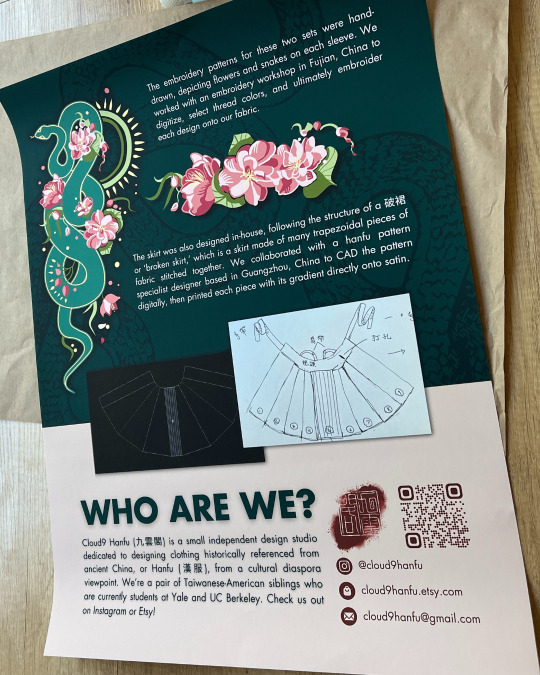

#hanfu#chinese fashion#chinese hanfu#hanyuansu#hanfu fashion#hanfu photoshoot#chinese history#hanfu art#cloud9 hanfu#year of the snake#aapi heritage month#aapi month#art exhibition#cloud9hanfu#fashion design#ft extremely last minute poster prints from fedex#because i lowkey forgot we booked this#until like 3 days before#and had to rush home during dead week#also i just finished my last final yay#lowkey kinda threw but also its curved#and nobody understands quantum mechanics anyway
89 notes
·
View notes
Text
[EVENT RECAP] Spring, Skirts & Serpents: An Exploration in Hanfu

HELLO I am not dead! I see that some of my informational guide posts have been garnering attention recently; I will return to continuing that series soon, I have just been very busy x-x

I wanted to recap on this event that ate up my entire spring break (I posted about it a bit ago but I'm taking that post down so it doesn't get confusing). The event description is as follows:
"We will be presenting at “Spring, Skirts & Serpents: an Exploration in Hanfu” at Fremont Main Library (2400 Stevenson Blvd, Fremont, CA) on 3/29 from 1pm-2:30pm! We’ll be showcasing some of our Year of the Dragon + Year of the Snake designs runway style, followed by an interview-style talk (with me it's me I'm getting interviewed).
The event is in English and is free and open to the public, but space may be limited on the day of, so we’ve made sure you can preregister as VIPs and guarantee yourself a seat!"

As indicated, the event was held at Fremont Main Library in Fremont, CA. In addition to sharing some photos & videos, I want share the inner workings of making this event happen as well as reflect on some highlights/improvements that could be made.
Purpose
Several months ago I was approached by my past Chinese teacher Tung Laoshi (ya boi went to Chinese school for many years like a good little child, but transferred to private tutoring after elementary school) with an invitation to run a showcase event. For context, with the high concentration of Chinese-speaking families in the bay area, there's a fairly extensive network of Chinese teachers here—the circle closest to me is primarily Taiwanese (so we learn traditional characters instead of simplified). Tung Laoshi is a teacher in the Palo Alto area where I grew up. Wu laoshi was the other primary event coordinator, another Taiwanese Chinese teacher from Fremont, where the event was held, bringing in the support of the Wang & Wu Foundation.
Basically, the people organizing this event (other than me) were mostly coming from a Chinese education perspective. It's gotten harder and harder for these teachers to pique interest in Chinese language & culture from American-born kids. I'm not an exception to this, I hated going to Chinese school as much as any other kid, but due to a combination of factors including switching to private tutoring, higher-than-average immersion in Taiwan, and getting bribed with sweets, I ended up with a better handle on the language than a lot of other ABCs and ABTs (and running Cloud9 Hanfu DEFINITELY improved my language skills via immersion). From what I could gather, one of the questions at the core of their reasoning for holding this event was, why are you so interested in Chinese culture? How can I make my students/kids interested in it too? How do I get them to enjoy it enough to seek it out themselves, like you did, rather than needing to force them into begrudgingly learning it?
Honestly, I don't have a direct answer to that question. My appreciation for culture is multifaceted, driven by a combination of factors that aren't necessarily controllable. I can only hope that by sharing my work with everyone I can help inspire someone—if not the kids learning Chinese, then the teachers teaching it, to keep doing what they're doing.
On my side of things, this was an opportunity to share my work in person. I rarely hold events myself—Yulan deals with most of that, and has experience with several shows under her belt—but I have to say that, sort of like the Feynman technique, looking at my work through the lens of presentation to other people helped me get a lot of my thoughts in order and develop the concepts I wanted to express into intentional points.
I'm typically very very uncomfortable with public speaking, and will take any possible opportunity to move out of the spotlight, but I suppose I won't get better at it if I don't practice, and there will be times when it's necessary. After all, understanding the artist is crucial to understanding the art, so if I want to share my work then I will, to some extent, have to share about myself. It wasn't perfect, but it was an experience that I'm glad I went through :)
Prepwork
Preparations for the event were mostly concentrated into t minus 2 months or so. I was still in the depths of midterm hell for most of these two months and our MC Sandra was in Taiwan/Japan so we had to rely on Zoom for most of our meetings. Over this period we worked together to decide on an overall agenda, what sets we wanted to show, and the content of what we wanted to focus on for the interview.

Originally the event was supposed to be focused on the Year of the Snake collection alone, but our contact from Fremont Main Library felt that focusing on snakes only would drive away audiences that didn't like snakes, so we compromised on showing 4 sets from the Year of the Dragon collection and 5 sets from the Snake collection. The styling was mostly up to me, so during this time I put together the components of each of the 9 looks: the set, shoes, accessories, hair, makeup (kinda), etc. and made the necessary purchases.

Our 9 models ranged in age all the way from 7th grade to 31 years old. They were recruited from various places, some being students of the teachers, some being server members of Cloud9's discord. None of them had experience modeling, and very few of them had experience performing in any regard, but I think that choosing fresh faces to participate is a good thing: it gives new people a chance to experience hanfu, not limiting it to a small circle of people who are already invested in it.
We had one rehearsal a week before the event and another rehearsal on the morning on the 29th, so in total the models had maybe 5-6 hours of practice time to learn how to move around in clothes they'd never worn before, posing, coordinating with the MC etc.

The morning of was—not unexpectedly—a giant chaotic mess, but still fun nonetheless! I had to do nine people's hair in roughly 2 hours and barely finished before the event started. At the end of the day all nine models exceeded my expectations and presented beautifully :)
The interview portion was as terrifying as I expected but mostly went smoothly. I think I looked awkward as hell, but I at least didn't look like I wanted to dissolve into the floor, which is how I felt, so I'll count it as a success. For some reason the interview was cut really short, so there was a lot of content that we didn't really get to discuss, but I'm glad we got some of it out there: explaining the inspiration behind some of the sets in the snake collection, describing my experience & interest in hanfu, taking some questions and answers, etc etc.
Runway Lineup
KUKRI / 赤松子


Year of the Snake, Warring States Period, based on the Kukri snake, modeled by Natalie Chung. Natalie is in eighth grade and does competitive dance, and presented some of my favorite poses during the show. Her control of the giant sleeves was phenomenal, especially considering she had so little time to get used to them.
HUNDRED-PACER / 百步蛇


Year of the Snake, Han Dynasty, based on the hundred-pacer snake/Chinese moccasin, modeled by Edith Huang (ig: @ediithhuang). Edith is in eighth grade and has the tiniest waist I have ever set eyes on. I keep saying that it's like this set was made for her.
SPIRIT / 白素貞 + DRAGUN / 翠青兒



Year of the Snake, Northern & Southern Dynasties (specifically Northern Wei), inspired by the Legend of the White Snake, modeled by sisters Emma (ig: @eeeeemma_wang) & Audrey Wang (ig: @audreyolafz). Emma is a third year at UCSB and Audrey is a first year at UC Berkeley. They went up together with a pair of oil-paper umbrellas and executed the umbrella-spinning moves perfectly.
EQUINOX / 天欲暮


Year of the Dragon, Tang Dynasty, modeled by sword gremlin Kevin T. Wong (aka Sword Kevin or Sevin) (@ktw-shu). His aerial & sword flowers were a crowd favorite. During q&a we asked a little boy which set was his favorite and it was, unsurprisingly, this one. I also dared him to dab onstage.
HESPERUS / 升天行


Year of the Dragon, Tang Dynasty, modeled by Anyka Chan (ig: @an.bri.ka). Longtime server member. I don't know exactly what it is, but she carried this set with that kind of energy that just radiates out from her like she's glowing. The Tang beizi was not presented because we lowkey lost is oopsies.
AQUARELLE / 海霞紅


Year of the Dragon, Song Dynasty, modeled by Alicia Ho (ig: @lala38520). Alicia is in 7th grade, our youngest model this show, and I'll admit I was a little concerned, but as soon as the clothes + makeup + hair went up it was like she walked out of a painting. The white crown on her head is called a guan, popular in the Song Dynasty. This one was 3D printed.
MARQUIS / 隨侯珠


Year of the Snake, Ming Dynasty, modeled by Xing Chan (ig: @xingnificant). Xing Chan is a chemistry student at UC Berkeley. He has the most luscious hair ever and I will never stop asking for his haircare routine and then immediately forgetting what he said, causing me to ask about it yet again a month later.
SERAPHINE / 雲化龍


Year of the Dragon, Ming Dynasty, modeled by Lydia Wang (ig: @lydiaa_wang). Lydia is a sophomore in high school. As soon as she picked up the ruyi scepter on the day of rehearsal I knew I'd chosen the right model to close the show—this is a very elaborate set and can be hard to hold up, but she executed flawlessly.
Reflections
The Good Stuff
The models!!!!!! I am so thankful to everyone who volunteered their time to help out at this event but especially to the models, who had to spent hours on hours drilling their poses and had to go on stage one at a time all by themselves. Modeling isn't just as simple as walking across a stage either; the number of things that you have to remember at the same time is WILD: posture, expression, eye contact, focusing on shifting weight, coordinating timing with the MC, all while remembering the choreography that you're supposed to be doing. Everyone worked so hard and I'm so so grateful for their efforts, the results turned out beautifully.

Kept putting down our water bottles, losing track of them, and then needing to get a new water bottle because we couldn't remember which one was ours. I think I went through like five separate bottles.
Another thing was the Chinese teachers that helped out or attended as part of the audience. I haven't been in Chinese school in years, and when I actually was there I certainly didn't notice, but a lot of these women are really very hardworking, passionate teachers who find meaning in what they're doing. It was like I could see a ray of light shining in their eyes when I went up there, something to indicate that their efforts would not always be in vain. Don't get me wrong, I'm guilty of hating on Chinese school too, but after hanging out with a lot of the aunties & teachers it's clear that, as immigrants, it really does bring them joy and inspiration to see cultural continuance. It was very heartwarming.
I think what makes it even more personal is that these were specifically Taiwanese teachers. Many of them still struggle with English, but they came anyway because it was worth it to them. And for me these are the voices I grew up around and how I learned the language (many people from China will mock Taiwanese accents, but it feels very familiar and comforting to me). It was significant to them that I—the person being interviewed—was Taiwanese too.

Katy Wu from Wang & Wu Foundation
Overall I think I gained a lot of exp from the event! I still hate public speaking with a seething passion but it did make me think about some of my motivations and ideas more cohesively, since I needed to present my thinking to the public. Ultimately I think I came out of this feeling even more strongly about what I do, and I'm glad I did it.
The Error Analysis
When you have events that have expenses and higher-ups in politics or big nonprofit organizations are invited, you have to spend a lot of time acknowledging sponsors and shaking hands. I will not lie, I didn't know like 80% of the Important People that I was told to shake hands with, all I can offer is that I'm glad they came to watch anyway. The whole PR side of things isn't something that I'm very comfortable doing, though, hence why I usually leave it to Yulan, and it was definitely not my favorite part of this event.
Other limitations including time and audience also made it so that I had to cut out a lot of what I wanted to say during the interview. We did briefly talk about what topics to focus on before the event, but otherwise the interview was entirely organic. Unfortunately that also meant that a lot of it was out of my control. It's hard to describe without getting into detail, but I do think that there were subjects that the other event organizers wanted to focus on that I didn't want to focus on, and things that we knew the audience would want to hear about that I didn't think were important. Compromises have to be made!

Anyka doing her eyeshadow :>
Chaos is mandatory during event planning, but I also think that switching the topic from year of the snake -> snakes & dragons made it much less cohesive. I talked about the inspiration behind the year of the snake collection during the interview and highlighted a few specific sets for their connections to folklore & adjacent cultures, but the dragon sets were kind of just not mentioned. Not sure if audience members noticed it but it felt weird to me.
Another thing is that after discussing with my parents after the event (it's a thing we do, my dad likes to Get Deep into things), I realized that the event presented me as a designer and only as a designer. This is similar to how I depict myself online usually, but the truth is that there's more behind it that I didn't do a good job at communicating: I don't just draw pictures of clothes, I do a mind-numbing amount of research, international logistics tracking, supply chain management, etc. etc. to make this happen, and I do sometimes wish I was able to express that, because it's a big part of what I'm doing.

Conclusions
I am SO TIRED, this ate up all my energy for two months and then I had to take my special relativity midterm right after the event. I'm probably not going to have the energy for something like this for a while! That being said, going through the whole process was really fun and interesting and I'm curious about more events—informational, in person, online, whatever—in the future. With any luck, the more I do them the better I'll get at them, right?


Backstage shenanigans. Screenagers smh
Anyway, this post is long enough as it is. If anyone who attended sees this, hi!!!!!!!!!!!!!!!!! Thank you for coming!!!!!!!!! Otherwise I will go gorge myself on post-midterm snacks to untwist my brain from quantum physics. <3
Press:
SF Epoch Times - 穿越千年時光 灣區漢服秀展現華夏章服之美
Worldjournal - 「蛇龍舞春 漢服演繹」活動 洪兆寧設計9套漢服 感受傳統魅力
OCAC News - Cultural Fusion on the Runway: ‘Spring, Skirts & Serpents’ Highlights Hanfu Designs
快樂方程式 - 認識漢服之美 由Ariel 與董秀婷老師介紹蛇龍舞春的漢服活動
#hanfu#chinese fashion#chinese hanfu#hanyuansu#hanfu fashion#hanfu photoshoot#chinese history#hanfu art#chinese#cloud9 hanfu#cloud9hanfu#九雲閣#fashion#runway#event#hanfu event#live event#public event#cultural heritage#cultural exchange#fashion design#taiwan#long post
76 notes
·
View notes
Text
青白之魅 6: Conclusion
1 Introduction & Presentation // 2 Background & Influences // 3 Hair & Makeup // 4 Set Design // 5 Clothes & Accessories // 6 Conclusion
If you’ve followed this series all the way to the end, thank you for your support! A lot more people saw it than I thought would, and I’m really happy that I got to share my process and thoughts with you :) I read all your replies/tags and they make me super happy! There are just a few more things I want to address to wrap things up now.
behind the scenes vid of me with Dragun that Bloomin Studio recorded for us :)
Things That Went Wrong
I am a strong believer in the scientific method and the scientific method involves error analysis!!!!! Also I don’t want it to look like all of this went off without a hitch. That wouldn’t be fair to the complexity of this project and all the people who helped me work through and solve the problems. So here are some of the ways in which We Fucked Up.
Embroidery positioning: The bottoms of the sleeves were accidentally sewn together before the pieces were sent to the embroidery workshop. If you put the whole sleeve into the machine the embroidery would go through both the front and back of the sleeve, making it unwearable. To solve this, we had to pull the stitches out from the bottom of the sleeve, have it embroidered, and then have it sent back to a tailor's shop to repair the seam.
Tear in fabric: Lily organza/crystal organza admittedly is a very fragile fabric, especially for machine embroidering. It’s extremely thin, and the surface is very smooth and slippery, which looks phenomenal but makes embroidering it really hard. I covered this in the last post, but long story short, in the process of embroidering one sleeve on the green set, the fabric got snagged in the machinery and tore a hole in the bottom of the sleeve.


At first the plan was to remake the entire sleeve piece, but because the color of the fabric was custom-printed, when I had a new piece of fabric printed for the new sleeve, the color didn’t match exactly, so we had to make do with the existing fabric. In the end we shortened the width of the sleeve so that it cut off above the hole, moving the seam up. Thankfully it didn’t really show up in the pictures, but you can see when it’d laid flat how the ‘margin’ under the snake embroidery for this garment is unusually small, because it got cut off.
Lateness: We ran like a full hour or two overtime with our hair & makeup. This is unfortunately not at all unusual for fashion projects like this, but as a result we lost like a third of our photography time, so there were some shots that I would’ve loved to get that we didn’t have time for.
Forgotten items: There were a number of things we forgot to bring down to SoCal with us. The biggest thing was probably our steamer. Fortunately, because this set is mostly polyester, it didn’t get too too wrinkled, but there are still some creases and folds that we would’ve steamed out had we gotten the chance.
Fav Shots
Shh not all of these are published anywhere else.






Things I Would've Done (if I had infinite time and money)
Lingzhi - I don't have any photos of it but I bought a replica lingzhi herb (the magic fungus that Bai Suzhen steals to revive Xu Xian after her dies of shock from seeing her snake form) prop. We didn't get around to using it but it would've been a really nice major callback to the story. Also I would've gotten to talk about how I think it's highly possible people thought the lingzhi was magic because they ate it and started tripping balls
Willow branches - Willow branches by the West Lake feature heavily in the opera. I wanted to get willow branches to hang from the backdrop but unfortunately wasn't able to find ones that were realistic enough. They were replaced with dried water reeds, but most of the pictures weren't shot high enough to get them in frame.
Swords - In the opera, Bai Suzhen and Xiaoqing both carry swords. Also, swords are also just cool as hell. I do own one prop sword, but it was too big to fit in my suitcase even diagonally, and also I really didn't want to deal with TSA side-eyeing me about it (even though it technically counts as a prop or sports equipment), so we did not get any swords in the photoshoot.
Extremely specific shot with snakes on the floor - I have this concept of a shot: the empty set, without me or my sister in it, with both Dragun and Spirit on the floor. It would be so cool to do like a snake form -> human form diptych concept! We didn't have time to get both the snakes out at the same time unfortunately. Artistic rendition below LOL

artist's rendition
Credits & Thanks
Credit should be served where credit is due!!! I probably mentioned most of them somewhere but I want to reiterate that a whole lot of people helped make this happen and I appreciate them a lot.
Day Of:
Yulan, as the White Snake (ig @/chlobaltblue), especially for all the Talking To People Thing parts (that I hate doing)
Bloomin Studio (ig @/bloominstudioofficial), photographer
Cujo from Art of Scales (ig @/art_of_scales), for providing us with Spirit & Dragun as well as the space
Kevin (ig/@k.evinzhao), for driving and getting us stuff
Cloud9 Hanfu (ig @/cloud9hanfu), which is me and Yulan but it feels weird not to link the brand somewhere
Preparation:
Jinerjia(cutting & sewing)
Xishi Pavilion (cutting & sewing)
Chenxi Workshop (cutting & sewing + alteration)
Hantangfengshang(cutting & sewing)
Changxin Embroidery (digitizing & machine embroidering + alteration)
Hanyiren (patternmaking + CAD)
Xingluzhe (fabric printing + laser cutting)
Final Thoughts
In the introduction I talked a little bit about our intentions with this project and the cultural elements that I attempted to adapt and interact with. The Legend of the White Snake is one of the most well-known Chinese folktales out there, and yet there are so many wonderfully intricate details within it that people don't know about.
Snakes have a bad reputation in a lot of cultures. Evil, dangerous, and malicious, they're often cast as the scheming villains of the story, sly and sneaky characters whose goal is to do you harm. They are not the only victims of a bad reputation—every great dynasty always has some beautiful woman to blame for its eventual downfall. People have been arguing over the game of fault and intention for centuries. Even in the hanfu community, there is an unprecedented amount of infighting over what should or should not count as hanfu, who is 'allowed' to appreciate it, or who can take 'ownership' of it.
I think that's the last thing we need in this day and age. I'm reflecting on this project at a time that is uniquely terrifying for many minorities, especially in the US, who seem to be being persecuted for the crime of simply existing. I don't claim to be fighting for justice, I'm just a student in a world that is far too large for anyone to comprehend. But I hope that I helped make something beautiful happen, and I hope that we shared that with someone else, even if it's just a few people, who are reminded that it's not all for nothing :)
-
Okay, we're pretty much done here. I really enjoyed this process and documenting the whole thing, and I definitely want to do something like this again someday, but I definitely don't have the energy to do this kind of thing very often! If a big project does come up again I'll probably document it in a similar way, but it probably won't be for several months/even years. I'll keep posting hanfu articles and maybe document some smaller single-post projects on here at some point :)
Thank you for letting me share this process with you, and feel free to reply/reblog/send asks/whatever with thoughts, questions or concerns! Please interact with me it brings me joy.
1 Introduction & Presentation // 2 Background & Influences // 3 Hair & Makeup // 4 Set Design // 5 Clothes & Accessories // 6 Conclusion
Here's a picture of my snake to close out (his name is Porcupine/Porky for short/滷肉飯 and he's the dumbest animal I've ever met)

#hanfu#chinese fashion#chinese hanfu#hanfu fashion#hanyuansu#hanfu photoshoot#chinese history#hanfu art#chinese#青白之魅#cloud9hanfu#cloud9 hanfu#九雲閣#legend of the white snake#snake#behind the scenes#shitty drawings by tangtang#conclusion#chinese art#photography#photoshoot#白蛇傳
117 notes
·
View notes
Text
青白之魅 5: Clothes & Accessories
1 Introduction & Presentation // 2 Background & Influences // 3 Hair & Makeup // 4 Set Design // 5 Clothes & Accessories // 6 Conclusion
This is the actual hanfu post of the hanfu series on this hanfu account! So if you’re here for HANFU and specifically HANFU this is it >:)))) We’re gonna get deep into the relics & archaeology with this one!
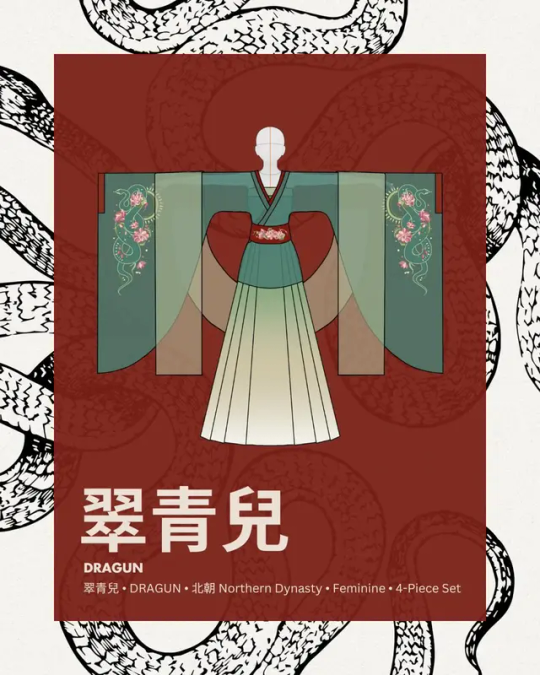
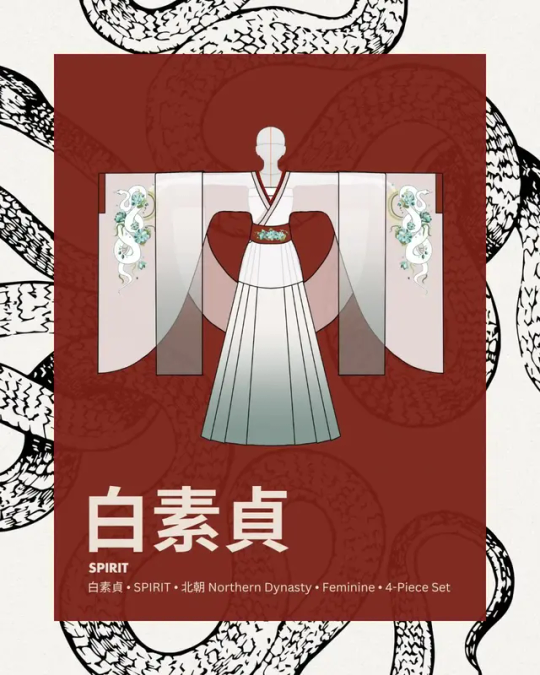
L: Cui Qing'er set, R: Bai Suzhen set, both Cloud9 Hanfu
So before we start. This was supposed to be a four-piece set. However, my dumbass (and Yulan’s dumbass I guess) forgot about the pibo ;-; So it literally just doesn’t appear in the shoot and We Will Not Speak Of It. It still looks pretty great! Just completely slipped our minds amidst the chaos x-x
Anyway: each of these are (SUPPOSED to be) a four-piece set. The four pieces are 大袖褶衣/da4 xiu4 xi2 yi1/large-sleeved top,九破裙/jiu3 po4 qun2/nine-panel skirt,腰封/yao1 feng1/wide sash,and 披帛/pi1 bo2/shawl. The sash & shawl are smaller accessory pieces, so the main two pieces are the top and the skirt: they are completely custom printed and custom patterned, the culmination of months of research. I will be focusing on these two pieces in this post (I’ll go over the last two briefly at the end, they’re just not as interesting).
Background: Northern Dynasty
Background for these sets: Both of these sets are referenced from the 南北朝/nan2 bei3 chao2/Northern & Southern Dynasties, with more emphasis on the northern part. This was a very tumultuous time period that often gets looped in with the 魏晉/魏晋/wei4 jin4/Wei & Jin dynasties for a combination time period known as 魏晉南北朝.
This means two major things in the context of hanfu research: 1) there’s a lot of very fast-paced exchange of culture and evanescent fashion trends going on, and 2) there are very few well-preserved textile relics to work off of. As a result, the sources for Northern & Southern Dynasty clothing often bounce off of chronologically adjacent artifacts. This also means that physical garment relics that we usually depend on to learn about the patterning/construction of hanfu from that time period have to be supplemented with figurines and carvings from the time, so we can see what they were supposed to look like. There’s a lot of educated guesswork involved.
Most types of hanfu have direct garment relics that their patterns are recreated/resized from. The strictest hanfu enthusiasts—called the 形制黨/形制党/xing2 zhi4 dang3/‘form party’ (party as in like political party, not like a rave)—only recognize hanfu that are constructed identically to an archaeological source, because a physical reference is the only surefire way to ensure that the construction is ‘correct.' All other kinds of hanfu are considered hanyuansu or modified, hanfu-influenced versions of clothing.
I used to be stricter about this too, but I realized after several years researching hanfu that when you get really deep into it, the lines become really blurry. So if you’d like to be stricter about it, feel free to consider this set hanyuansu! But because a lot of research went into it, and I personally think it's very very likely that these constructions existed, I feel more confident in calling it hanfu than guzhuang or some kind of ‘costume.’
大袖褶衣
The construction of this top is primarily based off of two archaeological relics from the Northern Dynasty: a sleeve piece and a 褶衣 (!注: 褶 is pronounced xi2 in this phrase) relic. There is very little material out there on the sleeve piece, but the Xiyi is very famous and was restored by the China Silk Museum.
褶衣/xi2 yi1/Xiyi

绞缬绢衣, 中国丝绸博物馆/China Silk Museum
This is the Xiyi. Its full technical name is the 絞纈絹衣/绞缬绢衣/jiao3 xie2 juan4 yi1/'twisted knot silk top,' but it's known colloquially as the 褶衣. Right now it's in the China Silk Museum's collection of artifacts.
It was originally excavated by the Gansu Institute of Archaeology from 甘肅花海畢家灘26號墓/甘肃花海毕家滩26号墓/gan1 su1 hua1 hai3 bi4 jia1 tan1 26 hao4 mu4/'Gansu province Huahai Bijiatan grave site #26,' which was discovered in May 2002. The burial site belonged to a woman who died in the year 377CE. A good chunk of clothing artifacts from the 魏晉南北朝 period that have been referenced in hanfu today came from this woman's tomb.
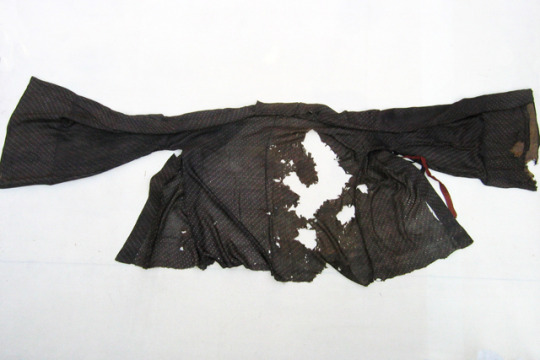
It used to look like this before it was restored by the China Silk Museum. You can read the restoration report here.
There's a whollllleeeeee textile analysis complete with microscope fiber images that I could go through here, but I'll save it for another post since my design doesn't have anything to do with the fabric of this piece, just the structure.
Now, I only used the torso portion of the Xiyi, since I used a different sleeve shape, so I won't be going over the Xiyi's sleeves either. The torso looks like this:
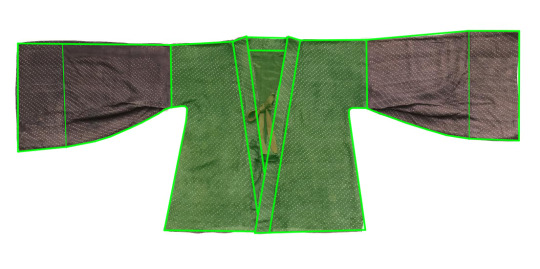
Fairly simple structure! It obeys all the general rules of hanfu construction. There are a few features to note though.
The back of the neck is very wide. Most open-front hanfu garments have a small gap at the top of the neckline. This garment, however, has a particularly wide gap.
There are no vents. I know it's not visible in the flat picture, but there are no side slits/vents, which is one of the main features distinguishing this piece from similar parallel-collar tops from the Song/Tang dynasties (usually known as 褙子/bei4 zi0/Beizi). This makes sense: vents are necessary for longer garments so that your hips don't get trapped, but for shorter garments they're not needed. This xiyi is 72cm long, which is still considered short.
There is no 'lan' piece. Modern convention dictates that a top with a lan piece be called a 襦/ru2 (again, modern convention in the hanfu community!!! This is not necessarily historically true). Since this top doesn't have one, it's not considered a Ru, earning its own name as the xiyi.
The root of the sleeve is narrow compared to the rest of the body. It's only about 1/3 the length of the torso.
Finally and most importantly, it's not a cross-collar garment, but the lapels aren't parallel either. Instead, they slope down diagonally from that wide-set neck and meet at a point at the bottom. There's a tiny portion that overlaps, but if you look closely you'll notice that it's actually only the trim that overlaps—if you took off the trim, the torso pieces would meet at the same point.
Keep these in mind as we move on.
錦緣綾大袖/锦缘绫大袖/jin3 yuan2 ling2 da4 xiu4/'Brocade Trim Silk Large Sleeve'
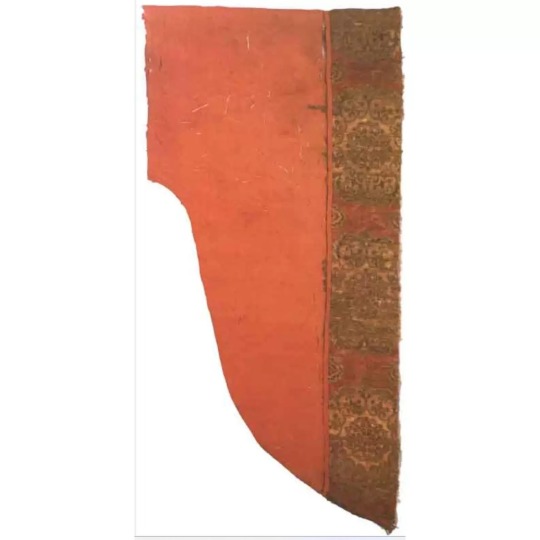
idek where I got this image, sorry
I spent a full three days scouring the internet for metadata on this thing (until I got hit with a 24-hour migraine and had to stop ;-;). It's a sleeve piece from the Northern & Southern Dynasties called the 錦緣綾大袖. Unfortunately, there is very very very little information out there about it.
From what I could find, this is because 1) it isn't a archaeological artifact excavated post-revolution (which is usually the case), it was an heirloom and doesn't have very good digital records, and 2) it is allegedly in Japan, and I don't know Japanese so I'm not very good at finding information in Japanese. Do not quote me on either of those points; I could be misinformed, but I wasn't able to find anything else.
According to 大唐女儿行/大唐女兒行/da4 tang2 nv3 er2 xing2, a book by 左丘萌 (Zuo Qiumeng) and 末春 (Mo Chun) published by Tsinghua University Press, this sleeve piece is in the Nara Shosoin Repository's southern warehouse collection, and was shown during the 58th annual Shosoin Repository Exhibit.
However, I looked up the records of the artifacts shown during the 58th annual exhibit and this artifact is not on the showing list, and I went through three separate databases of Shosoin relics and found nothing, so I have my doubts about the accuracy of this citation.
So all I have is this picture, which has been passed around the hanfu community for ages. Fortunately, that's basically enough: 90% of hanfu sleeve pieces are constructed the same way, just in different shapes. So probably if you unfolded it, it'd look like this:
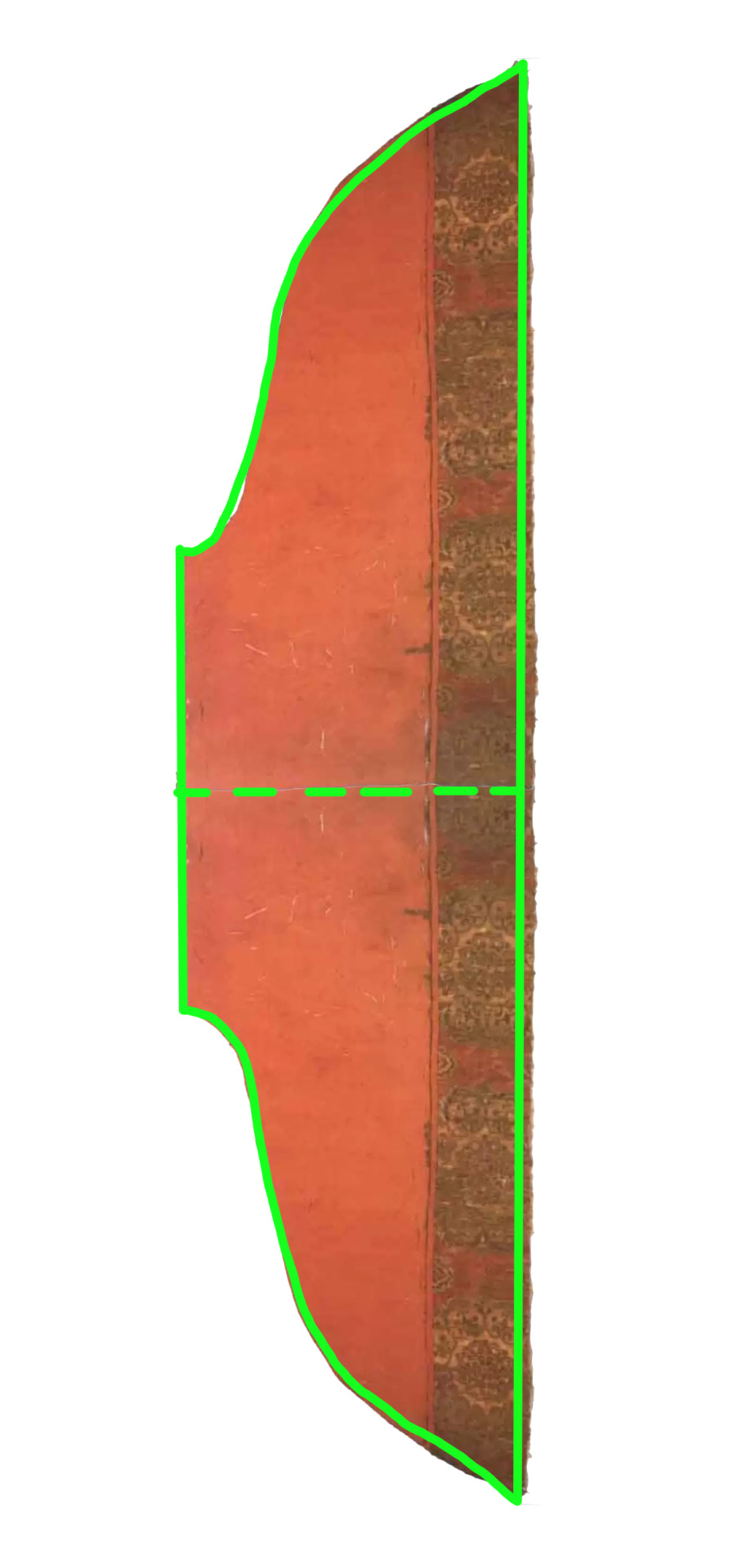
This shape is called 窄臂大袖/zhai3 bi4 da4 xiu4/'narrow upper-arm large sleeve,' because, well, it's narrow at the upper arm but wide at the sleeve opening. This differs from later-dynasty wide sleeves, which do increase in width as you get closer to the cuff, but start out fairly large as well. The shape is backed up by a boatload of figurines wearing the same structure from the Northern & Southern Dynasties.
Putting It Together
Okay, we've got a sleeve reference, and we've got a torso reference, and they both existed at the same time. That's... all of the parts we need to make a whole top! Here is the approximate franken-hanfu chimera we have put together:
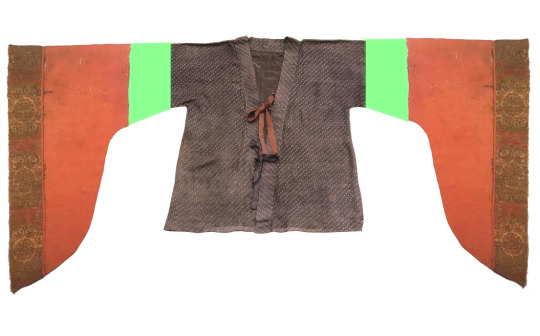
But how likely is it that this combination existed?
Pretty likely, actually, if we look at some corroborating evidence. Here is an article about 袴褶装/ku4 xi2 zhuang1 by the National Museum of China. 袴褶装 is a type of outfit (in the sense that t-shirt-and-jeans is a type of outfit) often worn by Northern & Southern Dynasty figurines. 袴 is the archaic form of 褲/裤 which means pants. 褶 refers to the 褶衣 from the previous section. 袴褶装 is the combination of these two garments in an outfit.
According to the article, 袴褶装 was a clothing trend that originated in the north, where nomadic tribes who were often on horseback (some still are today!) preferred to wear pants and shorter tops for convenience. This later got adopted by the Central Plains people, and the pants and sleeves got wider and wider—so it's very conceivable that a xiyi with wider sleeves than this relic existed.
Here are some figurine pictures from all over China:


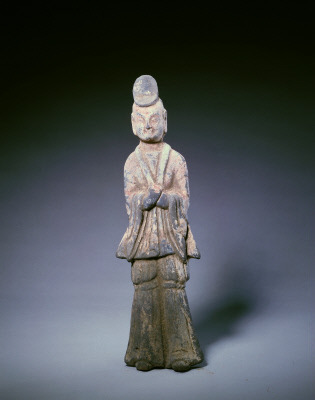
L: 陶文吏俑,北齐,徐州博物馆,1985?徐州狮子山北朝墓出土 (Ceramic Statue of Civil Official, Northern Qi, Xuzhou Museum, excavated 1985?from the Lion Mountain site in Xuzhou, Jiangsu)
C: 侍从陶俑,北魏,中国国家博物馆,1965年河南省洛阳市元邵墓出土 (Ceramic Statue of Attendant, Northern Wei, National Museum of China, excavated 1965 from the Yuanshao site in Luoyang, Henan)
R: 陶彩绘男俑,北魏,故宫博物院 (Colored Ceramic Statue of a Man, Northern Wei, China National Palace Museum)
So! I think that this combination is more than plausible. Take a look at these ones:


L: 陶女俑,东晋,中国国家博物馆,1955年江苏南京出土 (Ceramic Statue of a Woman, Northern Wei, National Museum of China, excavated 1955 from Nanjing, Jiangsu)
R: 彩绘陶女立俑,北朝,徐州博物徐州馆,茅村内华北朝墓出土 (Colored Ceramic Statue of Standing Woman, Northern Dynasty, Xuzhou Museum,excavated from Mao town site in Xuzhou)
Notice how the wide-set collar allows a little bit of the inside clothing (camisole? Undershirt? Who knows) to peek out at the chest. The wide skirt head of this set's skirt peeks out at the top in the same way :)
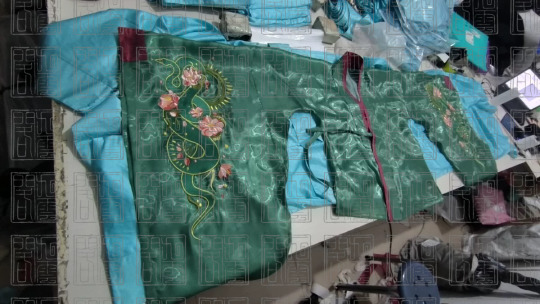
Materials & Details
The fabric used for these tops is called 百合緞/bai3 he2 duan4/‘lily satin’ in Chinese, but a lot of colloquial fabric names don’t transfer well between languages. It’s a sheer polyester fabric that’s somewhere between satin and organza. I’ve heard similar fabrics referred to as crystal organza. It has a very pretty liquid-like shimmer to it on the right side, which I felt was good for representing our ethereal water-bending snake spirits.
I went through dozens of fabrics trying to find the right texture that was available in the green-blue color needed for Xiaoqing, but fabrics of this kind often only come in macaron pastel colors. The targeted color was very specific—too green and it would no longer be 青, too blue and it wouldn’t match Dragun’s coloring. In the end, I had the color’s CMYK code custom printed onto white base fabric, then sent it off to be cut & sewn (by hanfu tailor workshop in Nanjing).
There is also trim sewn onto the collar (出芽/chu1 ya2) and sleeve cuffs, which is made from a beautiful red damask with cloud patterns woven into it. This pattern is a Ming Dynasty cloud pattern called the 四合如意雲紋.
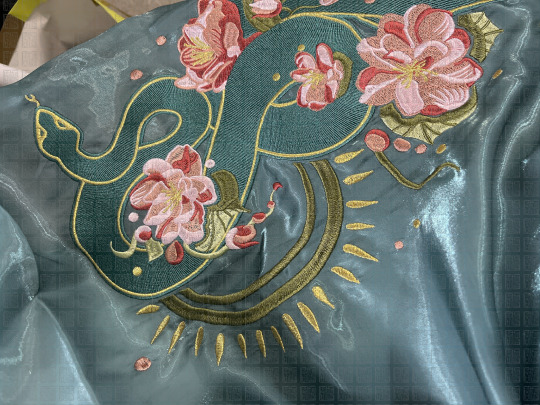
These embroidered sleeves are one of the most costly parts of the set.

I drew the embroidery pattern by hand on a raster file over the course of a few weeks (I use a tablet + Clip Studio Paint pro), then worked with an embroidery workshop in Quanzhou to digitize it.
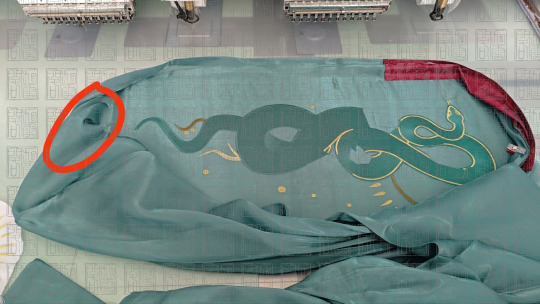
In the process of embroidering Xiaoqing's top, the fabric got snagged in the machine, and ripped a hole in the front of the right sleeve, which was very sad. There wasn't enough time to remake the whole thing before the shoot.
We rescued it by undoing the seam, chopping a portion of the sleeve off, and re-sewing it back together, resulting in a narrower sleeve opening than the white top (thank you workshop in Xuzhou!!!). The difference barely shows up on camera because it was so wide in the first place.
九破後褶裙
This is the garment that has the most guesswork associated with it, so it's the one that's least plausibly 'hanfu,' because I guessed a lot of it and pieced together a lot of sources to make it happen.
I was originally inspired by 玩泥巴的豆角 (user 'String Bean Playing with Mud') on Weibo. She's an incredibly talented historical costume enthusiast who's been the first to recreate tons of rarely-made hanfu pieces in addition to historical clothing from Korea, Vietnam, Japan, Europe, and recently Mongolia. She's also done handcrafted textiles, shoes, and other accessories. If you can read Chinese I highly recommend going through her posts but be careful because if you're like me you'll get sucked in and then neglect your homework for like a week.
This is a post that I saw back in 2023. She points out a kind of skirt often seen in Northern Dynasty figurines that has narrow pleats in the back but not in the front:


太原北齐东安王娄睿墓单螺髻侍女俑(505,508)/ Northern Qi Taiyuan Dong'an Wang Lourui Burial Site(artifact 505, 508)
She posits that there are two likely possibilities for the construction of this skirt: the 破裙/po4 qun2/'broken skirt' structure or the 百迭裙/bai3 die2 qun2/hundred-layer skirt structure (more on that later). Her recreation is structured closer to the Song Dynasty baidiequn skirt structure, with the reasoning that it would be easier to modify into a poqun later if an excavation ever came out confirming that it was a poqun, but it would be much harder to turn a poqun back into a baidiequn.

玩泥巴的豆角's image, linework of figurines with pleated-back skirts
For various reasons, one of which being that I'm not claiming this to be historically immaculate, I wanted to explore the possibility of a poqun structure. In addition, I actually do think that this pleated-back skirt is more likely to be a poqun than a Song baidiequn.
My understanding is that the baidiequn structure, which is essentially a long rectangle with pleats on it that gets wrapped around your waist, only got trendy in the Song Dynasty. There's a report of a few rectangular pleated skirts from the Tang Dynasty Famensi site (Shing Mueller, Center for Sinology, University of Munich) as well, but not much before that, and the pleats are very wide compared to a baidiequn.
Poqun, however, have been around since at least the Warring States period. We know this because of the several excavated artifacts from the Warring States Period, the Han Dynasty, the Jin Dynasty, and the Tang Dynasty. (The Warring States Period is wayyyyy before the Northern Dynasty.) Since time only moves in one direction, I think it makes more sense to assume that an older cut of clothing still existed in a time period after there's evidence that it existed, rather than before.
What's a poqun anyway? I like to describe it as Ye Olde Circle Skirt (sector skirt if you want to be pedantic about it). It's a way to make the flared circle skirt pattern happen at a time when your fabric is only 74cm wide: you cut out a bunch of trapezoids, sew them together, and end up with this sunburst shape. Trim the hem and you've got what's essentially a partial circle skirt.


L: 江陵馬山楚墓深黄絹單裙(N-17-3), 中國古代服飾研究 p. 92, 沈從文 / Jiangling Mashan Chu Kingdom burial site dark yellow unlined skirt (N-17-3), Research in Ancient Chinese Fashion p. 92, Shen Congwen
R: 長沙馬王堆漢墓單裙,中國古代服飾研究 p. 159,沈從文 / Changsha Mawangdui Han burial site unlined skirt, Research in Ancient Chinese Fashion p. 159, Shen Congwen
The two complete poqun skirts excavated before the Northern Dynasty are a four-panel underskirt from 馬王堆漢墓/马王堆汉墓/ma3 wang2 dui1 han4 mu4/Mawangdui Han Dynasty burial site in Changsha, and an eight-panel skirt from 江陵馬山楚墓/江陵马山楚墓/jiang1 ling2 ma3 shan1 chu3 mu4/Jiangling Mashan Kingdom of Chu burial site. Later Tang Dynasty artifacts also show poqun with 12, 16, even 32 panels, often alternating colors. You'll notice that most of these are even-numbered, because the trapezoids are made by splitting one rectangular piece of fabric into two trapezoids with a diagonal line.
So why is my design nine panels?
Here's my reasoning: First, I knew I wanted to stay around 8 panels, which seems like a reasonable number based on artifacts at the time (chronologically 8, 4, 6, 6, 12).
The 9th piece was inserted because of how pleating works. If you want full parallel knife pleats without messing with the symmetry, the fabric has to be rectangular. So one of my pieces has to be a rectangle, and it has to be in the middle. If I want the number of panels on each side of this rectangle to be the same (for symmetry), there's going to have to be an odd number of panels.
Now let's decide what's going on on either side of this pleated rectangle. Say we've inserted the rectangle in the middle of a uniform 8-panel poqun, which was my original intention. That means we get 4 panels on each side of the rectangle:

Traditionally, the panels are always right trapezoids. But now there's a problem: the legs of these two adjacent trapezoids are not the same length, so the angle of curvature on each side of the rectangle is different.
What if we turn the trapezoids on one side around, so that it's symmetrical? Well, now we have another problem: the different parts of the skirt are different lengths.
All right, so the problem is that the legs of the trapezoids are different lengths. Easy fix: use isosceles trapezoids instead.*

*Worried about fabric waste? Don't be! What do you get when you chop an isosceles trapezoid in half! Two right trapezoids. You can still use the same technique :) I just didn't for this skirt because lazy.
Lastly, to make it easier to do math, and since I've already bastardized the traditional poqun cut anyway, I made the last two panels rectangles (these will overlap with each other when the skirt is put on). This is to make it so that the number of rectangles and the number of trapezoids are both divisible by 3 (makes it easier to adjust calculations based on peoples' measurements).
This is the final structure of the skirt body:

What about the skirt head? One of the reference images on the Weibo post clearly showed thick shoulder straps on a chest-high skirt style. This is the style that op recreated. Most people consider chest-high skirts a marker of the Tang Dynasty, but skirt bands were migrating locations way before then.

河南洛阳朱仓北朝墓,新浪河南 / Zhucangcun, Luoyang, Henan Northern Dynasty Burial Site, Sina Henan
In 2022, a stone bedframe (artifact M260) from the Northern Dynasty was excavated in Zhucangcun, Luoyang, Henan. It was carved all over with unusually clear reliefs. One part of it depicted court ladies:

河南洛阳朱仓北朝墓,新华网 / Zhucangcun, Luoyang, Henan Northern Dynasty Burial Site, Xinhua News Network
As you can see, a very wide skirt head is clearly worn and tied over the chest. So let's tack a wide skirt head and some ribbons onto this thing. And because nobody has time to deal with chest high skirts falling down, a pair of adjustable shoulder straps. I wanted them to be adjustable so mine are very thin, but the existence of shoulder straps in general is supported by wall art and figurines, especially in combination with this back-pleated skirt.

Shitty brainstorming pen & paper sketches by me
That's the whole skirt! Congratulations.
After a shit ton of geometry and working with hanfu patternmakers from Fujian to CAD the design out digitally, each of these panels were printed directionally with a custom gradient onto satin, laser-cut (by fabric workshop in Shaoxing), and sewn together (by hanfu tailor workshop in Yangzhou) :)
腰封 & 披帛
I am unbelievably tired after writing all that and also I'm at tumblr's image limit so I will just put these pictures here so you can admire the pretty embroidery on the pretty fabric.
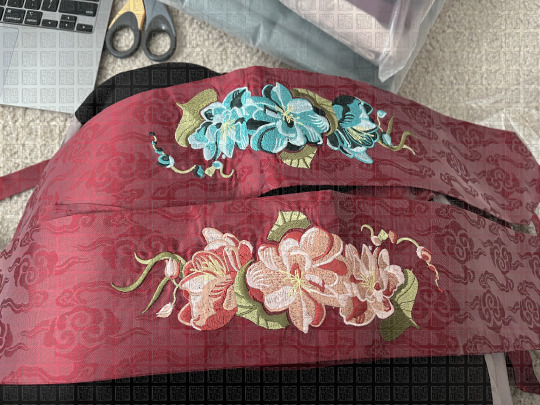
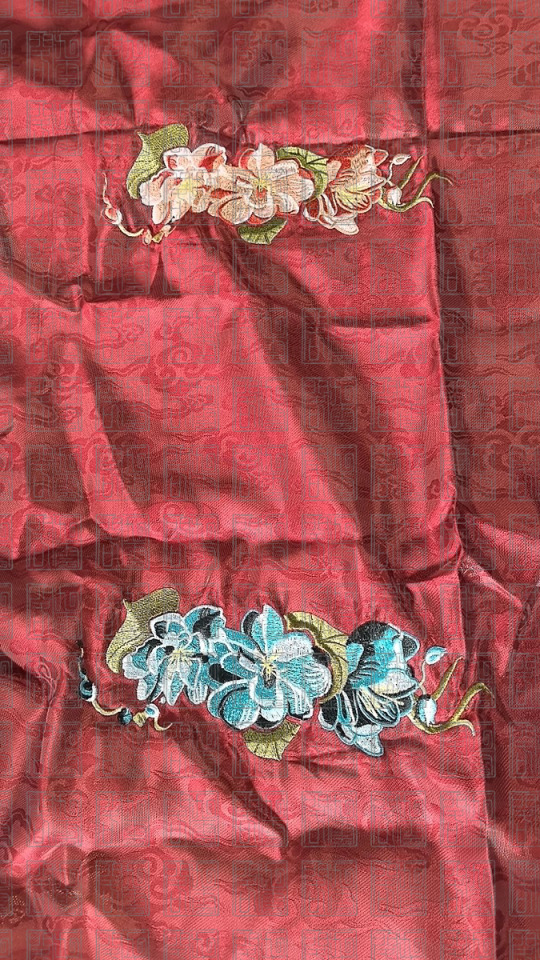
A yaofeng is a wide waist sash or 'corset belt' style thing. A pibo or peizi is a long piece of flowy fabric that acts as a shawl that women carry on their shoulders or elbows. The pibo didn't make it onto the set, but the yaofeng did. Its design is not that interesting (it's an extremely wide hexagon with ribbons sticking out of it to tie on your waist) so I will just let you use your eyes.
-
If you made it this far without your eyes bleeding you're doing better than me! This is the most technical part of the series—not much artsy symbolism going on but a lot of hanfu archaeology work. I am again very tired after writing this and am not sure if some of it is incomprehensible, but feel free to send me asks and stuff about it :) Only one post left to wrap it all together!
1 Introduction & Presentation // 2 Background & Influences // 3 Hair & Makeup // 4 Set Design // 5 Clothes & Accessories // 6 Conclusion
#hanfu#chinese hanfu#chinese fashion#hanfu fashion#hanyuansu#hanfu photoshoot#chinese history#hanfu art#long post#chinese#archaeology#relics#artifacts#northern & southern dynasty#魏晉南北朝#九雲閣#cloud9hanfu#cloud9 hanfu#青白之魅#legend of the white snake#snake#snakes#embroidery#digitizing#poqun#xiyi#褶衣#破裙#museum artifacts#patternmaking
159 notes
·
View notes
Text
青白之魅 1: Introduction & Presentation
1 Introduction & Presentation // 2 Background & Influences // 3 Hair & Makeup // 4 Set Design // 5 Clothes & Accessories // 6 Conclusion
tw snakes i think? yeah if you don't like snakes you might wanna just skip this one
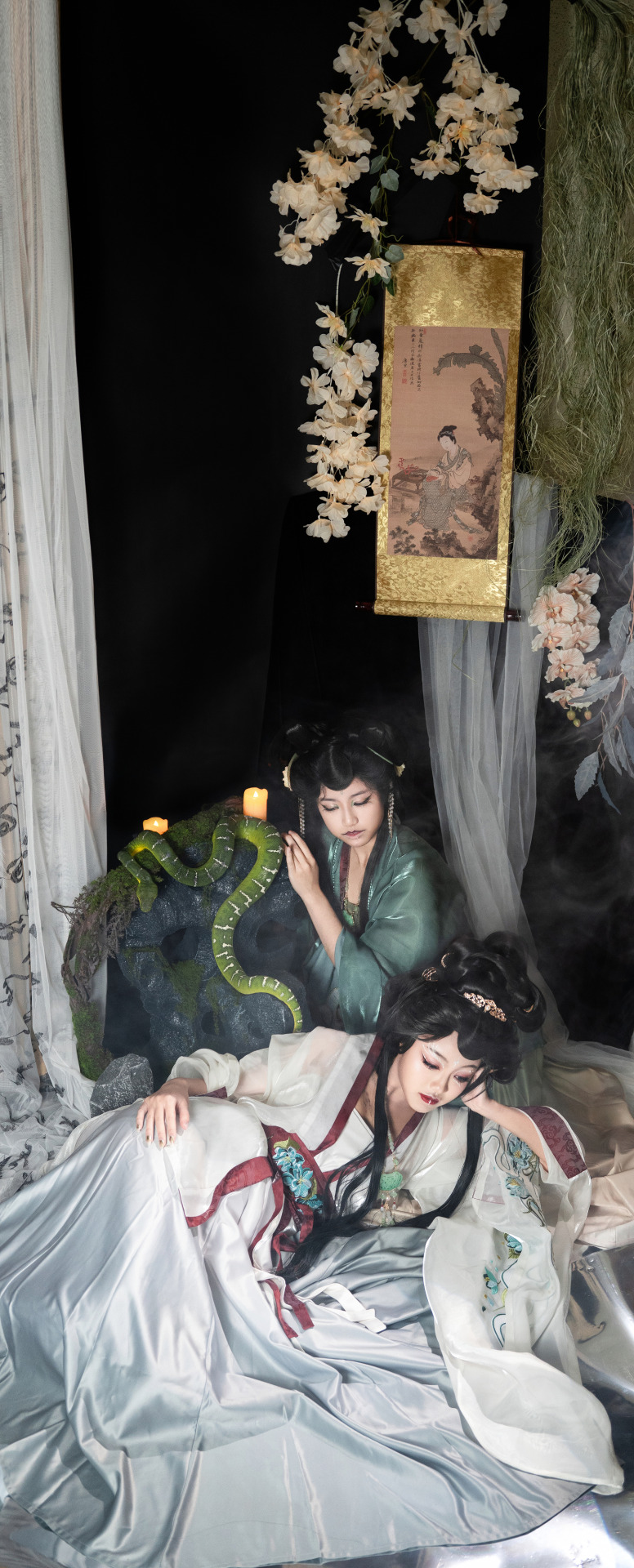
Taking a break from the informational stuff—I would like to present a project that my sister and I (Cloud9 Hanfu) just released on Lunar New Year: 青白之魅!This is a photo project that we've been working on since last summer, with the intention of celebrating the year of the snake, as well as to show the hanfu community that has supported us for so long what they've done for us and what they've made possible :>
I've got a blog now aka a poorly disguised excuse to yap for several hours straight, so I'm going to be documenting the design background and symbolism behind my work on this project through a series of long posts.
This'll be split up into 6 parts, which I'll link as they go up UPDATE they are all up!:
Introduction & Presentation (this post): introducing the project's intentions and the presenting the first set of photos
Background & Influences: going more in-depth about the particular sources and pieces of media that inspired this project
Hair & Makeup: opera references and stylistic choices in the design of the hairstyle for both characters and the makeup of the green snake
Set Design: references to Green Snake (1993), explaining the symbolism in some of the props
Clothes & Accessories: process of designing the clothing, behind-the-scenes sketches, archaeological background
Conclusion: reflection on the whole process + Things I Would've Done If I Had Infinite Money And Time
For those of you who just want to look at pretty pictures and move on with your life—this post is for you! If you want to see all the nerdy guts that went into this thing though, keep an eye out for more ;)))
Even if nobody reads this I'm gonna regard it as an exercise in reflection, or just an act of documentation that I might be able to come back to later on. But if you do read it and like it then yay! :)
青白之魅
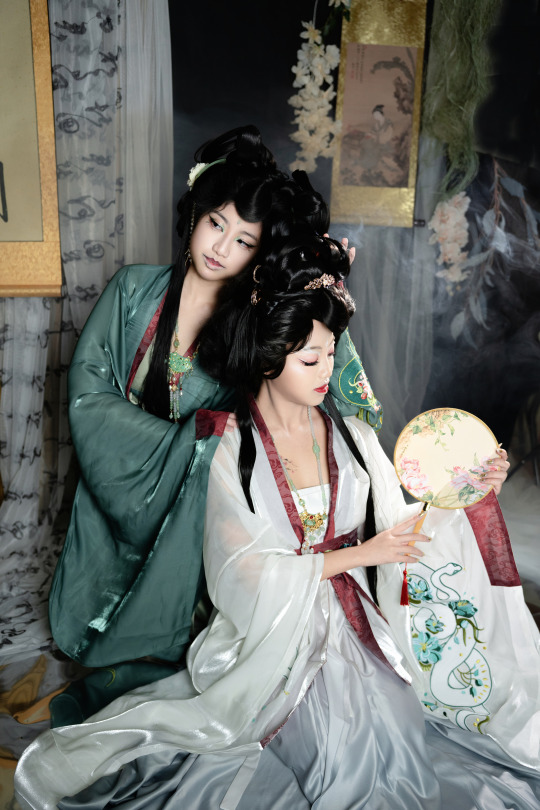
青白之魅/qing1 bai2 zhi1 mei4/'Enthralled by Green & White' is a photo project primarily based on 白蛇傳/白蛇传/bai2 she2 zhuan4/the Legend of the White Snake. It's one of China's Four Great Folktales, one of the most well-known stories in Chinese culture.
It tells the story of two snake spirits who have taken the form of human women, the White Snake and her younger sister the Green Snake. The story is set in Hangzhou, China, and depicts a dramatic romance between the White Snake and a human scholar. We set the focus on the two snake sisters instead of the romance.
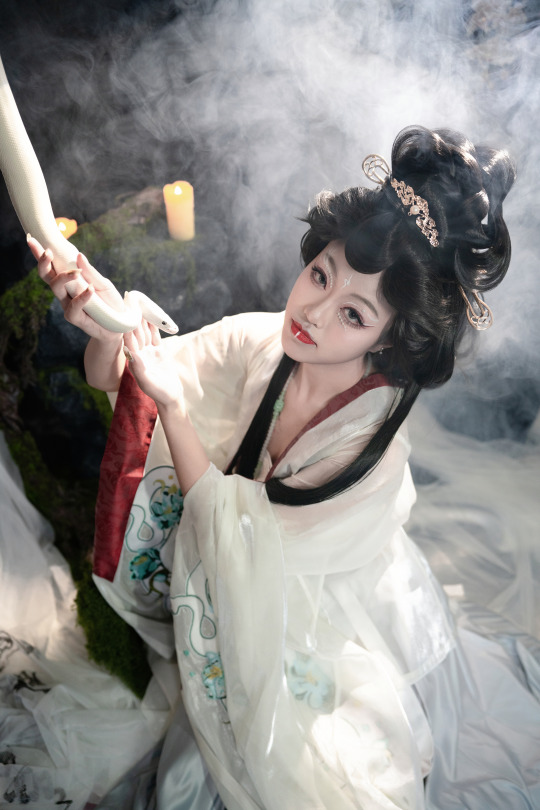
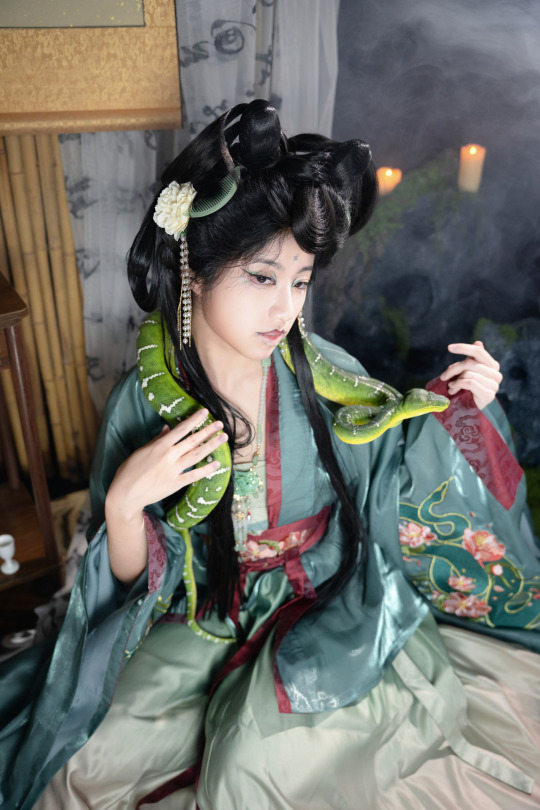
This project features my older sister Yulan and I as the White & Green Snake, respectively. This was a collaboration between three organizations: Cloud9 Hanfu, our brand; Art of Scales, a professional snake handler & ophiologist from Riverside; and Bloomin Studio, a comprehensive photography studio from Santa Ana, CA. None of this could have happened without them!
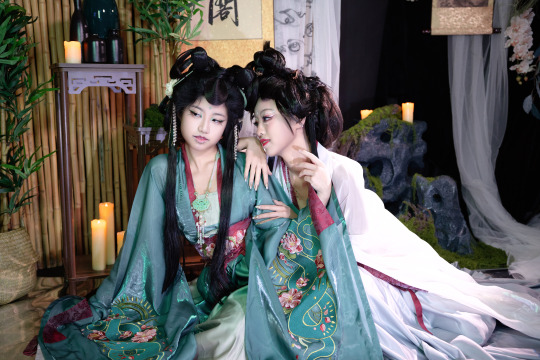
This year is the Year of the Snake. Snakes are often demonized, especially (though definitely not only) in Western culture, and seen as inherently evil or malicious creatures, partly because of the very real danger that some species pose. Like all animals, though, they are simply a part of the natural world—we happen to think they are quite beautiful evidenced by the fact that my sister owns a truly egregious number of pet snakes! We wanted to bring the Legend of the White Snake to life through our hanfu photoshoot with real snakes.
Our photo project aims to show that, much like the public interpretation of snakes, and the Legend of the White Snake, Hanfu is a multifaceted concept—full of rich history, self-contradictions, and a reflection of the people that engage with it. We hope that, similar to the rise of sympathy given to these characters with time, we can reduce fear of the unknown and share the beauty of our culture, our clothing, and (Cujo's) snakes with everyone this year.
青白之魅
白蛇之魅
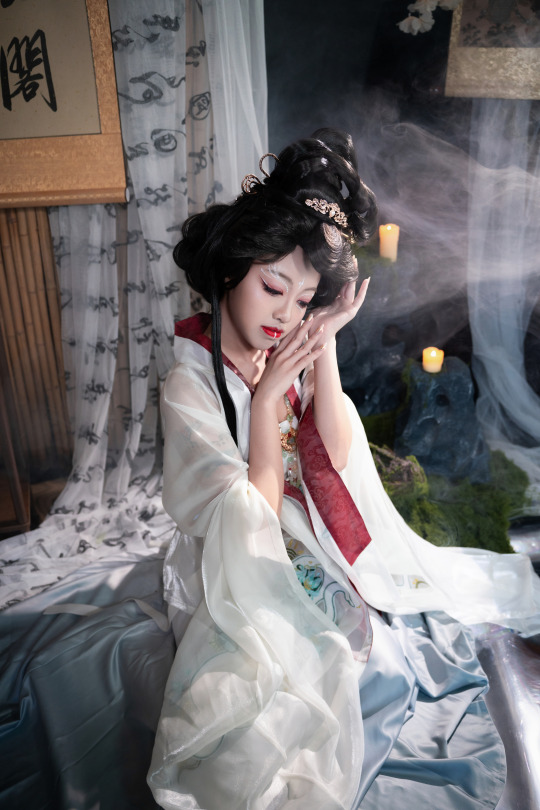
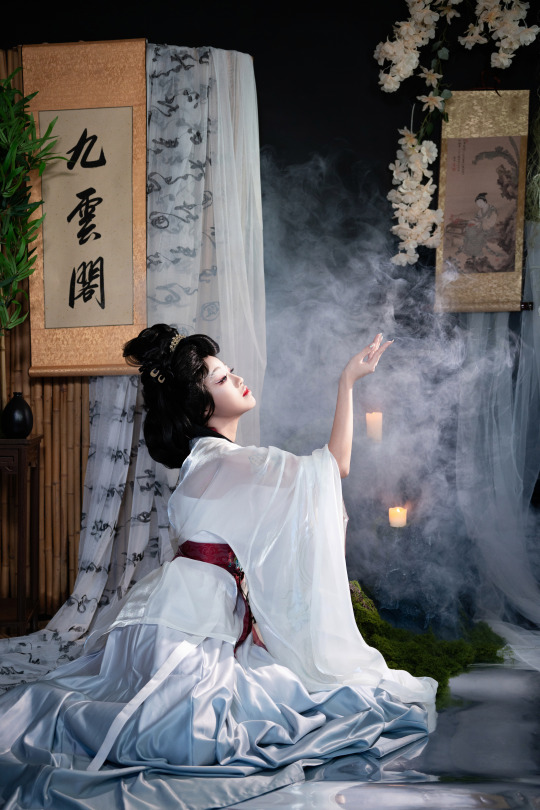
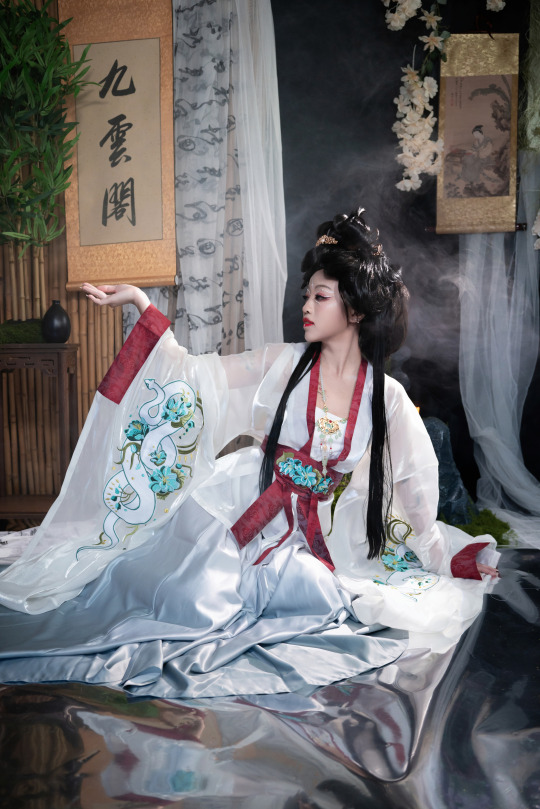
The older White Snake sister is named 白素貞/白素贞/bai2 su4 zhen1/Bai Suzhen. Bai Suzhen, also called 白娘子/bai2 niang2 zi0/Madam White is the main character of the Legend of the White Snake.
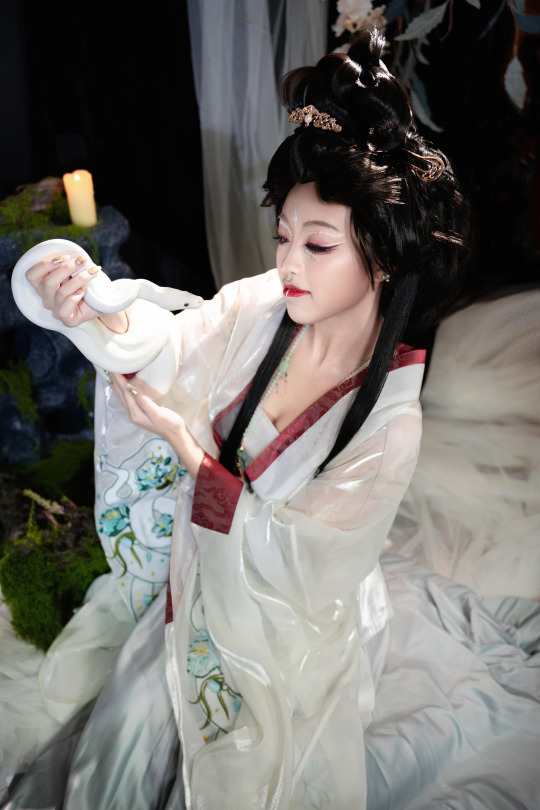
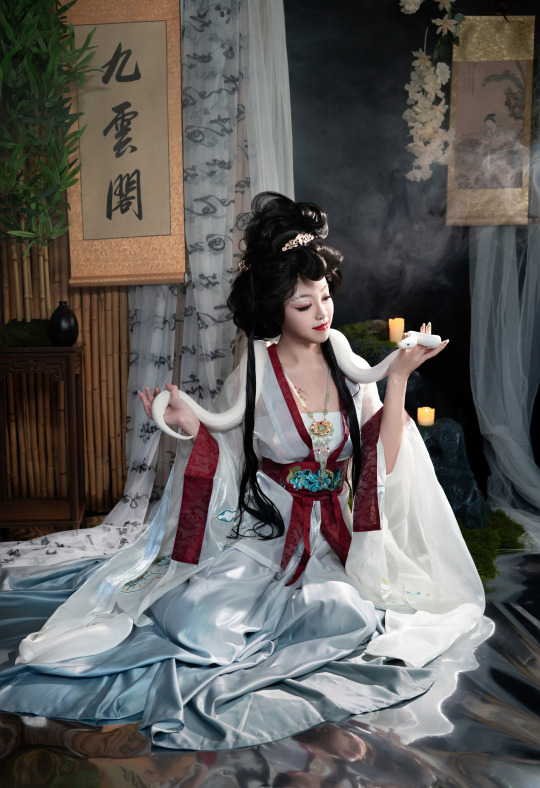
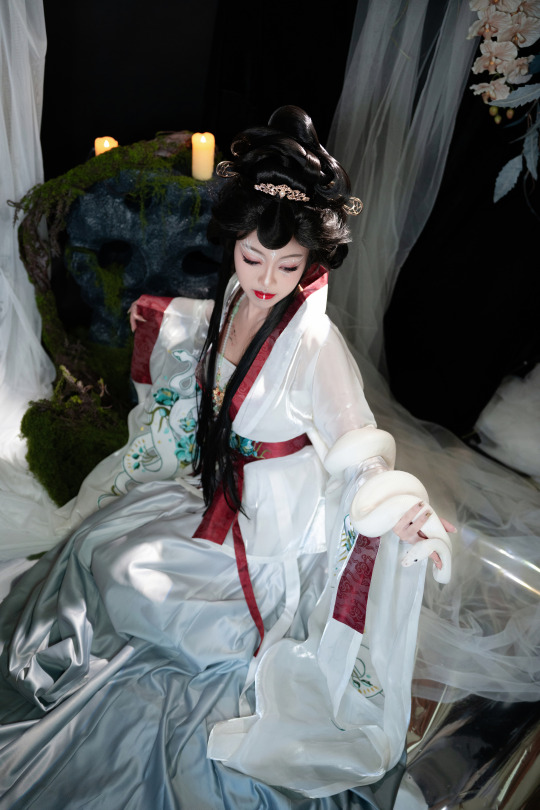
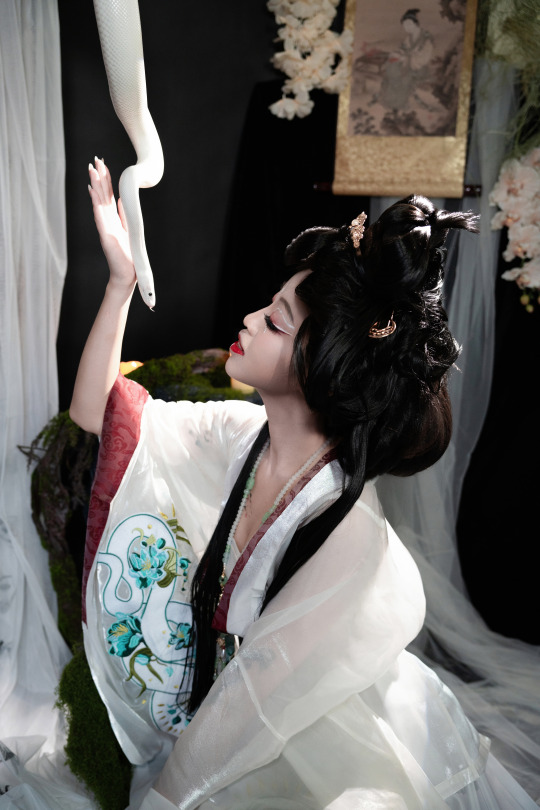
Spirit the blue-eyed lucy represented the White Snake in this shoot! He's a blue-eyed leucistic (<- a highly coveted morph of ball python) ball python/royal python. He was truly one of the most beautiful snakes I've ever seen, an absolute sweetheart and posed like a dream. I applaud his core strength!
青蛇之魅
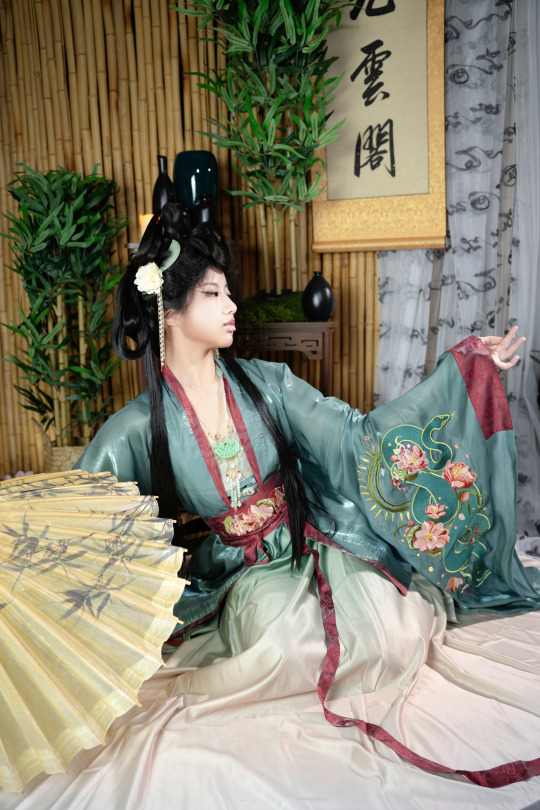
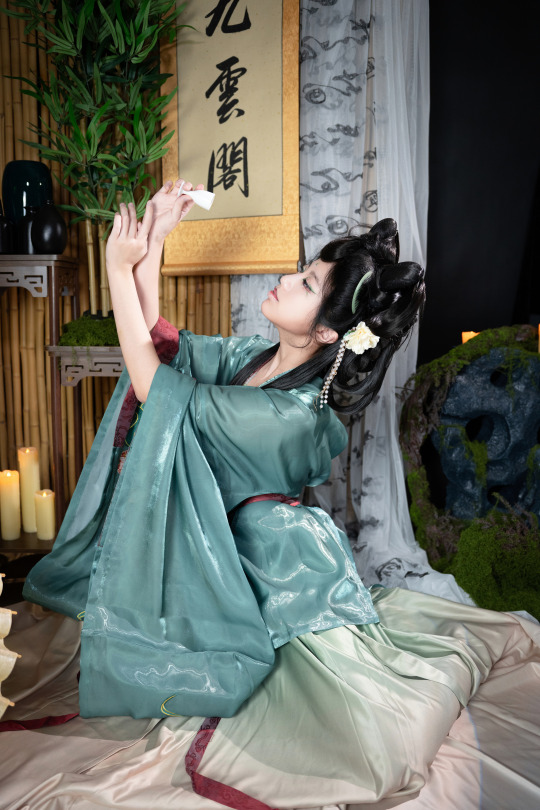
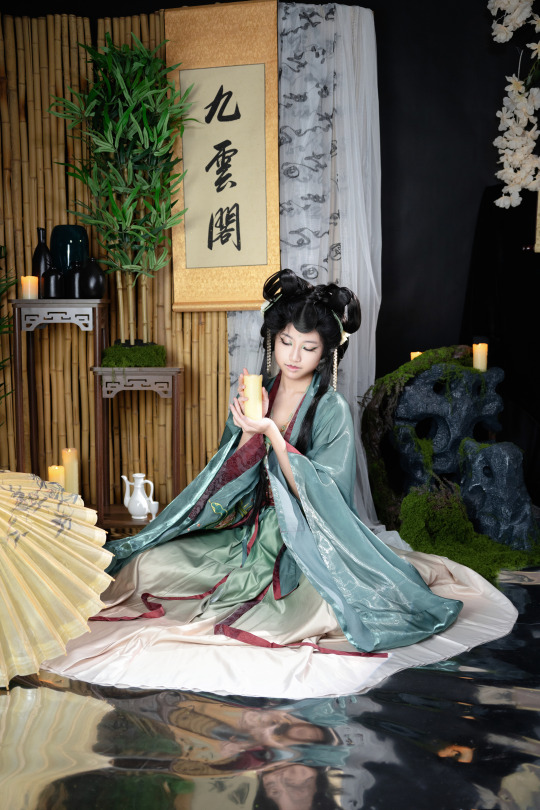
The younger Green Snake sister is named 小青/xiao3 qing1/Xiaoqing. 青 is a color that doesn't translate directly into English—it covers colors ranging across what we might call blue, green, teal, or black (see the grue phenomenon). Green is the translation that most people agree on.
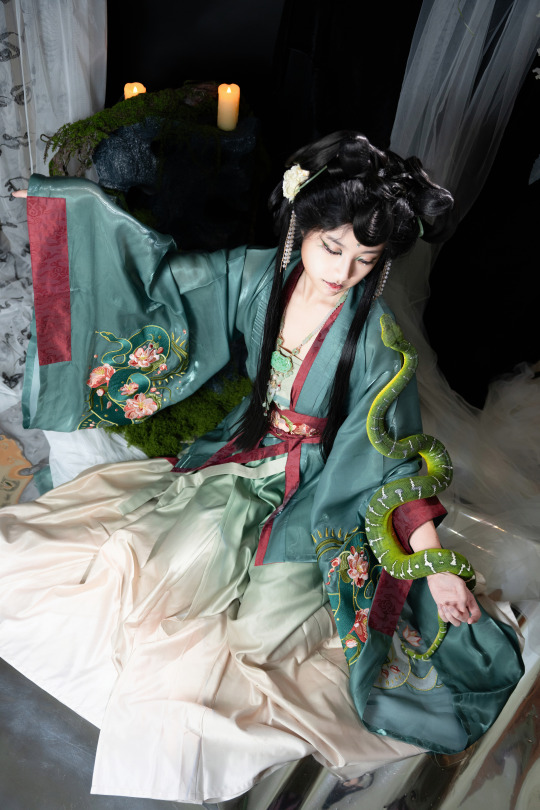
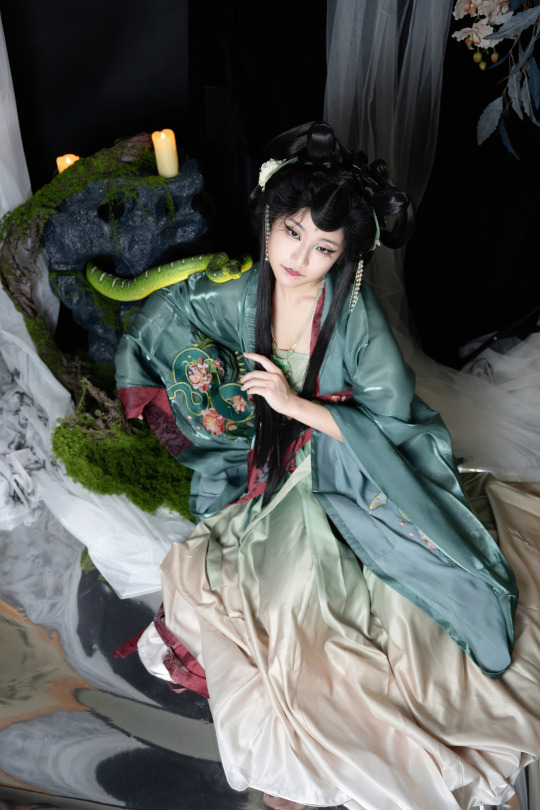
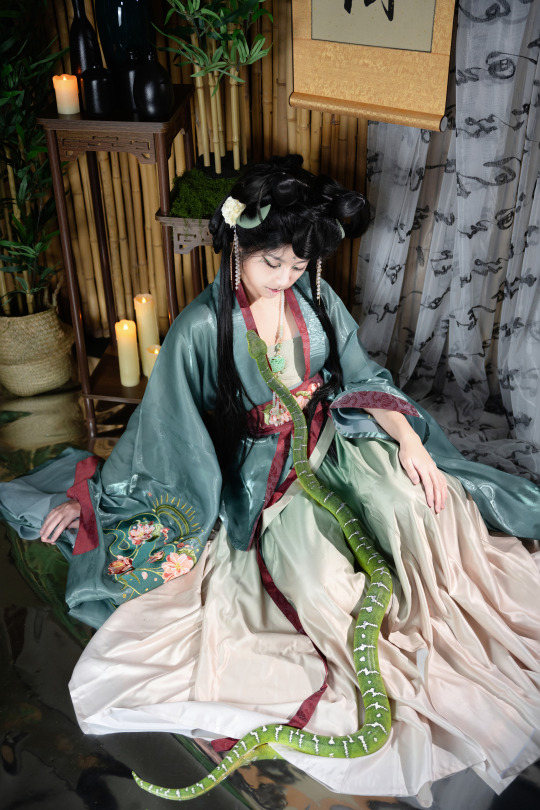
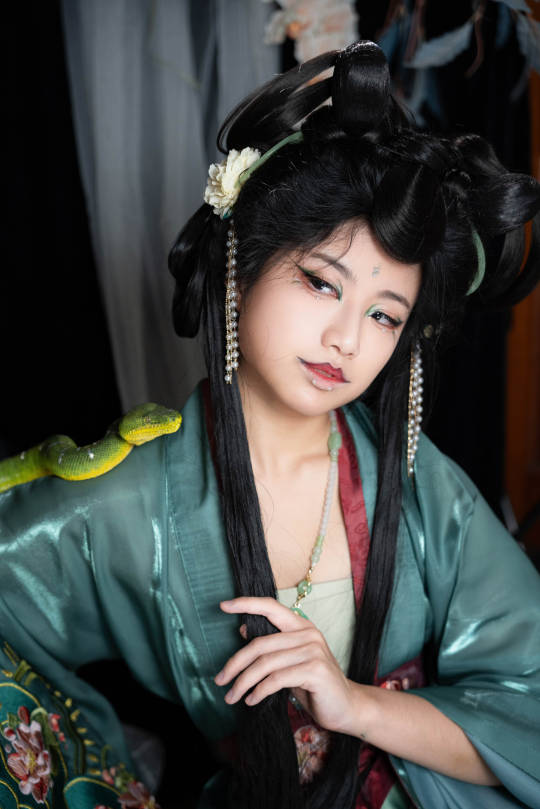
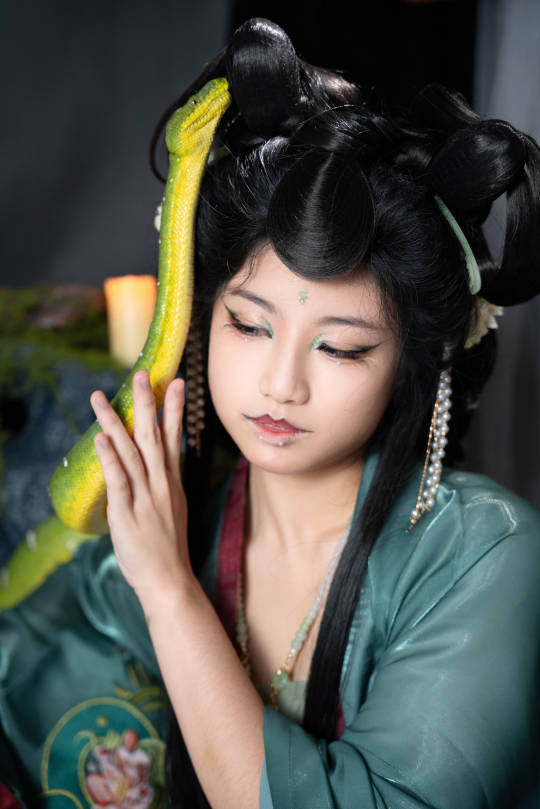
Dragun the emerald tree boa represented the Green Snake in this shoot! He was super calm and chill, even when some of my hair got stuck in his scales (sorry bby :((((), which is saying something for an emerald tree boa (they considered extremely exotic and are usually cranky asf). He has a deviated septum and makes a funny hissing noise when he breathes! It was very calming.
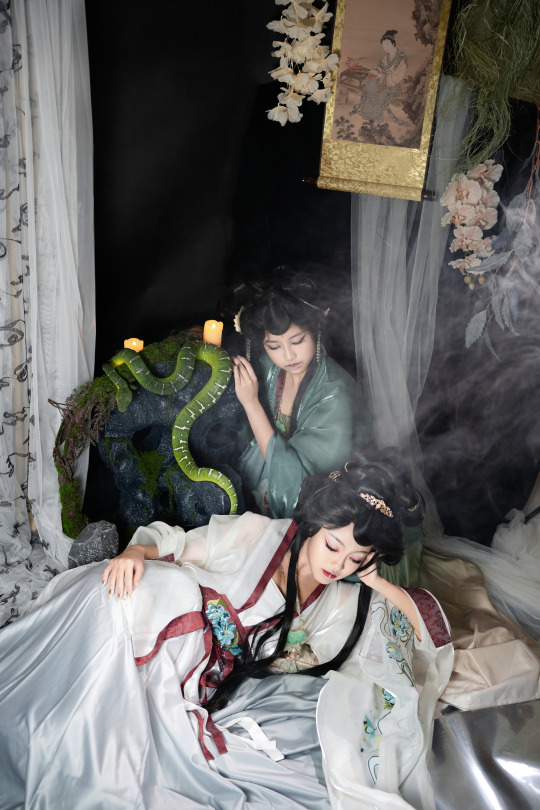
If you actually read this whole post through, congratulations! Feel free to ask if there’s anything you’re curious about that I didn’t cover or doesn’t look like I’m going to cover. (And by ‘feel free’ I mean there’s a little guy in my brain doing his best impression of someone dying from thirst in the desert and only your validation can save him.)
1 Introduction & Presentation // 2 Background & Influences // 3 Hair & Makeup // 4 Set Design // 5 Clothes & Accessories // 6 Conclusion
#hanfu#hanyuansu#chinese hanfu#chinese fashion#chinese history#hanfu fashion#hanfu photoshoot#hanfu art#cloud9 hanfu#cloud9hanfu#九雲閣#photoshoot#project#long post#青白之魅#series#photography#hanfu photography#snake#snakes#legend of the white snake#白蛇傳#white snake#green snake#ball python#royal python#emerald tree boa#northern & southern dynasty#南北朝
100 notes
·
View notes
Text
Hundred-Pacer 百步蛇:Design Background
A lot of people seem to really like the Hundred-Pacer set, so I thought I'd do a detailed post on its design background as if I wasn't gonna do that anyway because I need somewhere to spout the nerd stuff you can't stop me.

The Hundred-Pacer is a two-piece Han Dynasty set consisting of a curved-hem robe 曲裾袍 and a waist piece. There were two main inspirations behind this set: the Mawangdui burial site, and the hundred-pacer snake itself, specifically its veneration by several indigenous groups in southern Taiwan.
馬王堆漢墓 / 马王堆汉墓 / Ma3 Wang2 Dui1 Han4 Mu4 / Mawangdui Han Dynasty Tomb

Hunan Provincial Museum exhibition banner. The artifacts from Mawangdui are regarded as national treasures. They have been on permanent exhibition since 2017.
I did a (questionable in accuracy.........) Newhanfu article on the Mawangdui burial site when I was still active there. It’s one of my favorite Hanfu relic dig sites: I learned about it in my early stages of hanfu research, and it was one of the first archaeological sites that I felt sort of a visceral connection to. People often ask why I like hanfu, and I usually answer with a little anecdote—combing through the records of Hunan Provincial Museum, sifting through page after page of data on decaying silk and wooden carvings, it struck me that those figurines looked oddly familiar—their faces looked just like me.
Anyway, it’s a very famous dig site; most Chinese people have at least heard of it even if they aren’t into hanfu. It’s an eerily remarkable feat of preservation that the contents of the tomb were so complete. I’ll do a separate rewrite of that article later, but for now all you need to know is that the tomb belonged to a ~50-year-old Xinzhui Furen / 辛追夫人 (aka Lady Dai) during the beginning of the Eastern Han Dynasty(西漢 / 西汉 / xi1 han4) in the Changsha Kingdom (長沙國 / 长沙国 / chang2 sha1 guo2), who died of a heart attack in 168-169 BCE, and the clothes she was buried with form the basis of our understanding of Han Dynasty clothing as a whole. A number of very well-preserved straight- and curved- hem robes were excavated with her.

褐色菱紋羅地「信期繡」絲綿袍 / 褐色菱纹罗地“信期绣”丝绵袍 / he4 se4 wen2 luo2 di4 xin4 qi2 xiu4 si1 mian2 pao2 / brown lozenge gauze base Xinqi embroidery silk down robe, excavated from the Mawangdui tomb. One of the most well-preserved curved-hem robes from the burial. Length 150cm, wingspan 250cm, sleeve width 28cm, waist 60cm across. The main material is brown silk gauze (luo) woven in a diamond pattern, embroidered all over in the Xinqi embroidery pattern, padded with silk floss. The trim is brocade and the lining is juan silk. The bottom section is bias-cut but not the top section. Src: Hunan Provincial Museum.
The robes excavated fall into two categories: straight-hem and curved-hem robes. All of them were long and cross-collared. Straight-hem robes are your classic floor-length robes, whose hems sweep the floor evenly. Curved-hem robes, or 曲裾袍 / qv1 jv1 pao2, have a hem that spirals up the lower body from the floor, resulting in a 'curved' hem. The resulting structure is an extra triangular piece extending out from the wearer's side that gets wrapped around the waist area and secured with a belt.
Of the eight curved-hem robes excavated, only two have a double-trim border decoration. The most well-known and the usual standard for recreations is the 褐色菱紋羅地「信期繡」絲綿袍 / brown lozenge gauze base Xinqi embroidery silk down robe. The other is the 絳綛紫色「長壽繡」絲綿袍 / dark purple Changshou embroidery silk down robe, but it's less well-preserved so there's less information out there about it; nevertheless it looks to be constructed very similarly. Both of these robes are padded with silk floss and have an embroidered body, with two different colors of taping along the sleeve cuff, collar, and hem: a darker color comprising of the wide taping directly adjacent to the main body and a lighter color comprising of the narrow taping distal to the main body.

絳綛紫色「長壽繡」絲綿袍 / 绛紫色“长寿绣”丝绵袍 / jiang4 zi3 se4 chang2 shou4 xiu4 si1 mian2 pao2 / dark purple Changshou embroidery silk down robe, excavated from Mawangdui tomb, length 130cm wingspan 232cm. Very similar to the other robe except with a different embroidery pattern on the surface and slightly less well-preserved at the edges. Src: Hunan Provincial Museum.
The curved-hem robe is a type of shenyi robe. Shenyi are defined as long robes whose torso and bottom sections are separately cut & sewn together, rather than just being a shirt/top that happens to be very long. The top half usually follows the same construction as any Hanfu top, whereas the bottom half is usually made up of 4-12 quadrilaterals pieced together to wrap around the waist and legs. Most shenyi will also have decorative trims along the hem and collar.

Structural line drawing of the curved-hem robe. Reposted by 春梅狐狸 (well-known online hanfu author, wrote 华夏衣橱), originally from 长沙马王堆一号汉墓 (official report). Confirmed—corroborated with multiple sources.
Both of the curved-hem robes have a similar shenyi construction, in that we can look at the top and bottom sections separately. The collar is a classic cross-collar (but with a characteristically wide collar piece), cut out in a curved shape. The sleeves are chuihuxiu, ‘drooping’ sleeves, in that they project straight out from the root and then curve upwards at the ends to meet the slightly narrower sleeve cuffs.

The bias grain on a grid representing the fibers that would be woven together to form a piece of fabric. Src: Designer Stitch.
The bottom ‘skirt’ section is made of four bias-cut panels sewn together. 'Bias-cut' refers to the orientation that the pieces are cut out from the full bolt of fabric, in relation to the grain: these panels were positioned so that the fabric grain ran across them diagonally, rather than straight up and down, allowing a non-elastic fabric to soften and stretch (think of a parallelogram being pulled from opposite corners).
This method is a very important feature of the curved-hem robe, because it allows for the bottom section to wrap around the hips and legs much more tightly, resulting in the pronounced, flattering silhouette we see in Han dynasty murals and figurines.

The rearrangement of parallelogram pieces cut out from a pain piece of fabric to extend the length with zero waste. Image reposted by 華服志; I'm not sure where it came from initially but have corroborated with multiple sources that it is accurate.
The trims are also bias-cut, with a no-waste method of extending the length of a strip of fabric by cutting and rearranging parallelogram pieces. I'm sure this has a name, I just don't know what it is. The other robes, gloves, virtually anything that required a long 'strip' of fabric from the tomb employ this same method, simultaneously lengthening and softening the fabric.
Modern recreations will typically follow the same cut & bias as the original pattern while substituting other fabrics. For this set, because of the nature of the trim fabrics and the placement of the design, some parts (especially the narrow trim) were cut traditionally while other parts were bias-cut. The solid body of the skirt section was bias-cut.

彩繪木俑 (Colored Wooden Figurines), Mawangdui #1 Han Tomb, Early Western Han Dynasty ~202BCE—9CE, Src: Hunan Provincial Museum
Additionally, we can also deduce from the depiction of curved-hem robes on figurines that they were floor-length, likely almost dragging on the front. We know that Lady Dai's corpse was about 154cm tall, while her robes were approximately 130-150cm long. Accounting for some shrinkage that likely occurred over time due to water loss, this measurement corroborates the suspected proportions. Both men and women have been depicted wearing curved-hem robes, though later on the majority seem to be women.
Inspiration 1: The Hundred-Pacer & Surrounding Legends

Src: Liu Rui Wei, iNaturalist, Photo 345941307, August 2023, observed near 三星鄉
Looping back around to where the initial idea for this set even came from: When we first started brainstorming for the Year of the Snake collection, one of the first things we decided was that each set would be based on a different species of snake. Yulan, being the ultra biology nerd here, put together a list of visually/culturally interesting snakes for us to start off on. One of those snakes was the Chinese Moccasin or Hundred-Pacer, Deinagkistrodon. I didn't know about its existence before she introduced it to me.

The Hundred-Pacer snake is one of the six great venomous snakes of Taiwan. It's called the Hundred-Pacer because there's a legend that once you've been bitten by one, you'll be dead within a hundred paces. Obviously that's an exaggeration, but the hemotoxin it produces can indeed be fatal. On the flip side, its venom has also ironically been used to make antivenins for a long time.

Src: Shao Qi, iNaturalist, Photo 406124328, July 2024, observed near 新竹
In appearance the hundred-pacer is very striking—the main distinguishing features are its triangular head, sharp pointy snout, and triangular body pattern (diamond-like from above). Lower down, next to the belly, they have a row of small black splotches visible from the side. They're most famous in Taiwan but can be found in many mountainous regions in Southeast Asia and southern China.
Most notably, hundred-pacers are considered sacred to several indigenous groups in southern Taiwan, such as the Paiwan (Paiwan: Kacalisian), Bunun, and Rukai (Rukai: Drekay) people (I was able to find more information on the Paiwan people so most of my research pertains to them). Many of their creation myths have to do with hundred-pacer snakes, and there are several folktales related to hundred-pacer gods. Some consider themselves descendants of hundred-pacers, others say they are protected by them—the Paiwan people call themselves the 'People of the Hundred-Pacer.'



Examples of the hundred-pacer depicted on various items belonging to the Paiwan people. Src: 順益台灣原住民博物館 Shung Ye Museum of Formosan Aborigines, top: scabbard (M015800), bottom left: gunpowder tube (M016100), bottom right: carved figurine (M070000).
In any case, the image of the hundred-pacer appears everywhere—in sculptures, architecture, nobility's clothing (for the Paiwan people, only the noble were permitted to wear the hundred-pacer on their clothing), and infinitely many decorations. It's one of their most prevalent symbols.
From a cultural perspective, this was specifically interesting to me and relevant to the Year of the Snake collection's intent, because it was a counterexample to the theory that snakes are universally considered bad because they are dangerous. Not only do these indigenous groups have an extremely positive view on the snakes, the snakes in question are undeniably very dangerous. To me, this proves that it's possible to have respect for an animal's beauty, not in spite of, but because of its powerful ability to cause damage.
This is already true of a lot of mammalian predators—tigers and lions can certainly be very dangerous, but they're still seen as symbols of strength and power, not met with the same disgust that snakes and similar creepy-crawlies tend to evoke.
Inspiration 2: Taipei Fashion Week

Runway photos from Taipei Fashion Week SS23. The model in the center has hundred-pacers on her arms. Src: The Daily Front Row, "Taipei Fashion Week Returned With A Thought-provoking Theme," 17 October 2022.
Taipei Fashion Week SS23 opened with a show titled “CrossLab: Dialogue Between Indigenous Art and Fashion.” The basic idea was to pair up 5 designers with 5 traditional indigenous craft artisans from various indigenous tribes throughout Taiwan, mixing modern fashion with traditional techniques that are in danger of dying out.
The artisans in question are incredibly well-respected masters of their craft, recognized by the Ministry of Culture as keepers of intangible cultural heritage. Many of them inherited their skills from their families and are now some of the only individuals in the world who still know how to use them. You can read about each designer, artisan, and collaboration in the archives of Taipei Fashion Week's websites. The looks are absolutely GORGEOUS, from the clothing itself to the styling & makeup—like peak couture. I've been obsessed ever since I found out about it.
youtube
I unfortunately do not have the truckload of sponsors and connections necessary to make a collaboration of this scale happen on my own (yet!!!!!!!!), but learning about this event did make me more aware that as cultural artists we have an opportunity to create, explore, and share beyond our comfort zones.
Quick Disclaimer on Culture
While some Taiwanese Han people including myself do have some detectable traces of austronesian blood, for many it’s a percentage so small that it’s virtually negligible. Studies claiming significant overarching genetic difference in the Taiwanese Han population due to indigenous blood have been largely debunked already. While I do claim descent from Taiwanese austronesian ancestors, I am NOT able to claim indigenous culture as my own, as I have not gone through the lived experiences and context required to earn it.
To be clear, my intention is not to claim these cultural aspects, but to share their existence with the world. If this post sparks interest in anyone, I want to acknowledge that my knowledge basically ends here. If you want to learn more I would encourage looking elsewhere (I will put some links at the end) for a more authentic source of information.
Though I did my best to research accurately and respectfully, information on indigenous peoples is often either not available, of dubious accuracy, or hard to access, especially with a language barrier. Also, historical categorization of Taiwanese aborigines has always been really iffy, so there’s some disagreement about terms and descriptions that complicates things. Colonization happened & continued to happen for a very long time and there are still a lot of issues within Taiwan related to the treatment and status of indigenous people. I only hope that I can continue to pay homage to those less-often recognized cultures that played a role, however large or small, in shaping the world that we live in today, and the identities we wear on our bodies.
I hesitated on this set and this post for a very long time because I didn’t want to offend or overstep, but ultimately I went ahead with it because I think that if people always refuse to interact with or learn about something for fear of doing it wrong, then no efforts will ever be made to spread awareness and understanding about new things. To me, my objective to share these cultural concepts is worth the risk of imperfection. I tried my very best and will continue to revise things as I learn, but if I say something inaccurate, misleading or otherwise offensive, please understand that it’s never my intention, and point me in the right direction (nicely please :<).
The Design


As mentioned before, the cut follows the same construction as the Mawangdui curved-hem robes with some modifications—some parts of the trim were not bias-cut because of the positioning and orientation of the printed pattern. However, most of the other parts of the robe follow the original structure.

The fabric making up the body of the robe is velvet chiffon, an ultra-light and soft fabric with the tiniest hint of a pile. It drapes like a dream and the pile gives it the tiniest bit of that sophisticated velvety sheen on the surface—but only a little; it’s closer to chiffon than velvet. To the best of my knowledge, the fibers are polyester. The color chosen is a deep plum purple shade, taken from the second mentioned robe in the Mawangdui section.
An earlier prototype had the robe lined with a cotton fabric, but there were some issues with it: the cotton lining was noticeably thicker than the chiffon surface material, which affected the drape of the robe as a whole. This might’ve been less of a problem if, like the lined robed found in Mawangdui, they were padded with some kind of cotton or silk floss in between, but we didn’t have that, so the separation between the inner and outer layers looked odd. In the end I elected to remove the lining completely—the wrong face of the velvet chiffon was perfectly smooth and comfortable anyway, and this would allow for some flexibility in climate, since the lined version was very hot.

Src: Photo by 齊玉 (@chiyu1024 on ig), modeled by Tangtang—shot January 2025 at Yangmingshan National Park
The trims on the robe feature two printed designs that I drew, both based off of the hundred-pacer’s diamond /triangle pattern. I wanted the wide trim to resemble the actual color scheme and visual texture of the snake’s scales a little more closely, so I used similar grey-brown colors and a scale brush to create mottled, alternating diamond scales.
One of the features that makes the hundred-pacer’s coloring so noticeable is that the delineation between the light and dark parts isn’t just a single switch of colors—on the dark triangles, the color gradually deepens as you get closer to the line; on the light diamonds, the color lightens close to the border. This emphasizes the shade contrast between them and also gives the illusion that the lighter diamond part is ‘floating’ above the triangles, since the super dark parts of the triangles appear like shadows.

Src: Liu Rui Wei, iNaturalist, Photo 315860941, August 2023, observed near 三星鄉
If you’ve ever painted you’ll be very familiar with what I’m talking about; to strengthen the appearance of an edge you increase the contrast on either side of it to ‘lift’ the brighter side and ‘push’ the darker side down. It’s nature’s very convincing imitation of leaves that have fallen on the ground—as obvious as it seems to us, it works extremely well as camouflage when the ground is littered with brown leaves.


The narrow border’s print has slightly different colors: the background is cream, like the snake’s underbelly, and the pattern itself alternates between dark red and purple. It’s more on the geometric side. One side has wide triangles, as the hundred-pacer’s pattern appears from the side, and the other has half-ovals, meant to imitate the round black splotches lining the edge of its belly. There are circles in between them representing the errant black scales that I’ve seen appear on their necks and bellies, and also to even out the overall appearance a little.

Originally I wanted to narrow border to only have the belly splotch pattern, but when the sample was made it looked a bit strange—the splotches ended up being too big in relation to the diamond pattern, and their unevenness was really pronounced, which I didn’t like. I re-designed the pattern to have smaller shapes scattered throughout, which I think was a lot more visually balanced.

That about wraps it up I think! I'm supposed to get edited photos back from my January photoshoot in Yangmingshan National Park by like... next week or so, I'll do a separate post about it with pretty pictures (this post is already long enough >.<)

hey look it me
Addendum—Sources, Resources, and Ways to Support Formosan Indigenous People
Keep in mind that a lot of these sources are gonna be written in traditional Chinese. Some of them have English translation options on their websites though, you just have to look for it/accept that there's probably gonna be some mistranslations.
順益台灣原住民博物館 / Shung Ye Museum of Formosan Aborigines: Located in Shilin District in Taipei, close to the National Palace Museum, museum dedicated to indigenous peoples of Taiwan. If you ever visit Taipei and have the National Palace Museum on your list I’d recommend carving out some time to come here too! Entry is $5 USD with a bunch of discounts for students/elderly/indigenous/disabled/etc. There are four floors (including basement) to explore and tons of permanent/rotating exhibits.
WilDesign Wildman Workshop: One of the indigenous-owned workshops I like. They’re not super duper active but they make just... really cool stuff. I got a necklace from them.
LiMA: A distribution platform dedicated to indigenous people’s handiwork. They have a physical location in Taipei on Yongkang Street that I visited (I was very shy and chickened out of chatting with the staff but it was VERY cool, it's where I found the Wildman necklace I bought). They’re endorsed by the Council of Indigenous Peoples. They have everything from jewelry to makeup to snacks.
DI NI Handmade Workshop: Another indigenous peoples’ workshop. I haven’t been to this one in person but have heard good things. It’s apparently run by a bunch of retired elementary school teachers, and they’ve got a lot of very cute jewelry, purses, pillowcases etc.
Council of Indigenous People: Council of Indigenous people’s webpage on Paiwan people. They have regular news and info coming out. For some reason the link breaks sometimes, idk why, but if it’s not working you can probably google your way there.
Explore the Sun Qadaw : Another organization, also associated with LiMA. They share stuff about crafts, travel, events, food, etc. I think they have an instagram but idk if they're very active there
I found this random article, I can't figure out where it's from but the info seems to check out with all the other sources????? So I guess I'll put this here too?????
National Taiwan Museum of Fine Arts: This is a past event listing but it contains some information in it about the hundred-pacer and its depictions.
Academia Sinica Center for Digital Cultures: Some more depictions of the snake on carvings.
Taiwan Environmental Information Center: Article on the hundred-pacer legends.
#hanfu#chinese hanfu#chinese fashion#hanyuansu#hanfu fashion#hanfu photoshoot#chinese history#hanfu art#chinese#cloud9 hanfu#cloud9hanfu#九雲閣#long post#han dynasty#quju#mawangdui#indigenous culture#taiwan#formosa#paiwan#year of the snake#fashion#historical fashion#indigenous people#payuan#im trying to figure out how to donate money to the shung ye museum but its confusing bc international bank things x-x
68 notes
·
View notes
Text
青白之魅 3: Hair & Makeup Styling
1 Introduction & Presentation // 2 Background & Influences // 3 Hair & Makeup // 4 Set Design // 5 Clothes & Accessories // 6 Conclusion
If you thought there was gonna be less nerd from here on out you are deeply mistaken.
I was responsible for the hair styling for both the white and green snake, which was super fun. I’ve been doing hanfu hair styling for a year or two now (thank you to everyone who let me practice on them!!!) and have gradually gotten better at it, even though I still struggle with some parts of it. I certainly have the equipment collection to show for it now at least! I have so many fake hair pieces I can’t keep track.
As with any hanfu hair styling, the process involved a lot of fake hair, pins, and hairspray—but of course before the actual styling started, which was mostly only on the day of, I had to spend some time thinking about how I wanted the hair to look on each character.

元 衛九鼎 洛神圖, Taiwan National Palace Museum, 她:女性形象與才藝,2020
As far as snake-like hairstyles go, the first thing that comes to mind is the 靈蛇髻/灵蛇髻/ling2 she2 ji4/Spirited Snake hairstyle, shown above on Luoshen, a women’s hairstyle that went through a lot of changes through the dynasties but generally involved a tall, twisting bun leaning slightly to the side on the top of the head, resembling the body of a rearing snake. It’s a very popular style both historically and among hanfu enthusiasts today, because it looks very unique and ethereal. Often, female spirits or goddesses are depicted with this hairstyle.
That was the style I was originally planning on using, but it came with some limitations: one, it’s kind of… in unstable equilibrium? We’d essentially be walking around with the leaning tower of Pisa around on top of our heads. I had to style both of our heads BEFORE setting up the set design, so there was too high of a risk that something would get knocked out of place, since I knew I would have to be running around doing things. Also, because Yulan has brightly colored dyed hair, she had to wear a black base wig under all the fake hair pieces, which is a bit more difficult to pin things to than your actual scalp.
So instead I went with a different design. I knew I still wanted a lot of serpentine loops and strands, and I wanted there to be a significant amount of volume going on—they are ‘spirits’ and ‘goddesses’ after all, they deserve to be fancy!—so I went from there.
The Poetry Vibes
I stumbled upon a few poems last year while looking for names for Cloud9 Hanfu’s Year of the Dragon collection, and a few of them ended up becoming inspirations for this project.
This is the first part of 張可久 (Zhang Kejiu)’s Yuan Dynasty verse, 醉太平·春情 (Drunken Peace · Spring Romance). It’s a bittersweet poem describing a speaker that is longing for a lost love, likening her beauty to the imagery of the evening spring showers outside his home. I’ll do a slightly more faithful line-by-line translation of the poem’s actual words, then a paragraph-form translation with more stylization that gets at the meaning a little more (poetry is really hard to translate).
This is mostly just my interpretation though, and my Classical Chinese is... extremely questionable, so like... take it with a grain of salt.

張可久 Zhang Kejiu, 百度百科
Line-By-Line
烏雲髻鬆,金鳳釵橫。<- “Storm cloud hair is soft and loose, the golden phoenix hairpin is horizontal.”
伯勞飛燕自西東,惱離愁萬種。<- “The shrikes and swallows fly their ways to the West and the East, causing ten thousand kinds of sorrowful goodbyes.”
碧溶溶满溪綠水桃源洞,淡濛濛半窗白月梨雲夢,恨匆匆一簾紅雨杏花風。<- “Jade stream water flows to the Peach Blossom Grotto, moonlight is cast cloudily through the pear blossoms to my half-open window as if through a dream; the wind is unforgiving, felling apricot petals like a red curtain of rain.”
把青春斷送。<- “It ruins the spring.”
Stylized
Storm clouds gather loosely outside my window. I can almost imagine that they are strands of her soft hair; I can almost see where her golden phoenix hairpin would have laid, nestled in her black locks.
It’s springtime now—the orioles should be migrating, flying to their summer homes in the west, and the swallows to the east. Imagining their inevitable parting stirs a complicated sorrow in my chest.
As it storms, clear rainwater collects on the ground in rivulets, streaming away like liquid jade. I wonder where the water is going—is it to some forgotten, untouchable paradise? Is that where she is now? I can see through my half-open window where moonlight drizzles through the petals of the pear-blossom trees, misty and clouded as if I’m dreaming. Suddenly, a curtain of red petals fall across my vision like rain: it’s my flowering apricot tree, struck by the wind.
My trance is broken—spring is over.
//
As Chinese poetry tends to be, it’s very romantic with lots of natural imagery, tinged with sadness. When I reread it with this project in mind, it made me think of Xu Xian after the events of the Legend of the White Snake. While it’s commonly accepted that Bai Suzhen later ends up getting freed and there’s some kind of happy ending, the actual legend itself ends with the White Snake being imprisoned under the Leifeng Pagoda. Many years, if not centuries, pass before she gets out. So as many Chinese romances tend to be, the Legend of the White Snake is, by itself, a great tragedy. I can see the Xu Xian as the speaker of the poem.
Bearing this in mind, I imagine that the beauty of the Snake Spirits are much like the scene described in this poem—soft and ethereal like mist, hiding enough power to bend nature to their will. I decided to lean into the ‘clouds’ theme, especially for Bai Suzhen.

傳 五代 周文矩 仕女圖, Taiwan National Palace Museum, 她:女性形象與才藝,2020 (ft fucked up fat cat)
The comparison of women‘s hairstyles to rainclouds is actually very widespread in Chinese literature, so it was perfect for hairstyle inspiration—in poetry, women are often represented by their features, ex. a poem might say "moth brows" or "cloud hair" to refer to a beautiful lady. Cloud hair and cultivated appearance is integral to the allure of a woman, so much so that the act of putting on makeup can be considered a transformation of identity.
In the linked instance the transformation of identity is supposed to be in the sense of gender identity, but you could also see it (in the context of this project) as the transformation from snakes to women.
This connection is strengthened by another poem, 好事近·夢中作 by 秦觀/Qin Guan from the Song Dynasty.

清宫殿藏画本. 北京: 故宫博物馆出版社. 1994, Wikimedia Commons
Line-By-Line
春路雨添花,花動一山春色。<- “Rain has filled the road with flowers, swaying in the breeze, filling the mountain with the feel of spring.”
行到小溪深處,有黃鸝千百。<- “I walked far along the mountain stream, where there were hundreds and thousands of yellow orioles.”
飛雲當面化龍蛇,夭矯轉空碧。<- “The flying clouds turned into dragons and snakes before me, stretching across the vast jade expanse.”
醉臥古藤陰下,了不知南北。<- “I lay down, drunk in the shade of the vines, not knowing which way is North or South.”
Stylized
I see where the spring showers have filled the mountainside with flowers. They sway in the breeze, bringing with them the rejuvenating scent of spring as I walk deeper and deeper into nature, following the bubbling mountain spring and the crowds of yellow orioles that have come out to celebrate the season as well. As I look up at the sky, I see dragons and snakes form in the midst of the roiling clouds above, leaping and coiling across the expanse of the clear blue sky. Intoxicated, I stop to rest underneath some vines, lost in the beauty of springtime.
//
So I am aware that it kind of sounds like this guy miiiiight be on acid but I'm pretty sure it doesn’t mean he’s hallucinating snakes in the clouds, it’s just like when you look at a cloud and say “that one looks like an elephant!”
Then again there is an interpretation that says his "walking further and further into nature" means he's just getting more and more drunk to escape his problems, so like... make of that what you will. Art is more often than not subjective.
Anyway, dragons also have power over rain and weather, and snakes are often called the ‘little dragon,’ often also associated with flowing water. All this is to say—clouds & coils are good representations of snakes! Also, you’ll notice that both of these poems are about springtime (though the second one is noticeably happier), fitting in with using this project to welcome the Spring Festival :)
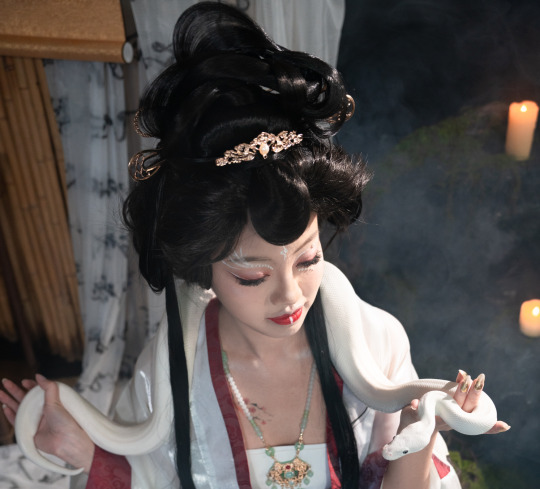
Moving onto individual hairstyles. Keeping in mind the shapes of clouds, I wanted Bai Suzhen’s hair to be very tall, voluminous and ethereal to represent her spiritual prowess and strong will. A bunch of loops fan out at the top center of the hairstyle, adding ‘rays’ pointing outwards like a halo. I made sure there were a lot of round, circular elements to ‘fluff out’ the shape like a cloud. There are two strands of circles kind of peeking out at the bottom behind her neck/ears area, which were achieved by pinning a braid to each side and then pulling the outermost hair strands of each ‘loop’ outwards to create little flat circles.
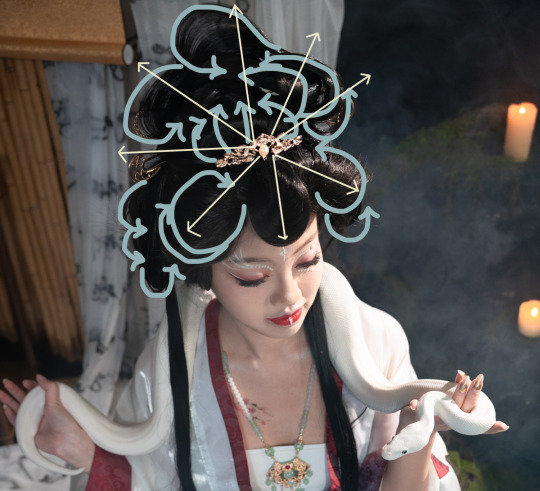
Going back to the first poem, if I imagine that the speaker is Xu Xian thinking of Bai Suzhen, it makes sense for the mentioned ‘gold hairpin’ to appear in her hairstyle, doesn’t it? So I also added a few gold hair accessories—U-shaped pins for the most part, plus a small guan in the center to tie things together—to point outwards above her head.
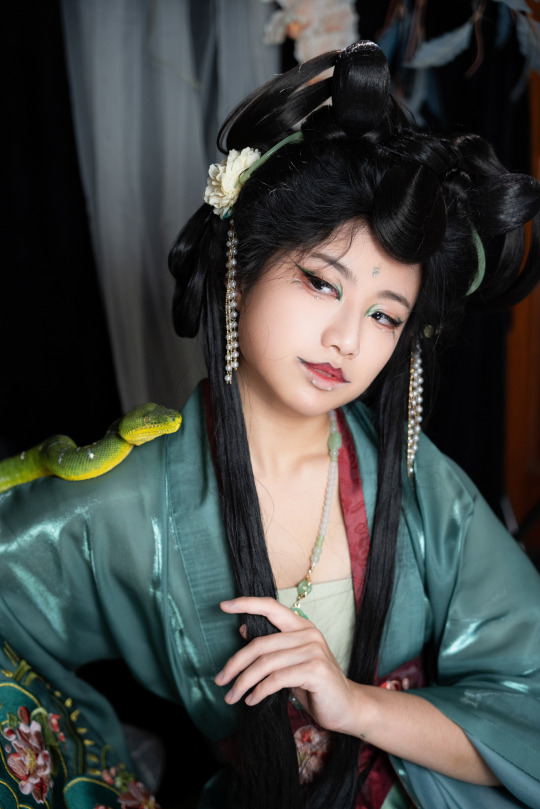
For Xiaoqing's hair, I wanted something that was a little more youthful, but still resplendent enough to do her justice. Xiaoqing is a younger spirit than Bai Suzhen, but still accomplished in her own right. Her hairstyle don’t extend as far outwards as the White Snake’s, but she has two ‘loop’ buns on each side rather than one peak in the middle. It’s kind of evocative of the double bun look often styled on younger girls, but with more fancy loops and swirls added to represent her high spiritual abilities. Each of the two main buns has two strands of hair looping up from the back of the head to the top. The strands are very loose, so depending on how I moved, they separated into several visible strands/just one thicker lock of hair.

The hair accessories I chose for Xiaoqing don’t have as much metal in them, to distinguish her from her sister, as I wanted to emphasize her connection to nature—because she has less experience than Bai Suzhen, she is often portrayed in media (Green Snake 1993 especially) as not yet reaching full human form, still closer to her serpentine origins. She has a white flower with green leaves on each side, standing for spring, youthfulness, and her dedication to the White Snake. There are a couple strands of pearls ‘dripping’ down from the flowers like raindrops, matching with the pearl accessories in the makeup, as well as with the white markings on Dragun’s back.
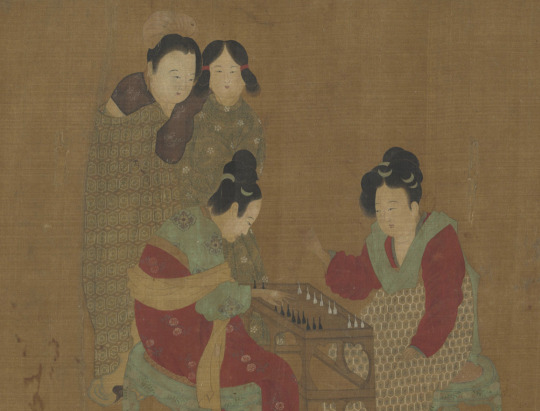
傳 唐 周昉 內人雙陸圖 , Taiwan National Palace Museum, 她:女性形象與才藝,2020
I also chose to include a pair of green half-moon combs, made to imitate jade (they’re acrylic, I’m working on a budget here ;-;). These were often worn several at a time, inserted into different layers of hair (as seen in the image above). Jade accessories are carved from nature—they are often subject to the colorings and properties of the natural base material they are made from, and they are often used to describe natural imagery. This can sometimes be a limitation, but for those who look further it can be an inspiration (see the Jadeite Cabbage, my favorite thing ever, Taiwan Numba One).
Peking Opera Hairstyles
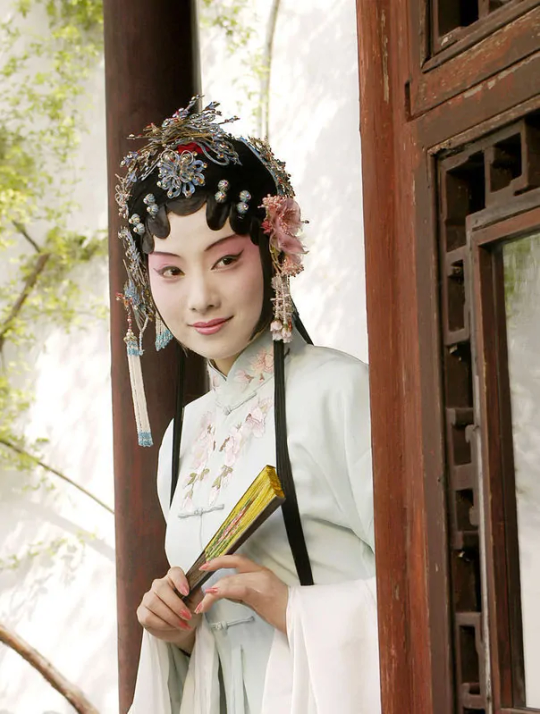
京劇旦角,百度百科
Peking opera influenced the hairstyle design a lot. Dan roles (旦角)in opera have very specific hairstyle protocols. They wear a lot of fake hair pieces and hair accessories just like modern hanfu hairstyles have. One of the base hair silhouettes shared by almost all dan is the traditional 大頭/大头/da4 tou2/'big head,' with most of the hair wound into a large oval bun on the back of the head, and small pieces added at the edges for decoration. To imitate this look, the back of both of the hairstyles are padded with a large, flat, and round hairpiece (known in the hanfu hairstyling community as the 西瓜包/xi1 gua1 bao1/'watermelon bun'). This helps to add volume onto the back of the head, creating the illusion of very long hair that has been neatly wrapped and pinned up.
Another one of the key parts of these hairstyles is the round loop of hair in the center of the forehead. It’s an important feature that I included to tie the two styles together, to make sure it was clear that it was a ‘matched set’ so to speak, and was inspired by the hair loops seen in Chinese Opera styling.

戏曲旦角化妆、梳大头全过程,新浪博客,2011
Traditionally, a solution made from elm tree sap and/or kelp was used as hair gel to glue the little contouring base pieces (貼片子/tie1 pian4 zi0) down to the face. Seven loops called 小灣/小湾/xiao3 wan1/'little curves' line the hairline, one in the center and three off to the sides. I think they look kind of similar to the hairstyle that ballroom dancers have.
This was an artsy hanfu concept shoot, so I didn’t want to necessarily copy the operatic hairstyles—not to mention I don't know how, the motion of making one hair loop alone can take 3-5 years to train—but I did want to include some elements of the opera characters as a nod to their role in popularizing the legend! So each hair design has that central loop. It’s a separate hair piece that I bought for this shoot, whose base I covered with some of the other hair. It isn't glued down like it would be traditionally. I was going to have a few more loops coming down on the sides too, but I found that it looked kind of awkward so I took them off.

There are also two thin strands of hair trailing down each shoulder, another element partially inspired by Chinese opera styling, but it’s very common nowadays to have those there just for the Vibes so it’s not as unique. Most dan roles have a section of long unbound hair trailing down their backs, with two small strands separated out to stream down the front. This is called 線尾/线尾/xian4 yi3/'thread tail' or 線簾/线帘/xian4 lian2/'thread curtain.'
Makeup
Okay so this mostly ended up being about hair rather than makeup because I know a lot more about hair than makeup, but I'll talk a bit about the makeup too lol. I can't speak for the White Snake's makeup—Yulan was in charge of that and she did a marvelous job!—but I did do my own makeup.
The makeup for the green snake came with a great challenge: how do you make my face, arguably the roundest and most nonthreatening thing you’ve ever seen, into something resembling a snake demoness? Also, flamboyant makeup in cool colors can be tricky—too little and it’ll all disappear on camera, too much and it’ll look like a muddy green mess.
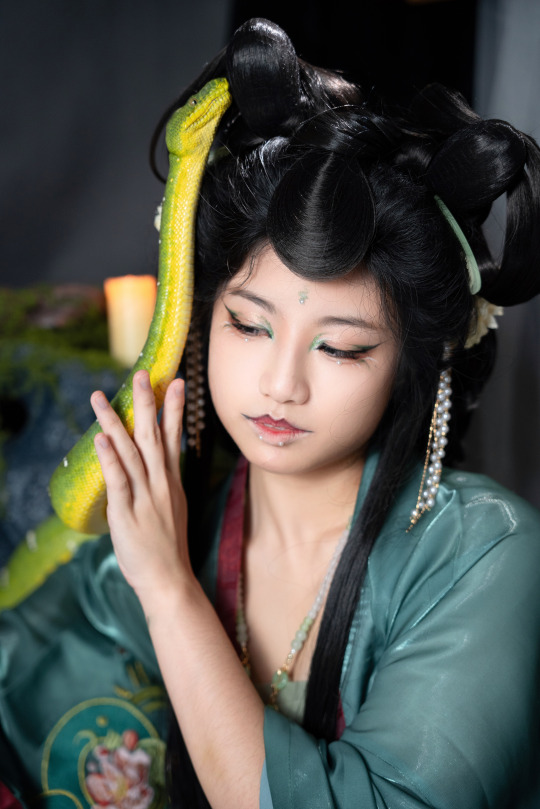
Both my sister and I are fairly warm-toned; green has to be very concentrated in a very small area to look interesting, otherwise it just looks like a bruise (I tried it). So I tried to use a lot of long thin lines of color and angles in the eyeshadow to avoid that, and to kind of draw out the snakey vibes. The meager selection of green eyeshadows that I had weren't the most pigmented, so we made a stop at Sephora (my first time in Sephora believe it or not) on the way from LAX to Riverside and bought some supplies. They turned out to be super super useful.
One of my favorite makeup features was a my sister’s suggestion—fake pearl ‘snake bite’ piercings under the bottom lip! It’s a fun little linguistic easter egg that I’m super happy to have been able to incorporate into her styling.
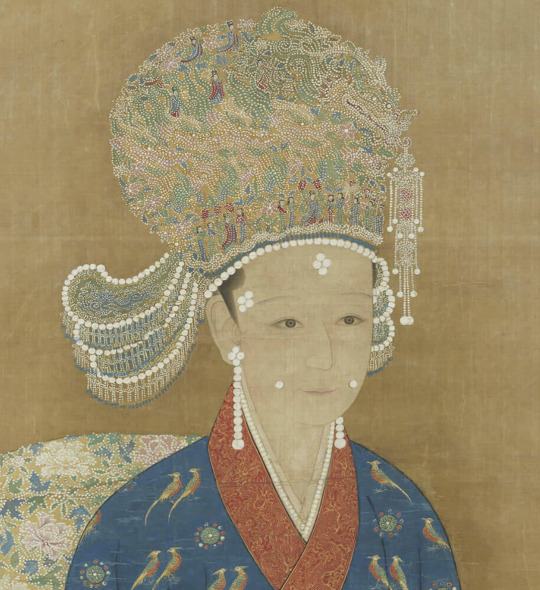
宋人 宋高宗后坐像,Taiwan National Palace Museum, 她:女性形象與才藝,2020 Look closely and you'll see dozens of tiny women depicted in pointillism on her guan headdress!
Pearl makeup (珍珠花鈿/珍珠花钿/zhen1 zhu1 hua1 dian4)was really popular throughout several dynasties, but especially the Song Dynasty, where it became a huge trend among nobles. Today it mostly appears in hanfu circles, but I believe some Southern Chinese opera styles use them too.
As far as I know, the position that we put them in under the bottom lip is anachronistic, but they did often appear at the corners of the mouth/the dimples (面靨/面靥/mian4 ye4), so if you stretched it a little and imagine they've just been moved slightly, I could probably claim that it's at least historically inspired.

元人 畫梅花仕女, Taiwan National Palace Museum, 她:女性形象與才藝,2020
Other places that pearl makeup often appeared was on the temples, cheeks, or forehead. I also put a pair under my eyes just for funsies (I find that using smaller-sized pearls looks better to me, even though the ones shown in paintings are usually fairly large).
//
Okay that ended up being a lot longer than I thought it would be. I am so tired wow. The next one might take a while to come out too, but hope this one was enjoyable :)
1 Introduction & Presentation // 2 Background & Influences // 3 Hair & Makeup // 4 Set Design // 5 Clothes & Accessories // 6 Conclusion
#hanfu#hanyuansu#chinese hanfu#chinese fashion#chinese history#hanfu fashion#hanfu photoshoot#hanfu art#long post#like really really long post#hanfu makeup#makeup#chinese makeup#hanfu hairstyle#hanfu hair#青白之魅#cloud9 hanfu#cloud9hanfu#九雲閣#snake#snakes#洛神#chinese opera#peking opera
91 notes
·
View notes
Note
do the ru/ao also have the centre seam? I don't seem to notice them. and if not, what did the patterns look like?
Hi!!! Yes, ALL ru/ao have center seams, front and back. Here are some examples.
This is a 交領襦/交领襦/jiao1 ling3 ru2/cross-collar Ru top. On the left, the center-front seam is highlighted in red, while the center-back seam (seen through the inside of the top) is highlighted in green.


And this is with the top 'open,' so you can see more of the inside center back seam.


This is a 合領襖/合领袄/he2 ling3 ao3/parallel collar Ao lined top. The center-front seam is open because it's parallel collar, but you can still see the center back seam from the inside.


And from the back:


I know it's kind of hard to see, but it's there!
57 notes
·
View notes
Text
青白之魅 4: Set Design
1 Introduction & Presentation // 2 Background & Influences // 3 Hair & Makeup // 4 Set Design // 5 Clothes & Accessories // 6 Conclusion
I read yalls tags obsessively when you reblog these and they're so cute, tysm they are very encouraging :>

Thank you Bloomin Studio for this shot of the set before getting started!
The set took a lot of inspiration from Green Snake (1993). We set this up in Cujo’s living room, which was already equipped with a wide black backdrop and some lighting. Bloomin Studio was kind enough to bring their Chinese style side table, foam rock, smoke machine, and additional lighting.
In the movie, when the two sisters take human form and join human society, they create a full-blown mansion in an empty, desolate area using magic. When trying to reveal to Xu Xian the true nature of his wife, Fahai the monk calls the house an illusion, but it served its purpose as their home, so is it really “fake?” Who decides whether something is “real” or not, and how? This is part of the reason I wanted to construct the set from scratch, in someone’s living room—the idea that we could make something beautiful and complex happen in an unlikely place.
(Unfortunately I do not have centuries of spiritual cultivation under my belt, so I had to buy things and set them up like a mortal.)

Behind the scenes, with Cujo handling Spirit, who's wound around Yulan's forearm :>
Bamboo

Green Snake (1993) screenshot, 10:25
The opening scenes of Green Snake (1993) take place in a bamboo forest. In an important foreshadowing, the monk Fahai chases a spider demon in human form through a bamboo forest. The spider demon has cultivated for two centuries—180 years longer than Fahai himself—in an effort to reincarnate, but Fahai takes his power away and traps him in a pot, because it goes against the natural order for a demon to take human form.
He goes on to attack the snake sisters, who are still in snake form, before he realizes that there is a pregnant woman giving birth in the forest, and the snakes are simply shielding her from the rain. This scene alone sets up the rest of the movie to question, what are the limits to what we consider human? What happens when we stop considering someone as human, and how far will someone go to be considered human? I find that these questions are very relevant to the world today, especially in the US right now.
In addition to being a vital building material throughout East Asia for the past, present, and future, bamboo holds significant cultural value as a plant that is thin and flexible, yet stronger than many brittle materials. It's one of the Four Gentlemen, representing the virtues an upstanding person should have—ideally, a well-read gentleman should be open-minded and flexible, yet enduring, just like bamboo.

梅蘭竹菊,���少昂,1985,香港商報副刊 March 2022
Each plant of the Four Gentlemen represents a season. Bamboo represents the summer. Summer is the season during which the Dragon Boat Festival happens, a holiday also associated with snakes—the reveal of Bai Suzhen's snake form to Xu Xian happens during that festival, when they drink realgar wine (arsenic wine... controversial to say the least) to honor tradition, which is poisonous to snakes (possibly to people too??? who knows honestly).

In Green Snake (1993), Xiaoqing is the only one affected by the realgar wine because Bai Suzhen's cultivation is high enough that it's harmless to her.
We bought two pots of faux bamboo for our set. They’re a little questionable up close, but they look pretty realistic as part of the backdrop. Unfortunately real bamboo grows like nobody's business and comes with just... a whole host of problems that we weren't prepared to deal with during a one-day shoot, so we had to use artificial alternatives. Thankfully, Cujo (the super cool Snake Guy running Art of Scales) said he'd be able to use them, so they definitely didn't go to waste after the shoot :)
The bamboo came in not-so-pretty black plastic pots with a brick inside as a weight, so I brought a big semi-collapsible woven bamboo (bamboo squared! hahaha) basket, and stuck one of the plastic pots inside. It looked SO much better once you couldn't see the black plastic.
We also used Cujo’s bamboo screen as a structural layering piece. Dried bamboo was and still is one of the most common building materials you'd see in Asia, so the bamboo screen was perfect, not to mention it saved us the trouble of having to fly one down to SoCal since it was already there. It's made of a bunch of bamboo stalks tied together and can roll/unroll. Huge thanks to Cujo and also Kevin for fiddling with its shape to make it stand up on its own, that thing was heavy!
Water

Green Snake (1993) screenshot, 00:38
Snakes are traditionally associated with creation (Fuxi & Nuwa) and the element of water. Green Snake (1993) opens and ends with the visual of running water, with many important scenes taking place on a canal or by a lake. The original Legend of the White Snake is said to have taken place by the 西湖/xi1 hu2/West Lake in Hangzhou—the bridge on which Xu Xian and Bai Suzhen are said to have met is still there, and a popular attraction.
In the Peking Opera, Bai Suzhen refers to the lake several times as a symbol of the constance of nature: as conflict rises around her, she remarks on how similar the lake looks to that one day all those years ago when she first took human form and met Xu Xian.
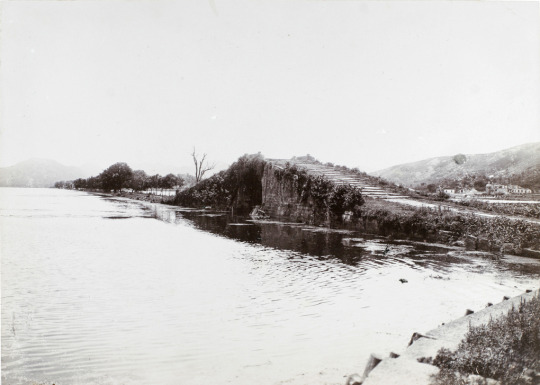
斷橋殘雪, Armstrong, William Collection, Historical Photographs of China, 1908-1910
To create the look of reflective water, we used Mylar mirror paper. It's a favorite of indoor photoshoots, especially in the Hanfu world—probably like 80% of hanfu studio photoshoots use it. The paper is super reflective and comes in a roll so that it can be spread out over the floor of the set, making it look like we’re lying on the surface of a peaceful lake.
Fabric
Green Snake 1993 diverges from the original legend a bit. There's an earlier scene where Xu Xian accidentally sees Xiaoqing's snake tail while the sisters are bathing and runs off in terror. In an attempt to hide themselves, the sisters hang up green silk, and tell him (when he comes back) that what he simply mistook fabric from their laundry flying in the wind as a snake tail (somehow this works, as male characters in Chinese stories tend to be dumb as hell).

Green Snake (1993) screenshot, 48:25
We bought copious amounts of misty white tulle to hang off the bamboo screen and trail across the mirror paper ground. It looked a lot like fog or the foam at the bottom of a waterfall, and it also helped cover the backdrop stand on the right. They were not silk, because once again We Had A Budget, but one of the pieces of fabric was printed with calligraphy, which was a nice touch.
Scrolls
We used two scrolls in this set: one is our standard 九雲閣 calligraphy scroll (that’s Cloud9 Pavilion in Chinese, jiu3 yun2 ge2) just as a fun little branding thing, and the other is a silk-mounted print of the 紅葉題詩仕女圖/红叶题诗仕女图/hong2 ye4 ti2 shi1 shi4 nv3 tu2/'Lady Inscribing Poetry on Red Leaves' by 唐伯虎 (Tang Bohu).

红叶题诗仕女图, 书法欣赏,February 2017
Writing poems on red leaves has a fair amount of symbolism behind it. 紅葉題詩—the image of a woman writing a poem on a red leaf—is a common trope in literature and Chinese paintings, and lots of poems and art pieces depict the same thing. There are a variety of stories associated with the action, mostly having to do with Tang Dynasty palace ladies under the rule of 唐玄宗 (Emperor Xuanzong), who only had eyes for 楊貴妃/杨贵妃 (Yang Guifei). One sadder version tells the story of the other neglected palace ladies writing poems expressing their yearning for freedom on red leaves and dropping them into the river, hoping that the current will carry them out of the Shangyang palace that they were not allowed to leave. Another category is a little cuter, describing chance meetings between lovers—people finding throwaway poems on red leaves and then later getting together, that sort of thing.

明 陈洪绶《题诗红叶图》, Sohu 2020 (another painting of the same trope)
I didn't really look into the story behind the painting until after the shoot, but I can see sort of a connection between the intent of this shoot and some elements of the stories described. Stories about the neglected palace ladies—who are said to have entered the palace at 16 and left at 60 (上陽白髮人, 白居易 Bai Juyi), never having seen the emperor's face once—are usually grievances against the emperor's favoritism of Yang Guifei, which is by extension a criticism of the emperor's rule (the decline of the Tang Dynasty's golden age happened under this guy so he gets a lot of shit for causing it).
I draw this back to the question of what it means to be seen as human—were the thousands of frankly unnecessary palace ladies seen as human in Xuanzong's eyes? What happens when someone is so 'high up,' whether politically or spiritually or whatever, that they cease to view other people as equally human? Should a system be upheld when it no longer serves its function in a changing environment?

Zhang Guo Having an Audience with Emperor Tang Xuangzong (張果见明皇), Wikimedia Commons, Yale University Press 2002
When I picked the painting, though, I didn't really consider all this; I mostly wanted to have a painting of a woman (common subject matter trope for painters, called 仕女圖/仕女图/shi4 nv3 tu2/'palace maid image', somewhere in the background. The Legend of the White Snake deals in the contrast of form versus essence, Green Snake (1993) even more so. The snake sisters take the form of women; does that make them women?
Fahai certainly didn't think so, until the end of the film, when he sees that Bai Suzhen has given birth to a healthy baby boy. There's a moment of cognitive dissonance—Fahai realizes that maybe Bai Suzhen really did become human by virtue of living and experiencing humanness. (To what extent does experience dictate identity, versus origin?) If she really became human, then Fahai has spent the better part of the entire movie killing a human, which is entirely opposite from when he thought he was acting righteously to uphold the natural order. He can't say that his actions were justified because he had good intentions—if good intentions trumped effect, then Bai Suzhen must be virtuous because her intentions were also innocent. This was a fascinating realization at the end of the movie.

Yulan as Bai Suzhen with lots of smoke in the background
I especially like this photo of Yulan as the White Snake (because I can get all Art Analysis with it). She's lying on the ground, reaching up towards the painting, like the woman illustrated on the scroll is the goal she is trying to reach. There's smoky haze in the background, and her hand is pinched in a lotus position, as if she is trying to catch the mist in her fingertips. Most notably, the position of her body hides the snake embroidery on her sleeve, but you can still see the tiniest hint of it through the sheer fabric.
Does the fact that she sees the form of a woman as her goal make her less of a woman, or does it actually validate her identity as one? (didn't mean it as a trans allegory when I started it but I guess it is now lol)
Umbrella
We got a grand total of like three shots with our oil paper umbrella, partially because we've had that thing for years and its opening mechanism is lowkey broken so it was really hard to get good poses with it. I'm glad we got at least one good picture with it though—it's a real oil paper umbrella that's waterproof and hand-threaded (even though the braking mechanism sheared off a while ago so it won't stay open unless you hold it there).

If my hand was not holding the umbrella up it would collapse :/
Xu Xian and Bai Suzhen meet in a scene known as 借傘/借伞/jie4 san3/'Borrowing the Umbrella," where Xu Xian lends Bai Suzhen his umbrella when it starts raining while they're on a boat. Bai Suzhen rejects it, saying she can't possibly take the umbrella from him (since he'd get wet), and sends Xiaoqing to give the umbrella back to him. They go back and forth like this until Xiaoqing takes both their hands and has them share the umbrella. When the sisters have to leave, Xu Xian lets them take the umbrella with them so they don't get rained on on the way back home—a clever flirtation setting up another chance to meet, since he has to go retrieve the umbrella from their home.
Other Stuff I Got That Doesn't Have Specific Symbolism:
Fake moss—looked very realistic! Clung to absolutely everything though, I still find it on my socks sometimes.
Various vases—went for dark-colored or greenish vases, some off Amazon and some from China. You'll notice that they're all empty, because they kept tipping over when I put fake flowers in them ;-;
Candles—these were Cujo's, shoutout to him running out the morning of to get new batteries for them! Super atmospheric :D
Fake rock & smoke machine—very popular for hanfu photoshoots, but not practical to get for one-time use, so we asked Bloomin Studio if they could bring theirs. They have lots of experience in producing and set design!
Fake flowers—I got SO MANY fake flowers and ended up using like. 3 branches of them ;-; Thankfully was able to gift most of those to Art of Scales & Bloomin Studio so I didn't have to cart them back up to NorCal.
Yeah ngl I used maybe like 60% of the stuff I bought for this shoot. In my defense I was buying props for like a good 3-4 months before it actually happened and retail therapy is Important to me.

Here is another behind the scenes shot :)
-
Okay this one was a bit shorter, partially because there were a lot of elements that I wanted to include that I unfortunately didn't end up having enough time to set up. I'll recap those on post 6. I am tired but I hope this was interesting :)
1 Introduction & Presentation // 2 Background & Influences // 3 Hair & Makeup // 4 Set Design // 5 Clothes & Accessories // 6 Conclusion
#hanfu#chinese fashion#chinese hanfu#hanyuansu#hanfu fashion#hanfu photoshoot#chinese history#hanfu art#chinese#long post#behind the scenes#set design#legend of the white snake#cloud9 hanfu#cloud9hanfu#九雲閣#青白之魅#snek#snakes#snake#photography#photoshoot#hanfu photography#chinese art#green snake#tsui hark#tang bohu
25 notes
·
View notes